ARRIS SBG940-1 Wireless Cable Modem Gateway User Manual SBG940User
ARRIS Group, Inc. Wireless Cable Modem Gateway SBG940User
ARRIS >
Contents
- 1. User Manual Part 1
- 2. User Manual Part 2
User Manual Part 2
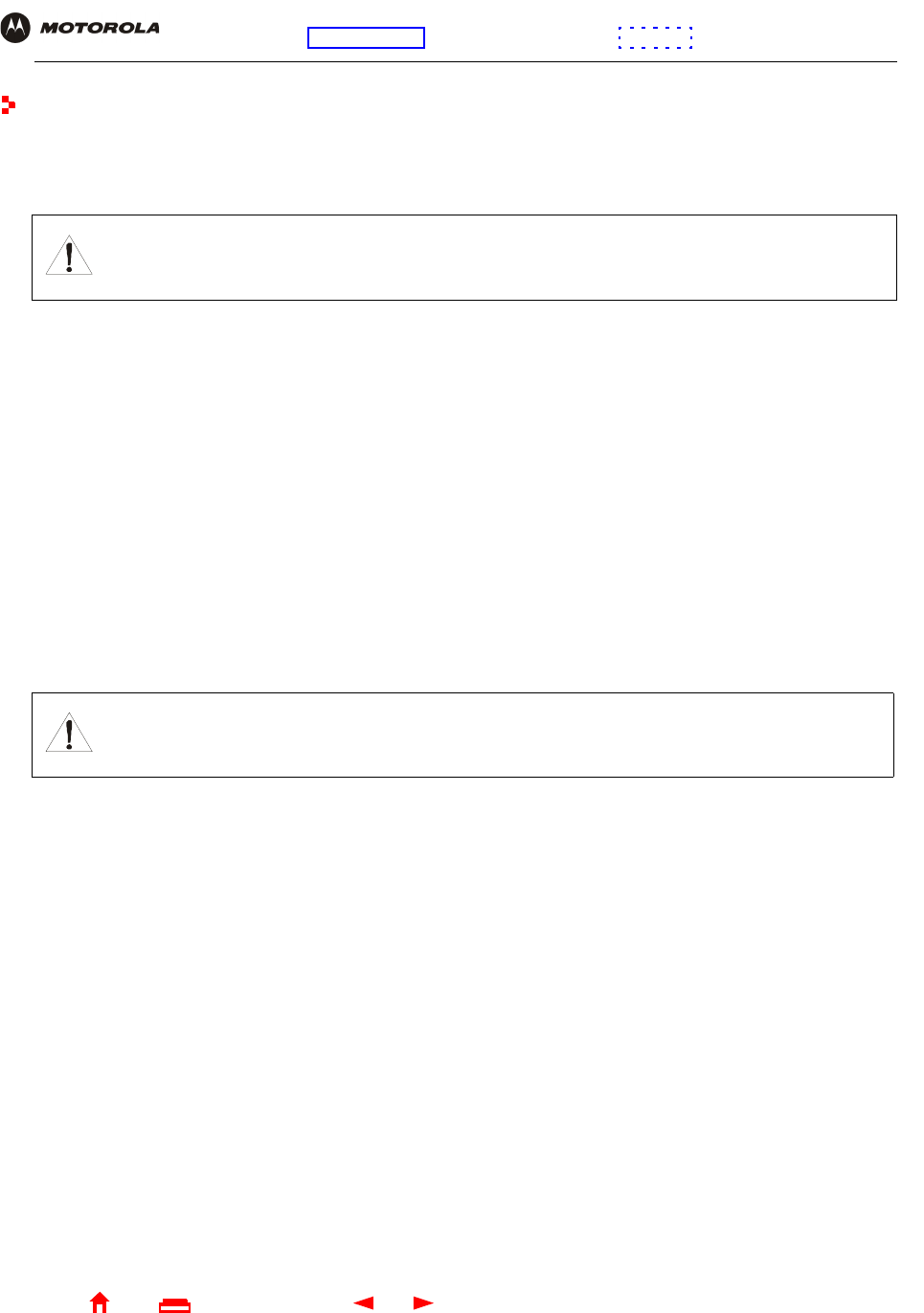
66 SBG940 User Guide
Home
X
ExitPrint
Overview Installation Troubleshooting Contact FAQ Specifications Glossary License
Configuration: Basic Gateway TCP/IP Wireless USB
Setting Up Your Wireless LAN
You can use the SBG940 as an access point for a wireless LAN (WLAN) without changing its default settings.
To enable security for your WLAN, you can do the following on the SBG940:
Connect at least one computer to the SBG940 Ethernet or USB port to perform configuration. Do not attempt to
configure the SBG940 over a wireless connection.
You need to configure each wireless client (station) to access the SBG940 LAN as described in “Configuring the
Wireless Clients”.
For descriptions of all wireless configuration fields, see “Configuring a Wireless Client with the Network Name
(ESSID)”.
Another common-sense step to improve wireless security is to place wireless components away from windows.
This decreases the signal strength outside the intended area.
Caution!
To prevent unauthorized eavesdropping or access to WLAN data, you must enable wireless security.
The default SBG940 settings provide no wireless security. After your WLAN is operational, be sure to
enable wireless security.
To Perform Use in Setup Program
Encrypt wireless transmissions
and restrict WLAN access
Encrypting Wireless LAN Transmissions Wireless > SECURITY — basic Page
Further prevent unauthorized
WLAN intrusions
Restricting Wireless LAN Access Wireless > SECURITY — advanced
Page
Caution!
Never provide your ESSID, WPA or WEP passphrase, or WEP key to anyone who is not authorized to
use your WLAN.

67 SBG940 User Guide
Home
X
ExitPrint
Overview Installation Troubleshooting Contact FAQ Specifications Glossary License
Configuration: Basic Gateway TCP/IP Wireless USB
Encrypting Wireless LAN Transmissions
To prevent unauthorized viewing of data transmitted over your WLAN, you must encrypt your wireless
transmissions.
Use the Wireless > SECURITY — basic Page to encrypt your transmitted data. Choose one of:
If all of your wireless clients support WPA encryption, we recommend using WPA instead of WEP because WPA:
•Provides much stronger encryption and is more secure
•Provides authentication to ensure that authorized users only can log in to your WLAN
•Is much easier to configure
•Uses a standard algorithm on all compliant products to generate a key from a textual passphrase
•Will be incorporated into the new IEEE 802.11i wireless networking standard
For new wireless LANs, we recommend purchasing client adapters that support WPA, such as the Motorola
Wireless Notebook Adapter WN825G, Wireless PCI Adapter WPCI810G, and Wireless USB Adapter WU830G.
For more information about the benefits of WPA, see the Wi-Fi Protected Access web page
http://www.wifialliance.org/OpenSection/protected_access.asp.
Configure on the SBG940 Required On Each Wireless Client
If all of your wireless clients support Wi-Fi
Protected Access (WPA), we recommend
Configuring WPA on the SBG940
If you use a local pre-shared key (WPA-PSK) passphrase, you
must configure the identical passphrase to the SBG940 on each
wireless client. Home and small-office settings typically use a
local passphrase.
Configuring a RADIUS server requires specialized knowledge
that is beyond the scope of this guide. For more information,
contact your network administrator.
Otherwise, perform Configuring WEP on the
SBG940
You must configure the identical WEP key to the SBG940 on each
wireless client.
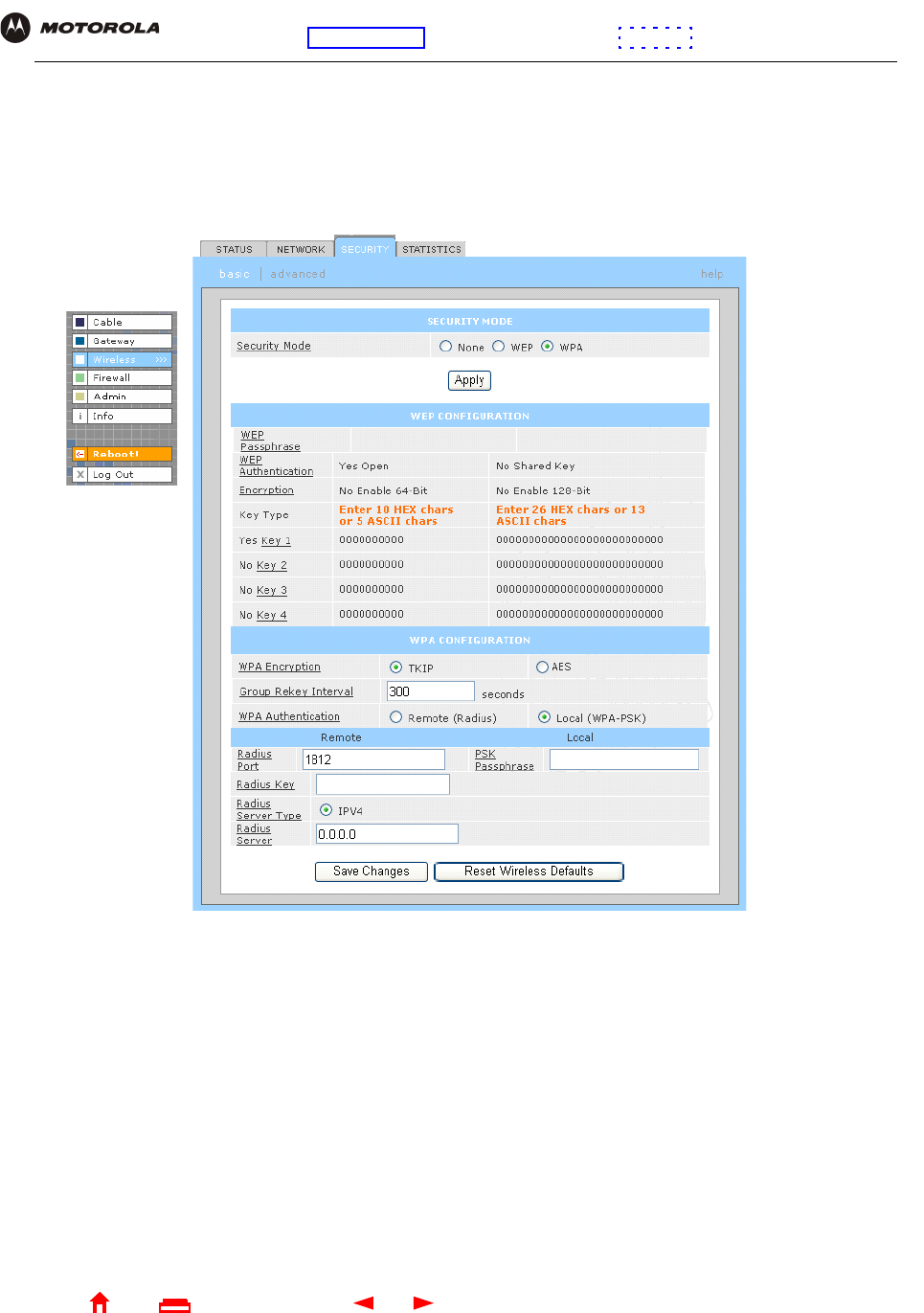
68 SBG940 User Guide
Home
X
ExitPrint
Overview Installation Troubleshooting Contact FAQ Specifications Glossary License
Configuration: Basic Gateway TCP/IP Wireless USB
Configuring WPA on the SBG940
To enable WPA and set the key on the SBG940:
1On the SBG940 Setup Program left panel, click Wireless.
2Click the SECURITY tab to display the Wireless > SECURITY — basic page:
3In the Security Mode field, select WPA and click Apply.
4Under WPA CONFIGURATION, choose one WPA Encryption type. Because performance may be slow with
TKIP, we recommend choosing AES if your clients support AES:
TKIP Temporal Key Integrity Protocol provides data encryption including a per-packet key mixing
function, message integrity check (MIC), initialization vector (IV) and re-keying mechanism.
AES The Advanced Encryption Standard algorithm implements symmetric key cryptography as a
block cipher using 128-bit keys. We recommend this setting if all of your wireless clients
support AES. The Motorola client adapters shown in “Optional Accessories” support AES.

69 SBG940 User Guide
Home
X
ExitPrint
Overview Installation Troubleshooting Contact FAQ Specifications Glossary License
Configuration: Basic Gateway TCP/IP Wireless USB
5Choose the WPA Authentication type:
6For Remote (Radius) authentication only, set:
7For Local (WPA-PSK) authentication only, set:
8Click Save Changes.
If you need to restore the wireless defaults, click Reset Wireless Defaults.
Remote
(Radius)
If a Remote Authentication Dial-In User Service (RADIUS) server is available, you can select this
option and go to step 6. A RADIUS server is typically used in a large corporate location.
Local
(WPA-PSK)
If you choose Pre-Shared Key (PSK) local authentication, if the passphrase on any client
supporting WPA matches the PSK Passphrase set on the SBG940, the client can access the
SBG940 WLAN. To set the PSK Passphrase, go to step 7. A local key is typically used in a home
or small office.
Radius Port The port used for remote authentication through a RADIUS server. It can be from 0 to 65535.
Radius Key The key for remote authentication. It can be from 0 to 255 ASCII characters.
Radius Server
Type
Currently IPv4 only.
Radius Server The RADIUS server IP address in dotted-decimal format (xxx.xxx.xxx.xxx).
PSK
Passphrase
The PSK password containing from 8 to 63 ASCII characters. You must set the identical
passphrase on each WLAN client (see “Configuring a Wireless Client for WPA”).
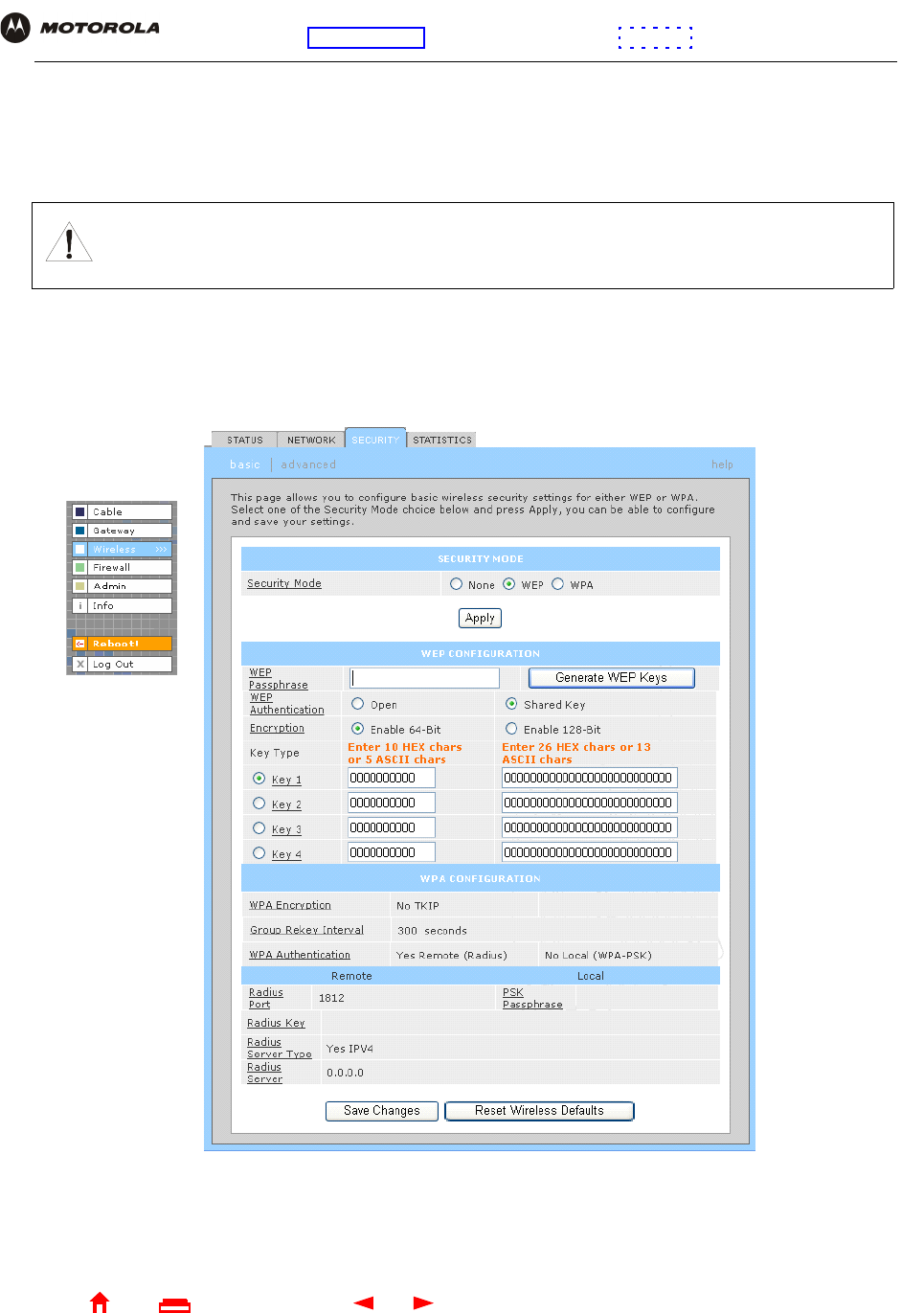
70 SBG940 User Guide
Home
X
ExitPrint
Overview Installation Troubleshooting Contact FAQ Specifications Glossary License
Configuration: Basic Gateway TCP/IP Wireless USB
Configuring WEP on the SBG940
Use Wired Equivalent Privacy (WEP) only if you have wireless clients that do not support WPA.
To enable WEP and set the key on the SBG940:
1On the SBG940 Setup Program left panel, click Wireless.
2Click the SECURITY tab to display the Wireless > SECURITY — basic page:
3In the Security Mode field, select WEP and click Apply.
4In the WEP Passphrase field, type a passphrase containing from 8 to 31 ASCII characters. For privacy, your
passphrase displays as dots.
Caution!
If you use WEP encryption, you must configure the same WEP key on the SBG940 access point and
all wireless clients (stations). Never provide your WEP key or passphrase to anyone who is not
authorized to use your WLAN.
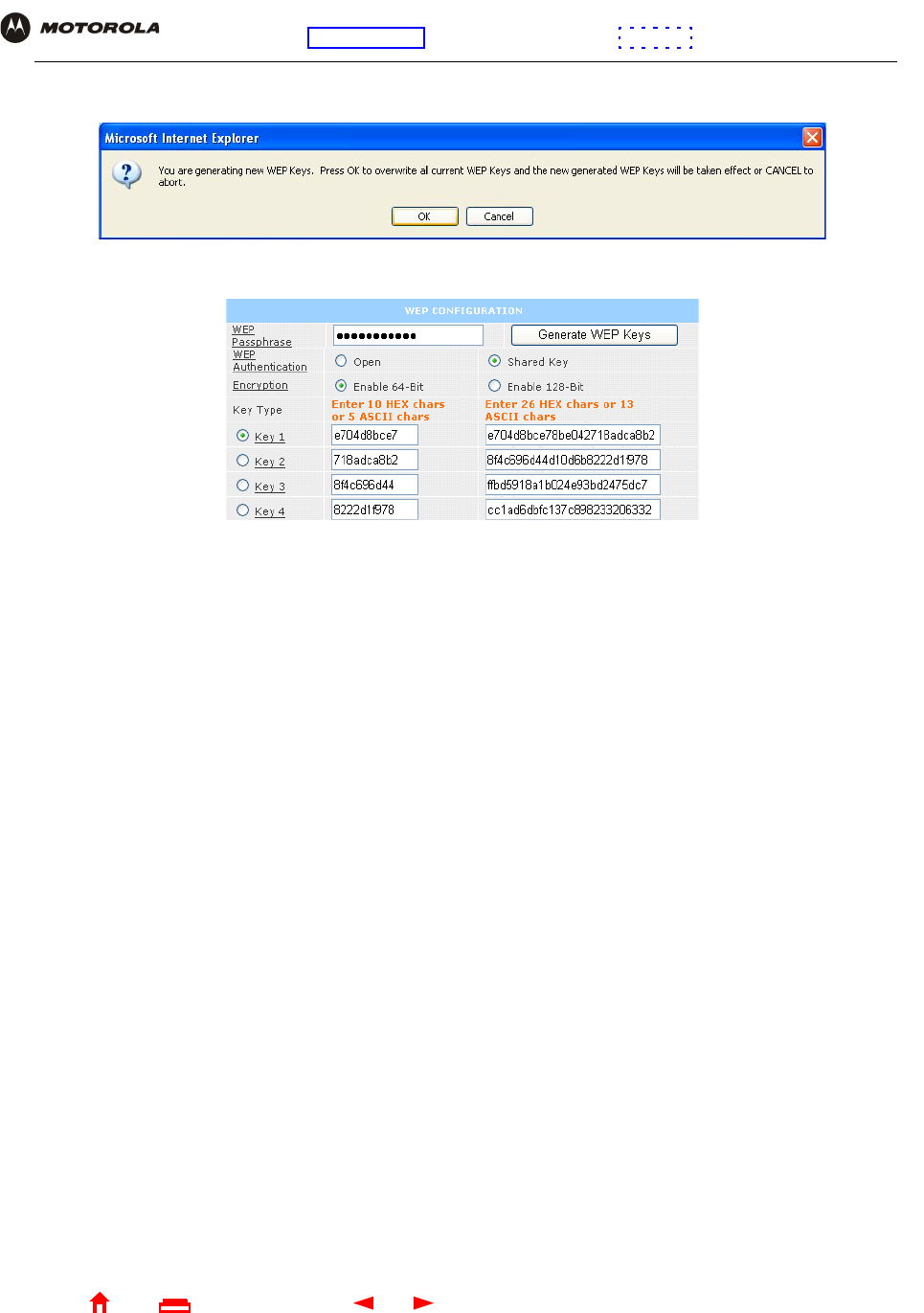
71 SBG940 User Guide
Home
X
ExitPrint
Overview Installation Troubleshooting Contact FAQ Specifications Glossary License
Configuration: Basic Gateway TCP/IP Wireless USB
5Click Generate WEP Keys. The following window is displayed:
6Click OK. The WEP CONFIGURATION fields now appear something like:
Before performing step 7, consider the following:
•If all of your wireless adapters support 128-bit encryption, you can select Enable 128 Bit. Otherwise, you
must select Enable 64 Bit.
•For a WLAN client equipped with a Motorola wireless adapter, you can enter the WEP Passphrase when
you perform Configuring a Wireless Client for WEP. For all other wireless adapters, you will probably
need to enter the generated WEP key that you designate in step 7.
7Under WEP CONFIGURATION, set:
8Click Save Changes to save your changes.
If you need to restore the wireless defaults, click Reset Wireless Defaults.
WEP
Authentication
Sets whether shared key authentication is enabled to provide data privacy on the WLAN:
•Open System — Any WLAN client can transmit data to any other client without
authentication. It is the default, if the Security Mode is set to WEP.
•Shared Key — The SBG940 authenticates and transfers data to and from all clients having
shared key authentication enabled. We recommend this setting.
Encryption Use a WEP key length that is compatible with your wireless client adapters. Choose one of:
•Enable 64-Bit — Use only if you have wireless clients that do not support 128-bit encryption
•Enable 128-Bit — We recommend this setting for stronger encryption; it is supported by the
Motorola WN825G and WPCI810G wireless adapters and most current wireless adapters
Key 1 to Key 4 Select the active key (1 to 4). Only one key can be active. You can generate WEP keys from a
passphrase as described in steps 4 to 6 or type non-case-sensitive hexadecimal characters 0
to 9 and A to F to define up to:
•Four 10-character long key 64-bit WEP keys
•Four 26-character long 128-bit WEP keys
We recommend changing the WEP keys frequently. Never provide the WEP key to anyone
who is not authorized to use your WLAN.

72 SBG940 User Guide
Home
X
ExitPrint
Overview Installation Troubleshooting Contact FAQ Specifications Glossary License
Configuration: Basic Gateway TCP/IP Wireless USB
Restricting Wireless LAN Access
The default SBG940 wireless settings enable any computer having a compatible wireless adapter to access your
WLAN. To protect your network from unauthorized intrusions, you can restrict access to your WLAN to a limited
number of computers on the Wireless > SECURITY — advanced Page.
You can configure one or both of:
Configure on the SBG940 Required On Each Wireless Client
Perform Configuring the Wireless Network Name on the
SBG940 to disable Extended Service Set Identifier (ESSID)
broadcasting to enable closed network operation
You must configure the identical ESSID (network
name) to the SBG940.
Perform Configuring a MAC Access Control List on the
SBG940 to restrict access to wireless clients with known
MAC addresses
No configuration is required on the client.
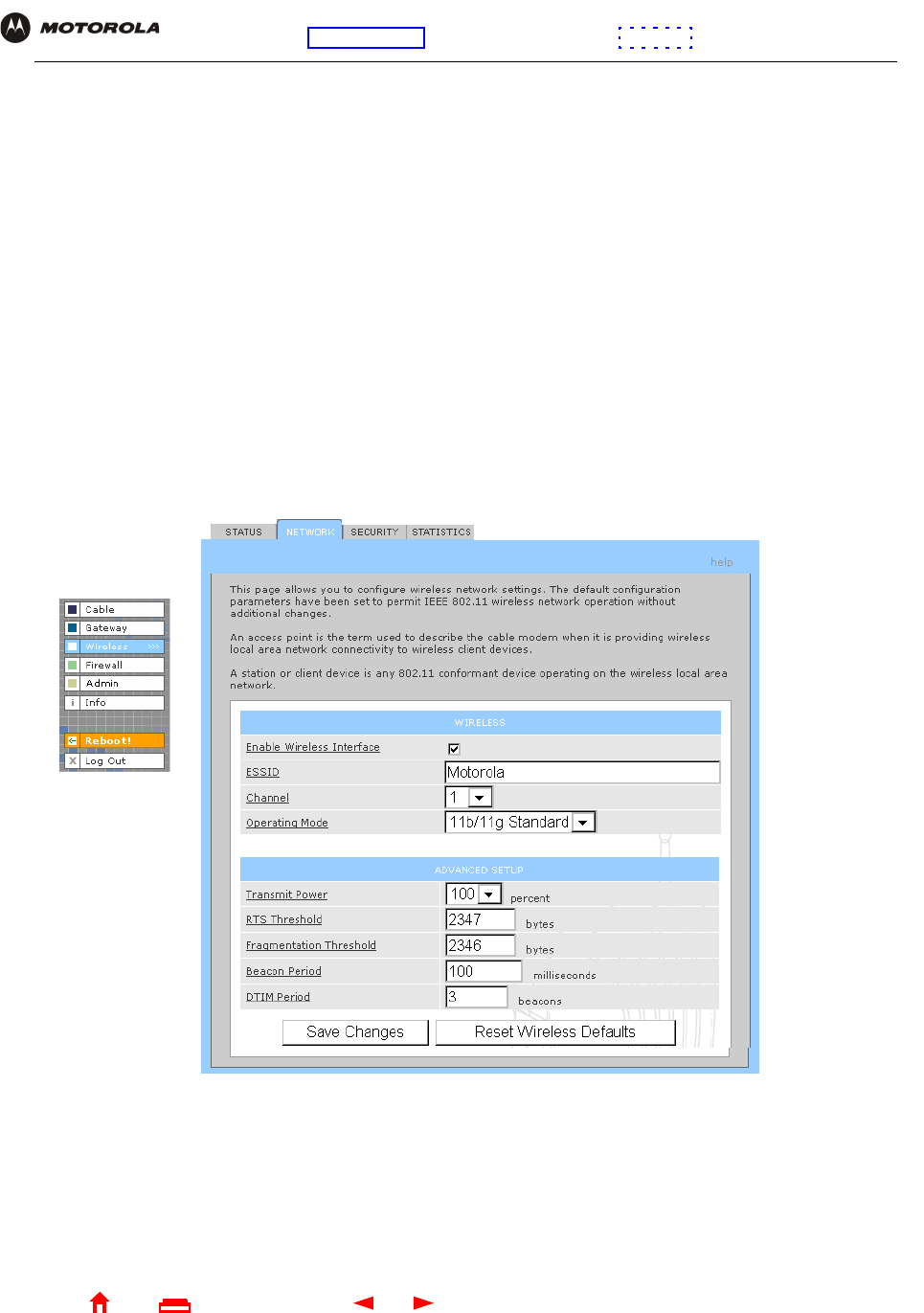
73 SBG940 User Guide
Home
X
ExitPrint
Overview Installation Troubleshooting Contact FAQ Specifications Glossary License
Configuration: Basic Gateway TCP/IP Wireless USB
Configuring the Wireless Network Name on the SBG940
If you disable ESSID broadcasting on the SBG940, the SBG940 does not transmit the network name (ESSID).
This provides additional protection because:
•Only wireless clients configured with your network name can communicate with the SBG940
•Unauthorized individuals who scan for unsecured WLANs cannot access your WLAN
Closed network operation is an enhancement of the IEEE 802.11b and IEEE 802.11g standards.
If you select Disable ESSID Broadcast, you must perform Configuring a Wireless Client with the Network Name
(ESSID) on all WLAN clients (stations). Never provide your ESSID to anyone who is not authorized to use
your WLAN.
To configure the ESSID on the SBG940:
1Start the SBG940 Setup Program as described in “Starting the SBG940 Setup Program”.
2On the left panel, click Wireless.
3Click the NETWORK tab to display:
4In the ESSID field, type a unique name. It can be any alphanumeric, case-sensitive string up to
32 characters. The default is “Motorola.” Do not use the default ESSID.
5Click Save Changes to save your changes.
6To restrict WLAN access to clients configured with the same Network Name (ESSID) as the SBG940, click
the SECURITY tab.
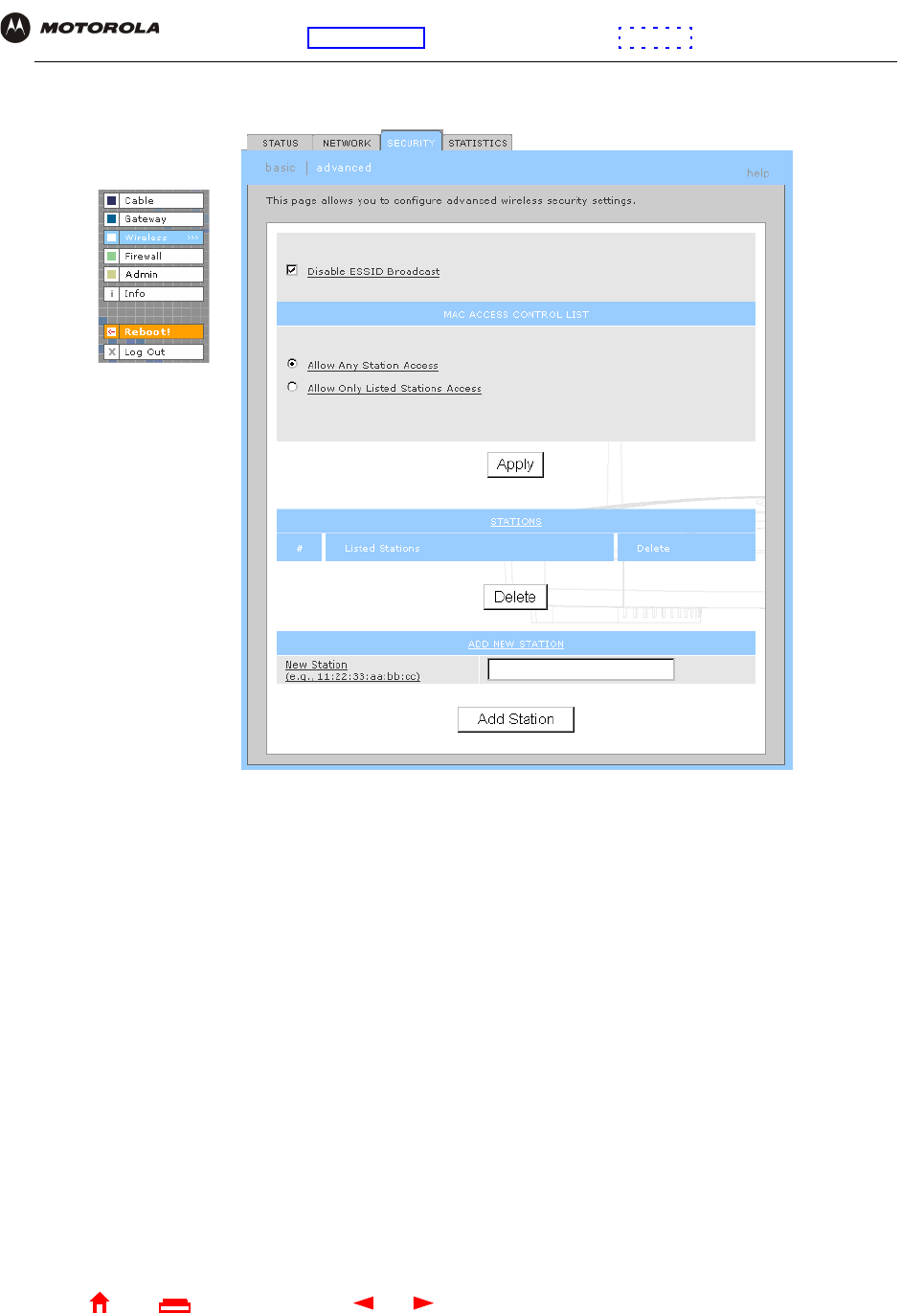
74 SBG940 User Guide
Home
X
ExitPrint
Overview Installation Troubleshooting Contact FAQ Specifications Glossary License
Configuration: Basic Gateway TCP/IP Wireless USB
7Click advanced to display the Wireless > SECURITY — advanced Page:
8Select Disable ESSID Broadcast to restrict WLAN access to clients configured with the same Network
Name (ESSID) as the SBG940.
9Click Apply to save your changes.
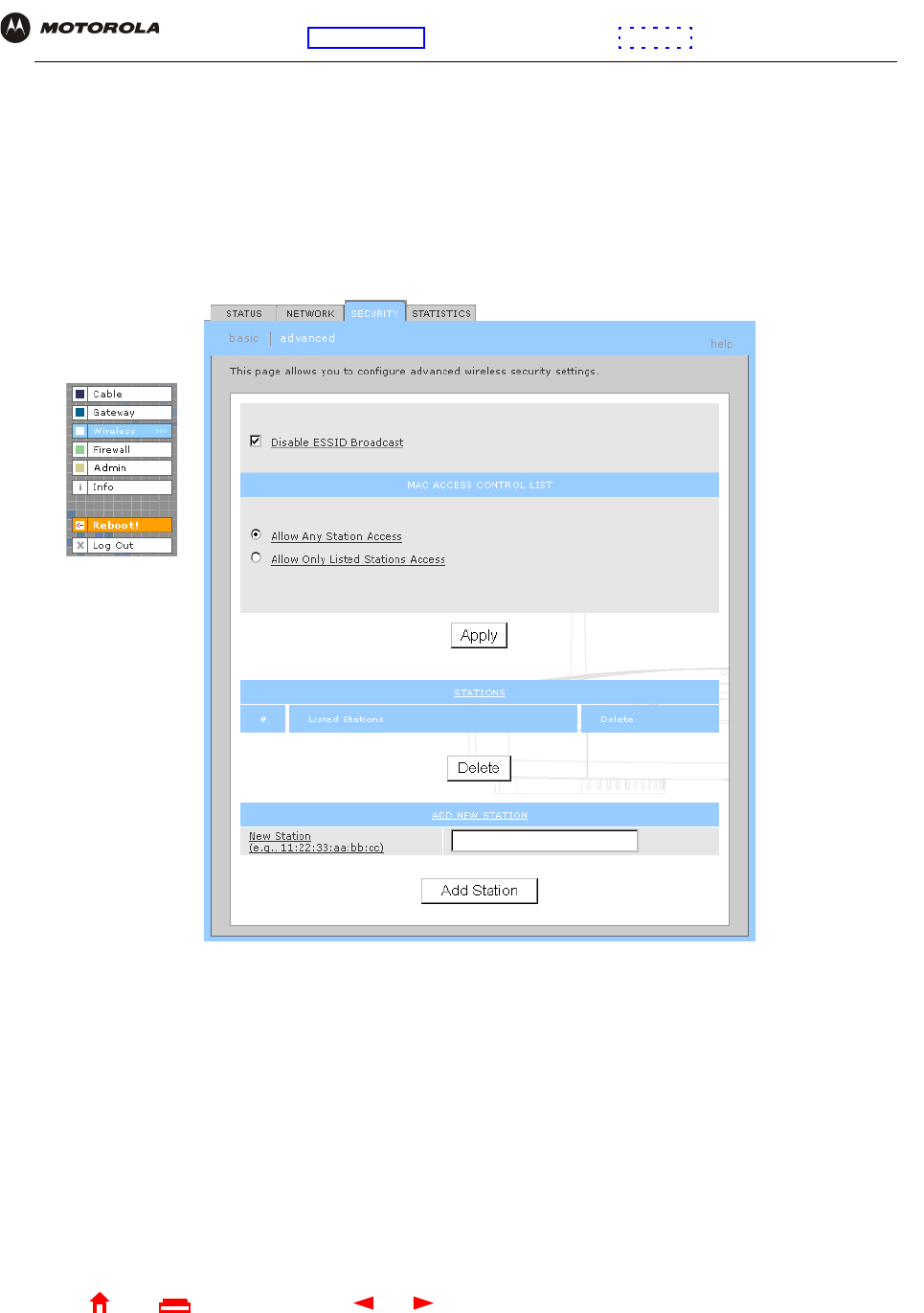
75 SBG940 User Guide
Home
X
ExitPrint
Overview Installation Troubleshooting Contact FAQ Specifications Glossary License
Configuration: Basic Gateway TCP/IP Wireless USB
Configuring a MAC Access Control List on the SBG940
You can restrict wireless access to one to 32 wireless clients, based on the client MAC address.
To configure a MAC access control list:
1On the SBG940 Setup Program left panel, click Wireless.
2Click the SECURITY tab.
3Click advanced to display the Wireless > SECURITY — advanced Page:
4To restrict wireless access to systems in the MAC access control list, select Allow Only Listed Stations
Access and click Apply.
5To add a wireless client, type its MAC address in the format xx:xx:xx:xx:xx:xx in the New Station field and
click Add Station.
You can add up to 32 wireless clients to the MAC access control list.
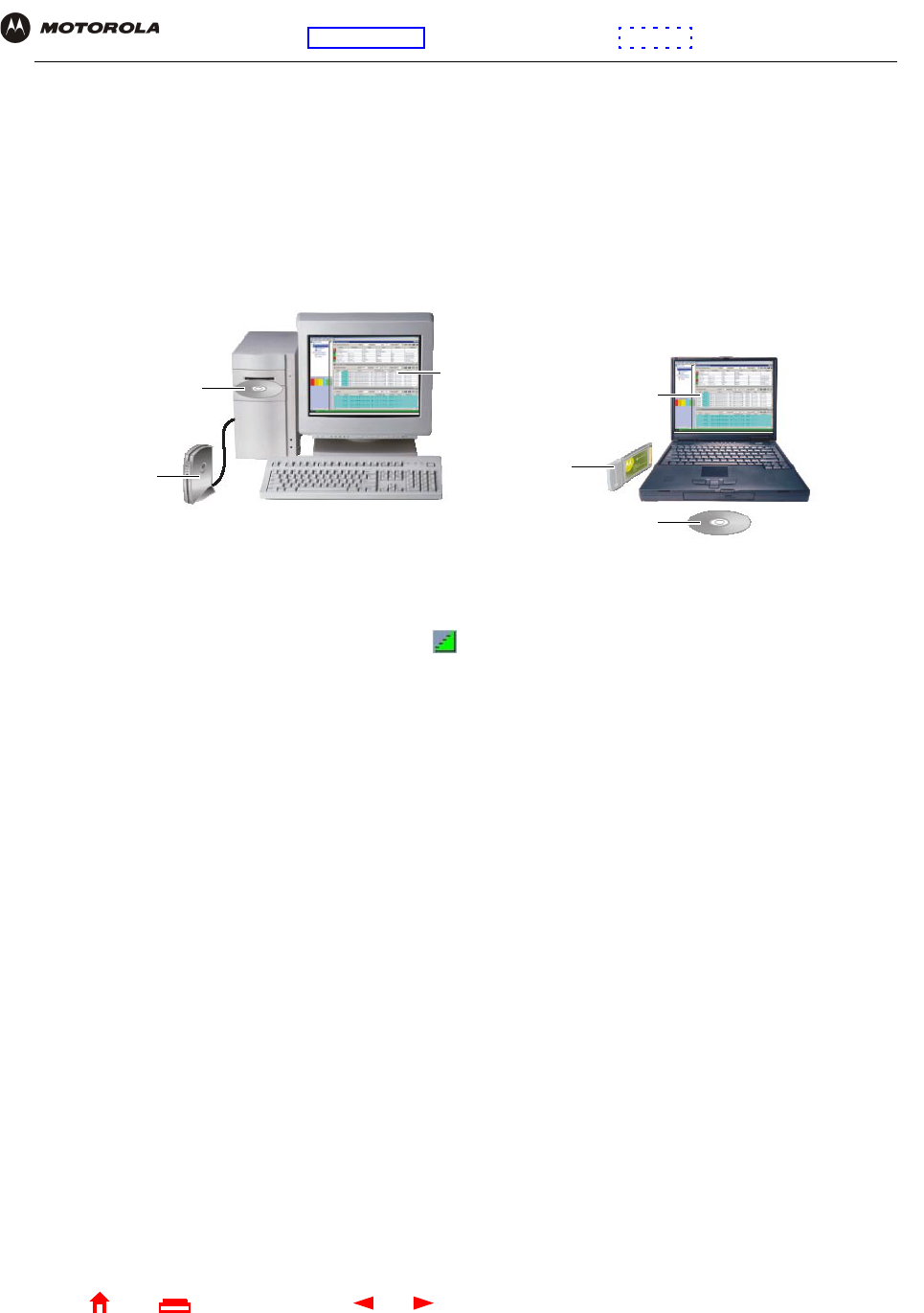
76 SBG940 User Guide
Home
X
ExitPrint
Overview Installation Troubleshooting Contact FAQ Specifications Glossary License
Configuration: Basic Gateway TCP/IP Wireless USB
Configuring the Wireless Clients
For each wireless client computer (station), install the wireless adapter — such as a Motorola WN825G,
WPCI810G, or WU830G — following the instructions supplied with the adapter. Be sure to:
1Insert the CD-ROM for the adapter in the CD-ROM drive on the client.
2Install the device software from the CD.
3Insert the adapter in the PCMCIA or PCI slot or connect it to the USB port.
Configure the adapter to obtain an IP address automatically. The Motorola wireless adapters are supplied with a
client configuration program called Wireless Client Manager, which is installed in the Windows Startup group.
On a PC with Wireless Client Manager installed, the icon is displayed on the Windows task bar. Double-click
the icon to launch the utility.
You may need to do the following to use a wireless client computer to surf the Internet:
If You Performed On Each Client, You Need to Perform
Configuring WPA on the SBG940 Configuring a Wireless Client for WPA
Configuring WEP on the SBG940 Configuring a Wireless Client for WEP
Configuring the Wireless Network Name on the SBG940 Configuring a Wireless Client with the Network Name
(ESSID)
Configuring a MAC Access Control List on the SBG940 No configuration on client required
Step 1
Step 1
Step 2
Step 2
Step 3
Step 3
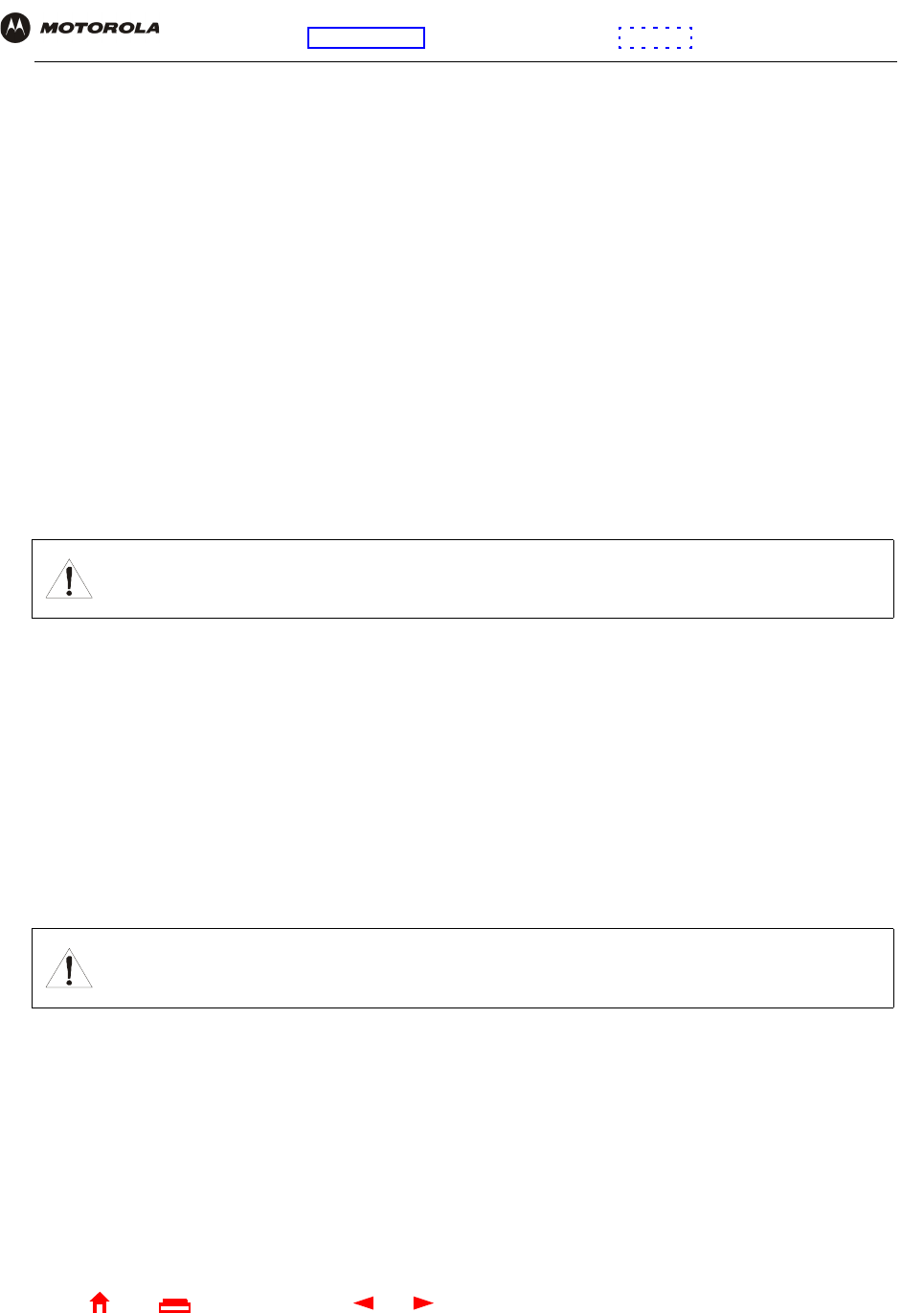
77 SBG940 User Guide
Home
X
ExitPrint
Overview Installation Troubleshooting Contact FAQ Specifications Glossary License
Configuration: Basic Gateway TCP/IP Wireless USB
Configuring a Wireless Client for WPA
If you enabled WPA and set a PSK Passphrase by Configuring WPA on the SBG940, you must configure the
same passphrase (key) on each wireless client. The SBG940 cannot authenticate a client if:
•WPA is enabled on the SBG940 but not on the client
•The client passphrase does not match the SBG940 PSK Passphrase
For information about the WPA support in Windows XP, visit:
You can download the Microsoft Windows XP Support Patch for Wi-Fi Protected Access from
http://www.microsoft.com/downloads/details.aspx?FamilyId=009D8425-CE2B-47A4-ABEC-274845DC9E91&disp
laylang=en
Configuring a Wireless Client for WEP
If you enabled WEP and set a key by Configuring WEP on the SBG940, you must configure the same WEP key on
each wireless client. The SBG940 cannot authenticate a client if:
•Shared Key Authentication is enabled on the SBG940 but not on the client
•The client WEP key does not match the SBG940 WEP key
On a WLAN client equipped with a Motorola wireless adapter, you can enter the WEP Passphrase you set when
you configured the SBG940. For all other wireless adapters, you must enter the 64-bit or 128-bit WEP key
generated by the SBG940.
Configuring a Wireless Client with the Network Name (ESSID)
To distinguish it from other nearby WLANs, you can identify your WLAN with a unique network name (also known
as a network identifier or ESSID). When prompted for the network identifier, network name, or ESSID, type the
name set in the ESSID field on the Wireless > NETWORK Page in the SBG940 Setup Program. For more
information, see “Configuring the Wireless Network Name on the SBG940”.
After you specify the network name, many wireless cards or adapters automatically scan for an access point such
as the SBG940 and the proper channel and data rate. If your card requires you to manually start scanning for an
access point, do so following the instructions in the documentation supplied with the card.
Never provide the ESSID to anyone who is not authorized to use your WLAN.
WPA Wireless Security for Home Networks http://www.microsoft.com/WindowsXP/expertzone/columns/
bowman/03july28.asp
Overview of the WPA Wireless Security Update in
Windows XP
http://support.microsoft.com/?kbid=815485
Caution!
Never provide the PSK Passphrase to anyone who is not authorized to use your WLAN.
Caution!
Never provide the WEP key to anyone who is not authorized to use your WLAN.

78 SBG940 User Guide
Home
X
ExitPrint
Overview Installation Troubleshooting Contact FAQ Specifications Glossary License
Configuration: Basic Gateway TCP/IP Wireless USB
Wireless Pages in the SBG940 Setup Program
Use the Wireless pages to control and monitor the wireless interface:
•Wireless > STATUS Page
•Wireless > NETWORK Page
•Wireless > SECURITY — basic Page
•Wireless > SECURITY — advanced Page
•Wireless > STATISTICS page
After you edit some fields and click Apply, you are warned that you must reboot for your change to take effect.
Rebooting takes 10 to 15 seconds. After rebooting, you must log in again.
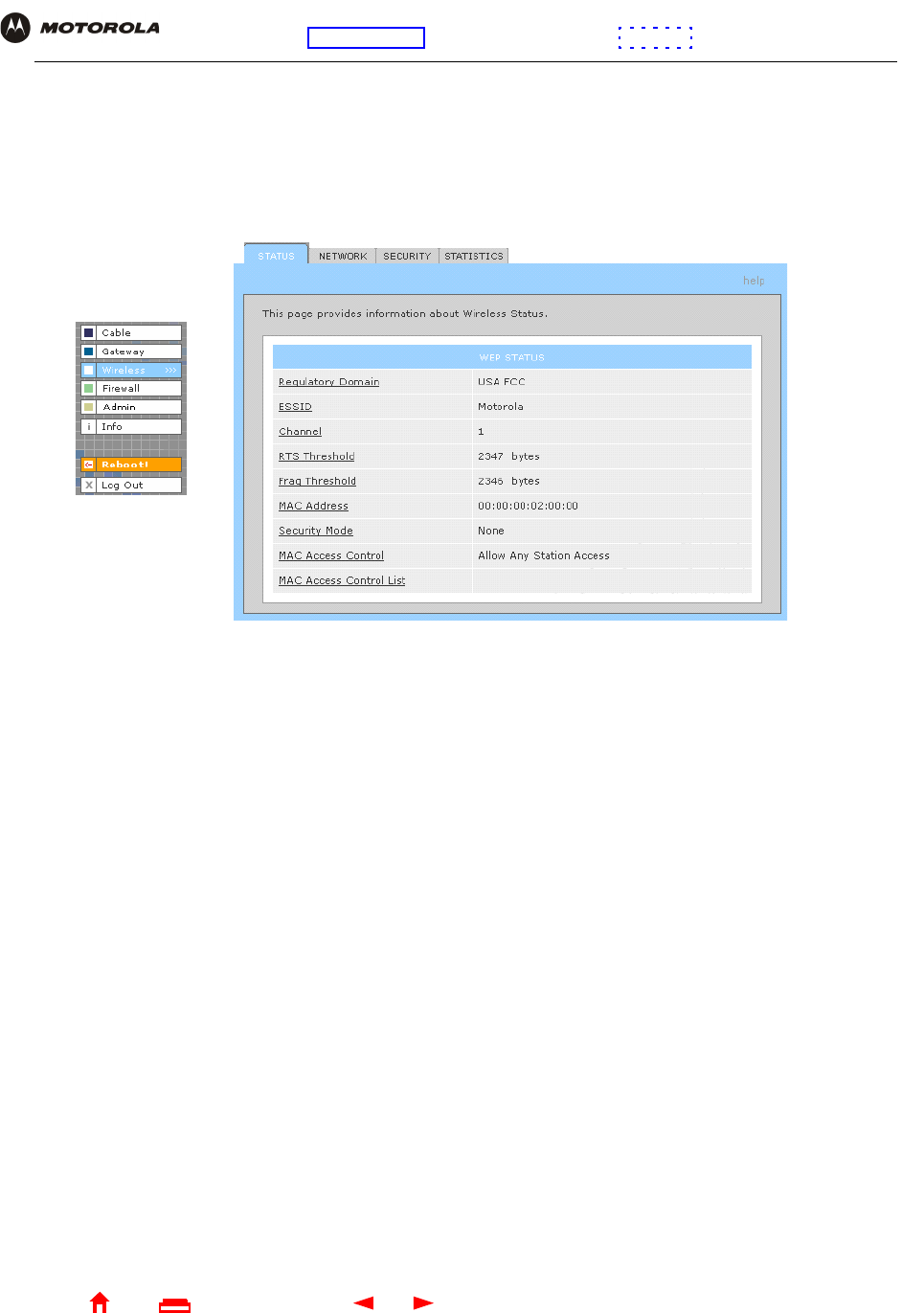
79 SBG940 User Guide
Home
X
ExitPrint
Overview Installation Troubleshooting Contact FAQ Specifications Glossary License
Configuration: Basic Gateway TCP/IP Wireless USB
Wireless > STATUS Page
You can use this display-only page to:
•View the wireless interface status
•Help perform Troubleshooting for wireless network problems
Wireless > STATUS Page Fields
Regulatory Domain Indicates the country the SBG940 is manufactured for. The list of channels depends on the
country’s standards for operation of wireless devices. Depending on the domain set at the factory,
USA FCC, Europe, Spain, France, Japan, or some other country name is displayed.
ESSID Displays the ESSID set on the Wireless > NETWORK Page. For more information, see
“Configuring the Wireless Network Name on the SBG940”. Never provide the ESSID to anyone
who is not authorized to use your WLAN.
Channel Displays the radio channel for the access point. If you encounter interference, you can set a
different channel on the Wireless > NETWORK Page.
RTS Threshold Displays the Request to Send Threshold set on the Wireless > NETWORK Page.
Frag Threshold Displays the Fragmentation Threshold set on the Wireless > NETWORK Page.
MAC Address Displays the SBG940 MAC address.
Security Mode Displays the enabled wireless encryption type. For more information, see “Configuring WPA on
the SBG940” or “Configuring WEP on the SBG940”.
MAC Access Control Displays the MAC Access Control setting (see “Configuring a MAC Access Control List on the
SBG940”):
•Allow Listed — Only clients in the MAC access control list can access the WLAN.
•Allow Any Station Access — Any wireless client can access the WLAN.
MAC Access Control List Displays the MAC addresses of wireless clients having access (see “Configuring a MAC Access
Control List on the SBG940”).
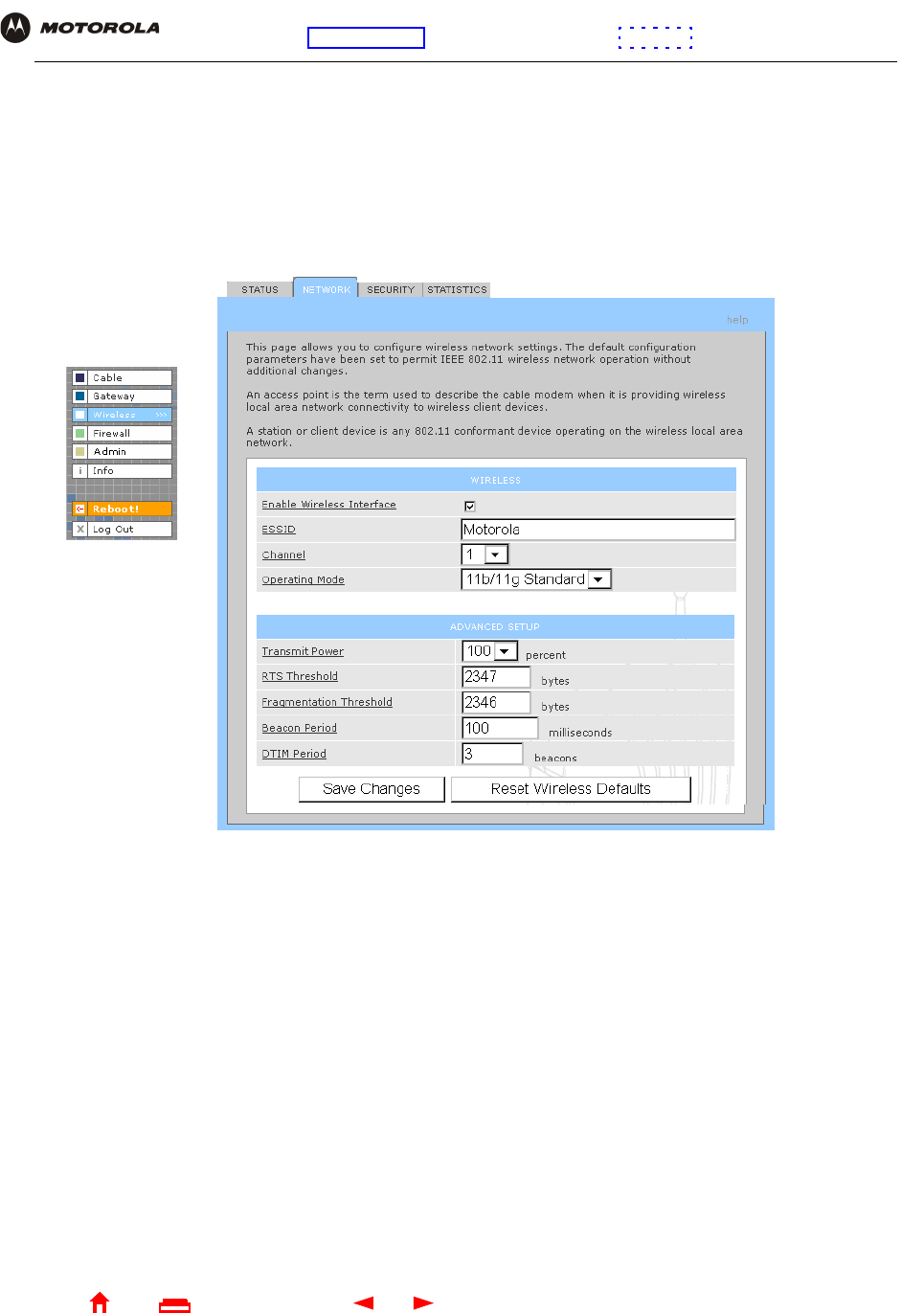
80 SBG940 User Guide
Home
X
ExitPrint
Overview Installation Troubleshooting Contact FAQ Specifications Glossary License
Configuration: Basic Gateway TCP/IP Wireless USB
Wireless > NETWORK Page
Use this page for:
•Configuring the Wireless Network Name on the SBG940
•Configuring other WLAN settings
You can use the SBG940 to operate a WLAN without changing its default settings.
Wireless > NETWORK page fields
Field Description
WIRELESS
Enable Wireless
Interface
Select this box to enable the wireless interface.
ESSID Sets a unique network name for the SBG940 WLAN to distinguish between multiple WLANs in
the vicinity. If you select Disable ESSID Broadcast on the Wireless > SECURITY — advanced
Page, all clients on the WLAN must have the same ESSID (network name) as the SBG940. It
can be any alphanumeric, case-sensitive string up to 32 characters. The default is “Motorola.”
We strongly recommend not using the default. Never provide the ESSID to anyone who is not
authorized to use your WLAN.
Channel Sets the wireless radio channel. You can change the channel if you encounter interference on
the default channel. The default is 1 (one), except in countries where the first channel
permitted for wireless operation is not one.

81 SBG940 User Guide
Home
X
ExitPrint
Overview Installation Troubleshooting Contact FAQ Specifications Glossary License
Configuration: Basic Gateway TCP/IP Wireless USB
Operating Mode Sets how the SBG940 communicates with wireless clients (stations):
•11b/11g Standard — Enables all IEEE 802.11b and IEEE 802.11g clients to work with the
SBG940. We recommend using this default setting in most cases because it is more flexible.
•11g Enhanced — Choose this option only if all IEEE 802.11g client adapters on the network
support the performance-enhancing features of the IEEE 11g Enhanced mode. It is not
supported by all IEEE 802.11g adapters.
ADVANCED SETUP
Transmit Power Sets the SBG940 wireless transmission power — 1, 2, 5, 10, 25, 50, or 100 mW. The default is
32 mW. Transmission power control is an optional IEEE 802.11b feature.
RTS Threshold The Request To Send Threshold sets the minimum packet size for which the SBG940 issues
an RTS before sending a packet. A low RTS Threshold can help when many clients are
associated with the SBG940 or the clients are far apart and can detect the SBG940 but not
each other. It can be 0 to 2347 bytes. The default is 2347.
Fragmentation
Threshold
Sets the size at which packets are fragmented (sent as several packets instead of as one
packet). A low Fragmentation Threshold can help when communication is poor or there is a
significant interference. It can be 256 to 2346 bytes. The default is 2346.
Beacon Period Sets the time between beacon frames sent by the SBG940 for wireless network
synchronization. It can be from 1 to 999 ms. The default is 100 ms.
DTIM Period The delivery traffic indication message (DTIM) period is the number of Beacon Periods that
elapse before a wireless client operating in power save mode “listens” for buffered broadcast
or multicast messages from the SBG940. It can be from 1 to 99999. The default is 3.
Wireless > NETWORK page fields (continued)
Field Description
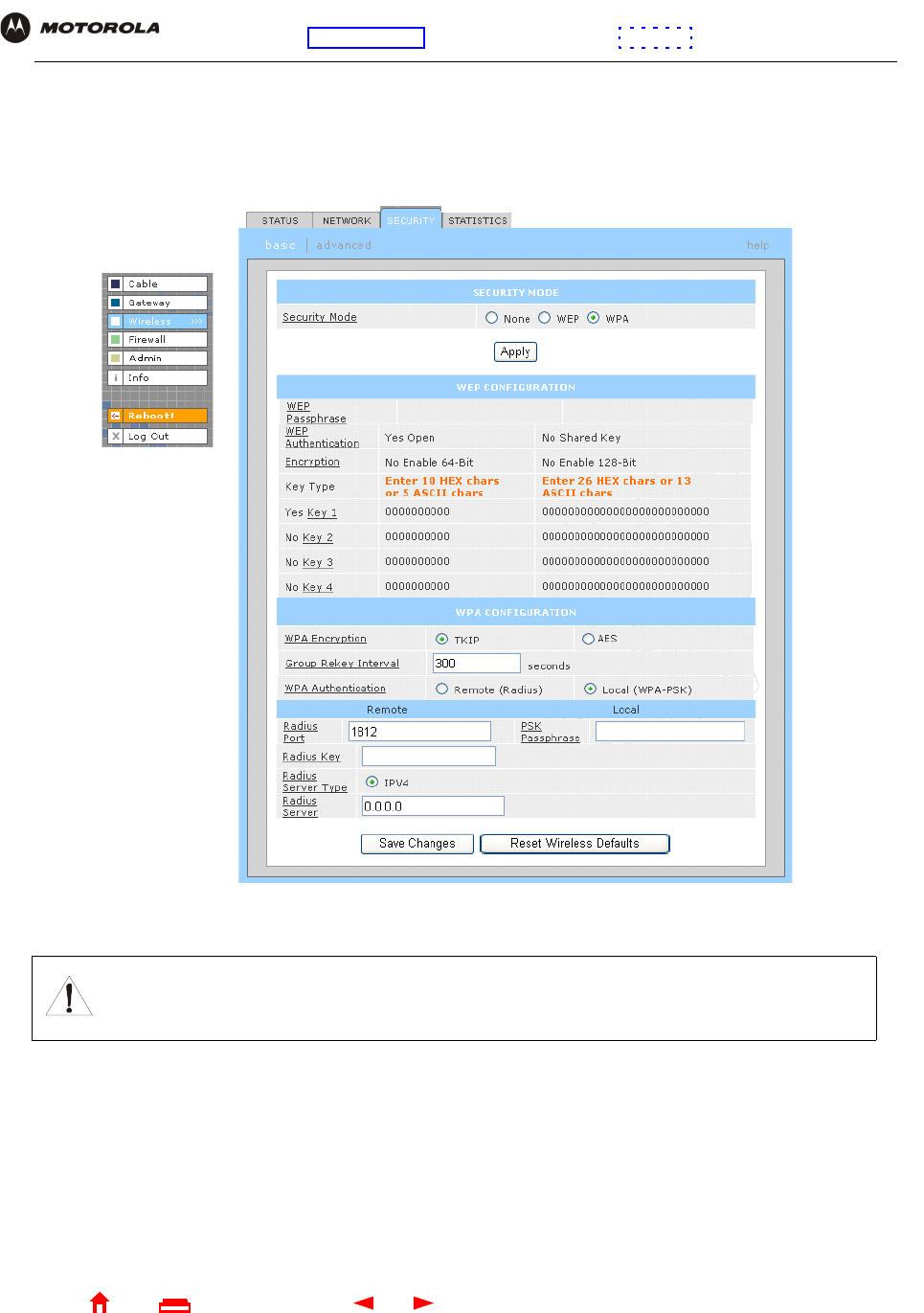
82 SBG940 User Guide
Home
X
ExitPrint
Overview Installation Troubleshooting Contact FAQ Specifications Glossary License
Configuration: Basic Gateway TCP/IP Wireless USB
Wireless > SECURITY — basic Page
Use this page to configure how your SBG940 encrypts wireless transmissions. For information about using this
page, see “Encrypting Wireless LAN Transmissions”. After you enable WEP or WPA on the SBG940, you must
configure each WLAN client as described in “Configuring the Wireless Clients”.
Caution!
The default Security Mode setting None provides no security for transmitted data.
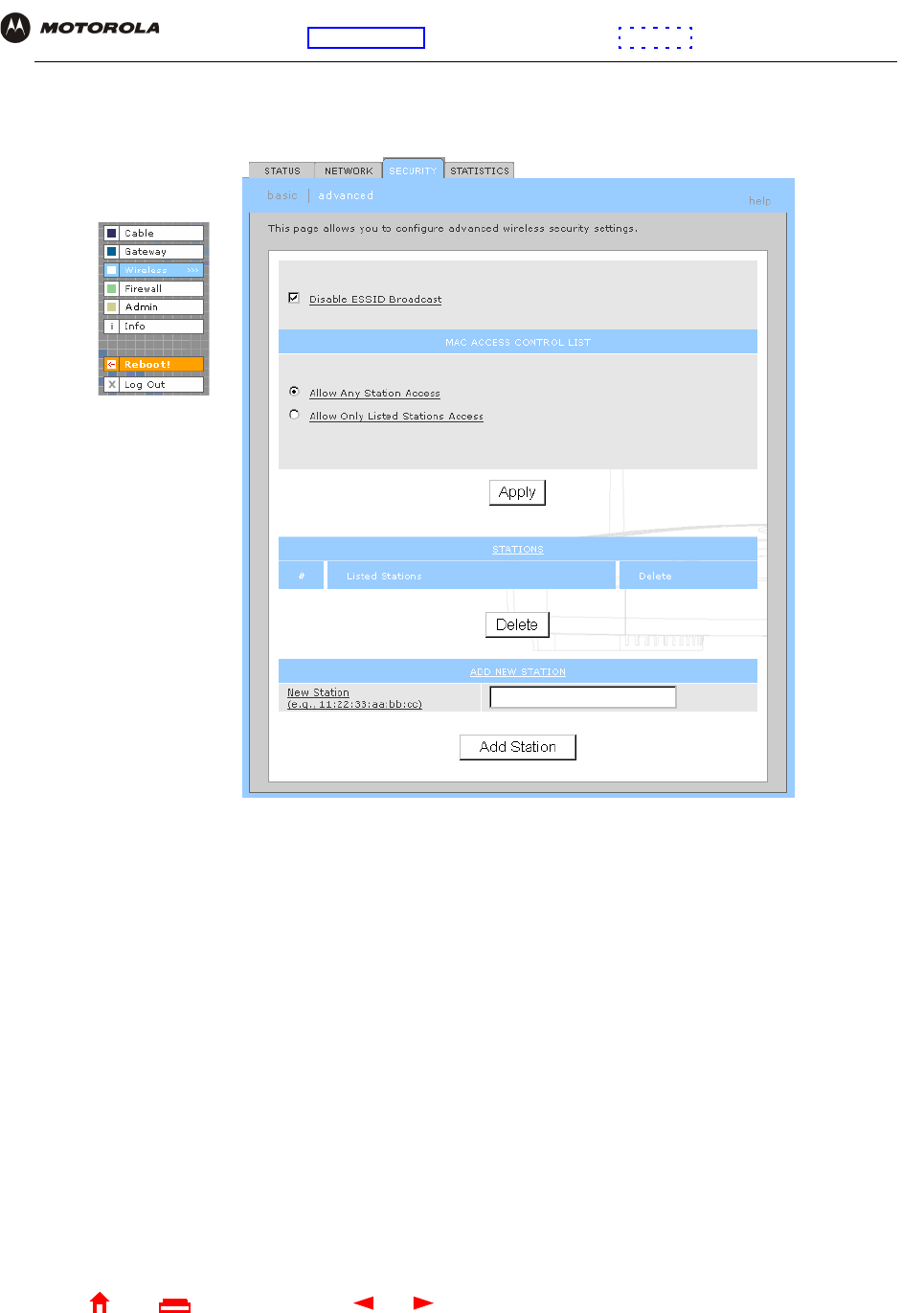
83 SBG940 User Guide
Home
X
ExitPrint
Overview Installation Troubleshooting Contact FAQ Specifications Glossary License
Configuration: Basic Gateway TCP/IP Wireless USB
Wireless > SECURITY — advanced Page
Use this page to configure advanced wireless security settings.
Wireless > Security — ADVANCED page fields
Field or Button Description
Disable ESSID Broadcast If selected, only wireless clients (stations) having the same Network Name (ESSID) as the
SBG940 can communicate with the SBG940. Closed network operation is a SBG940
enhancement to IEEE 802.11b. The default is not selected (off).
MAC ACCESS CONTROL
LIST
You can restrict wireless access to one to 32 wireless clients, based on the client MAC
address.
Allow Any Station
Access
If selected, any wireless client can access the SBG940 WLAN.
Allow Only Listed
Stations Access
If selected, only wireless clients in the MAC access control list can access the SBG940
WLAN.
Apply Click to apply your change.
Listed Stations Lists the wireless clients in the MAC access control list having access if Allow Only Listed
Stations Access is selected.
Delete To delete a wireless client from the MAC access control list, select its Delete check box
and click the Delete button.
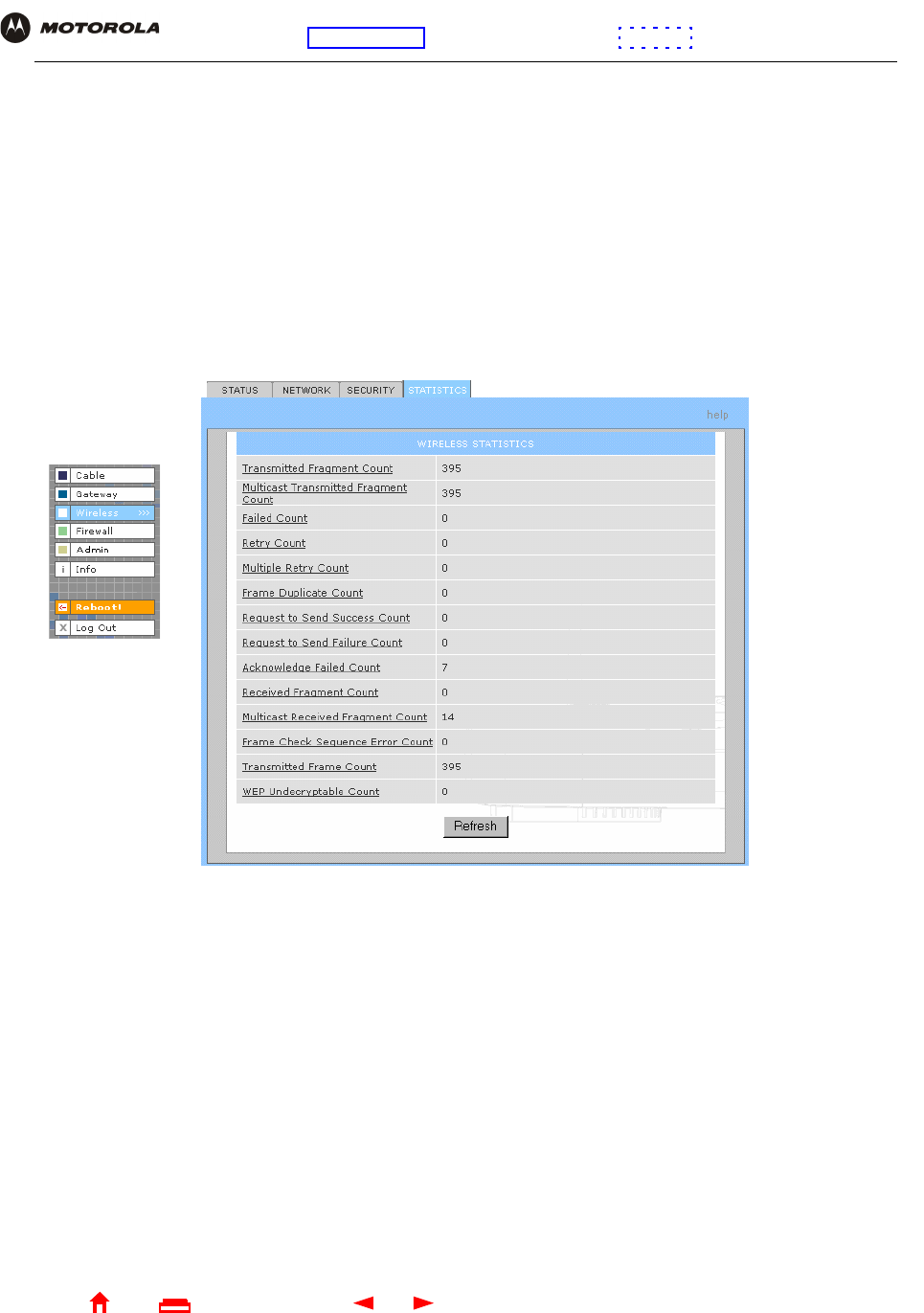
84 SBG940 User Guide
Home
X
ExitPrint
Overview Installation Troubleshooting Contact FAQ Specifications Glossary License
Configuration: Basic Gateway TCP/IP Wireless USB
Wireless > STATISTICS page
Use this page to display wireless statistics.
ADD NEW STATION
New Station Type the MAC address of the wireless client to add to the MAC access control list. Use the
format xx:xx:xx:xx:xx:xx. The MAC access control list can contain one to 32 clients.
Add Station Click to add the New Station to the MAC access control list.
Wireless > STATISTICS page fields
Field or Button Description
Transmitted
Fragment Count
The number of acknowledged MAC protocol data units (MPDUs) with an address in the
address 1 field or an MPDU with a multicast address in the address 1 field of type data or
management.
Multicast
Transmitted
Fragment Count
The number of transmitted fragments when the multicast bit is set in the destination MAC
address of a successfully transmitted MAC service data unit (MSDU). When operating as a
STA in an ESS, where these frames are directed to the AP, this implies having received an
acknowledgment to all associated MPDUs.
Failed Count The number of MSDUs not transmitted successfully because the number of transmit attempts
exceeded the IEEE 802.11b short or long retry limit.
Retry Count The number of successfully transmitted MSDUs after one or more retransmissions.
Wireless > Security — ADVANCED page fields (continued)
Field or Button Description

85 SBG940 User Guide
Home
X
ExitPrint
Overview Installation Troubleshooting Contact FAQ Specifications Glossary License
Configuration: Basic Gateway TCP/IP Wireless USB
Multiple Retry Count The number of successfully transmitted MSDUs after more than one retransmission.
Frame Duplicate
Count
The number of frames received where the Sequence Control field indicated the frame was a
duplicate.
Request To Send
Success Count
The number of CTS messages received in response to RTS messages.
Request To Send
Failure Count
The number of CTS messages not received in response to RTS messages.
Acknowledge Failed
Count
The number of acknowledgment messages not received when expected from a data
message transmission.
Received Fragment
Count
The number of successfully received MPDUs of type Data or Management.
Multicast Received
Fragment Count
The number of MSDUs received when the multicast bit was set in the destination MAC
address.
Frame Check
Sequence Error
Count
The number of FCS errors detected in a received MPDU.
Transmitted Frame
Count
The number of successfully transmitted MSDUs.
WEP Undecryptable
Count
This number of frames received with the WEP subfield of the Frame Control field set to one
and the WEP On key value mapped to the client MAC address. This indicates that the frame
should not have been encrypted or was discarded due to the receiving client not having WEP
enabled.
Refresh Click to collect new data.
Wireless > STATISTICS page fields (continued)
Field or Button Description
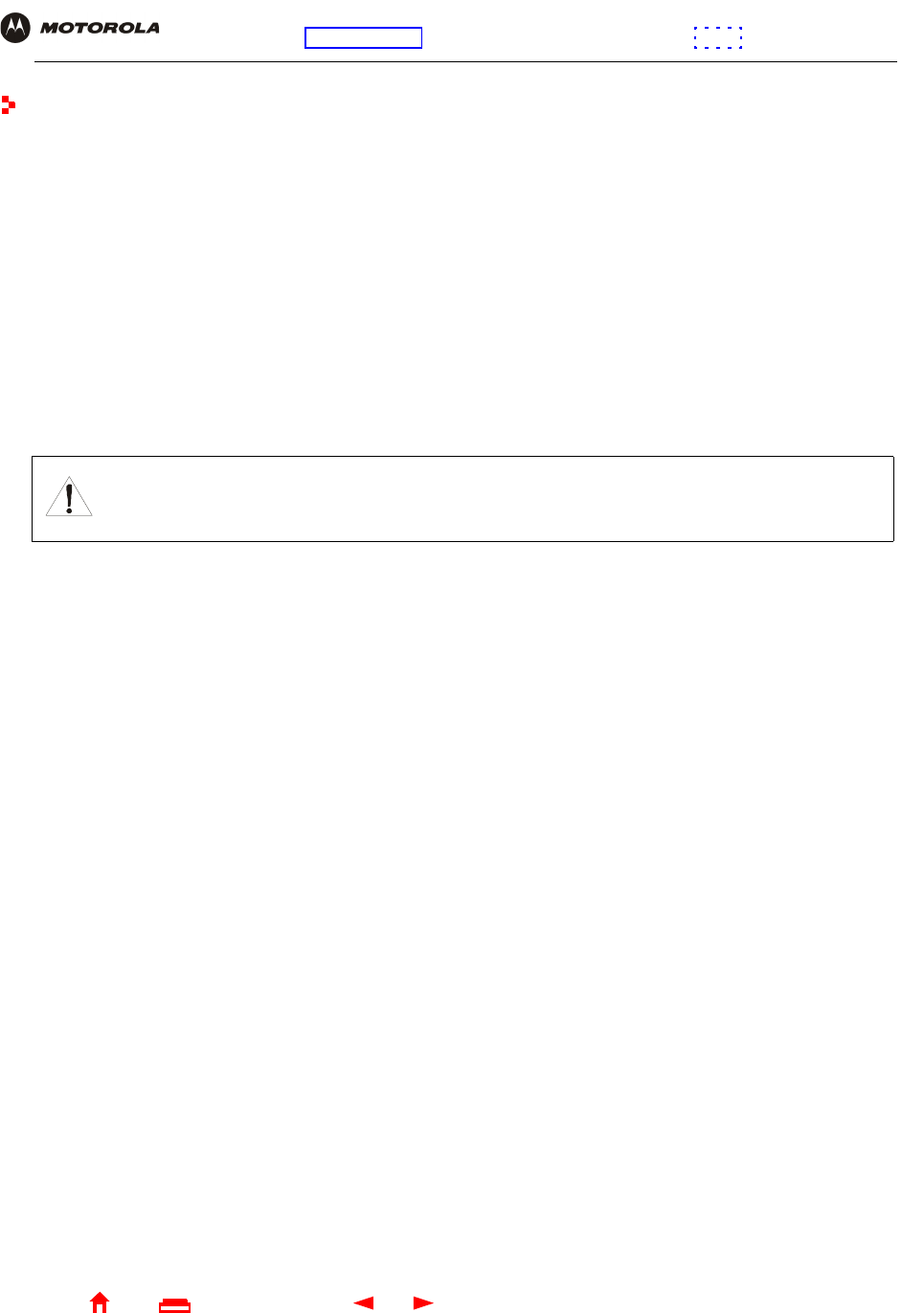
86 SBG940 User Guide
Home
X
ExitPrint
Overview Installation Troubleshooting Contact FAQ Specifications Glossary License
Configuration: Basic Gateway TCP/IP Wireless USB
Setting Up a USB Driver
The following subsections describe setting up a USB driver if you connect a PC to the USB port on the SBG940.
Before connecting a PC to the USB port, perform one of the following procedures based on your Windows
version:
•Setting Up a USB Driver in Windows 98
•Setting Up a USB Driver in Windows 2000
•Setting Up a USB Driver in Windows Me
•Setting Up a USB Driver in Windows XP
The SBG940 USB driver does not support Macintosh or UNIX computers. For those systems, you can connect
through Ethernet only.
If you have a problem setting up the USB driver, remove it by performing one of the following procedures:
•Removing the USB Driver from Windows 98 or Windows Me
•Removing the USB Driver from Windows 2000
•Removing the USB Driver from Windows XP
Caution!
Be sure the SBG940 Installation CD-ROM is inserted in the CD-ROM drive before you plug in the
USB cable.
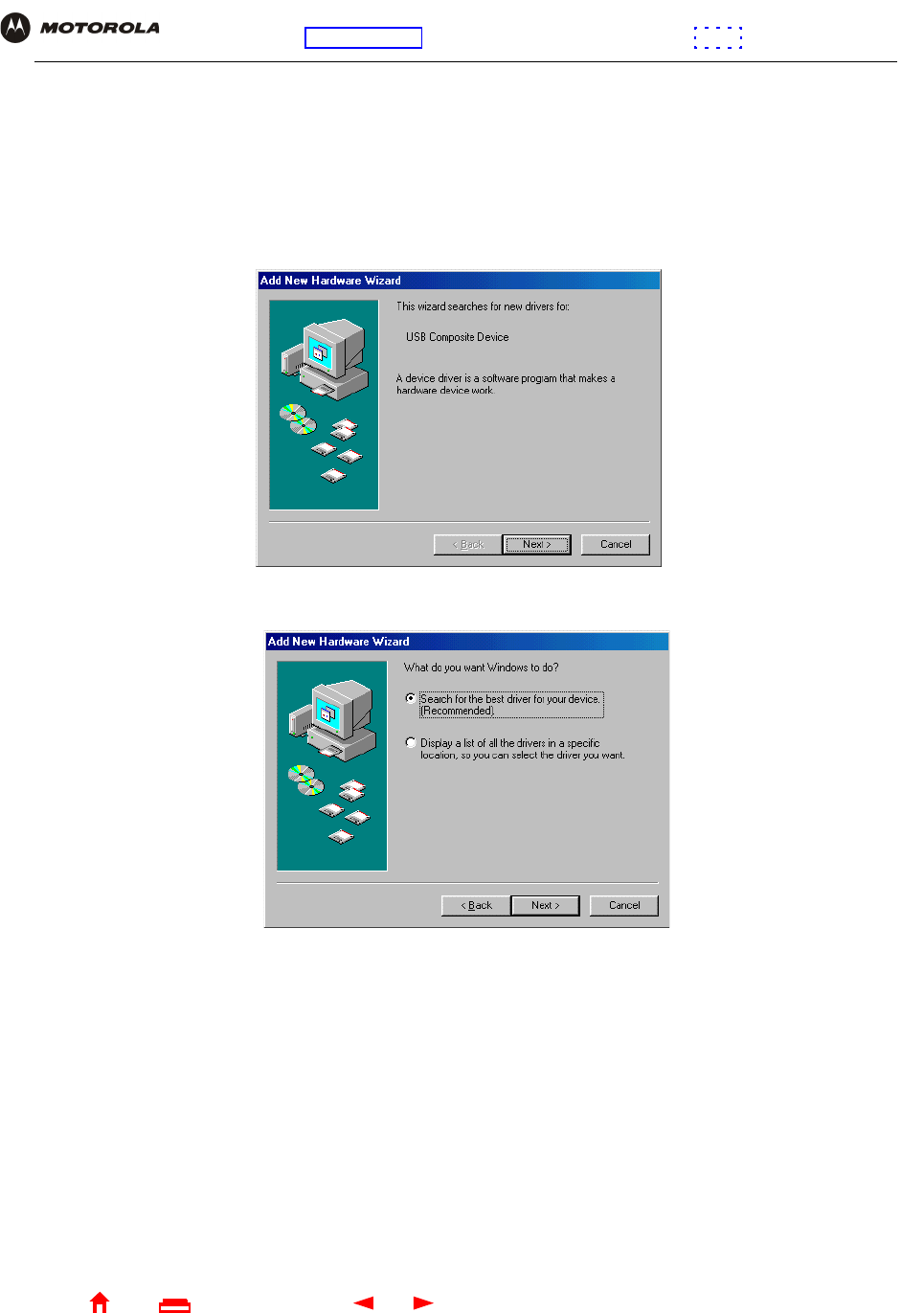
87 SBG940 User Guide
Home
X
ExitPrint
Overview Installation Troubleshooting Contact FAQ Specifications Glossary License
Configuration: Basic Gateway TCP/IP Wireless USB
Setting Up a USB Driver in Windows 98
1Insert the SBG940 Installation CD-ROM in the CD-ROM drive. This CD contains the USB drivers and must be
inserted and read by the PC before you connect the SBG940 to the PC.
2Connect the USB cable as shown in USB Connection.
A few seconds after you complete the USB connection, the Add New Hardware Wizard window is displayed:
3Click Next. The following window is displayed:
4Be sure “Search for the best driver for your device” is selected.
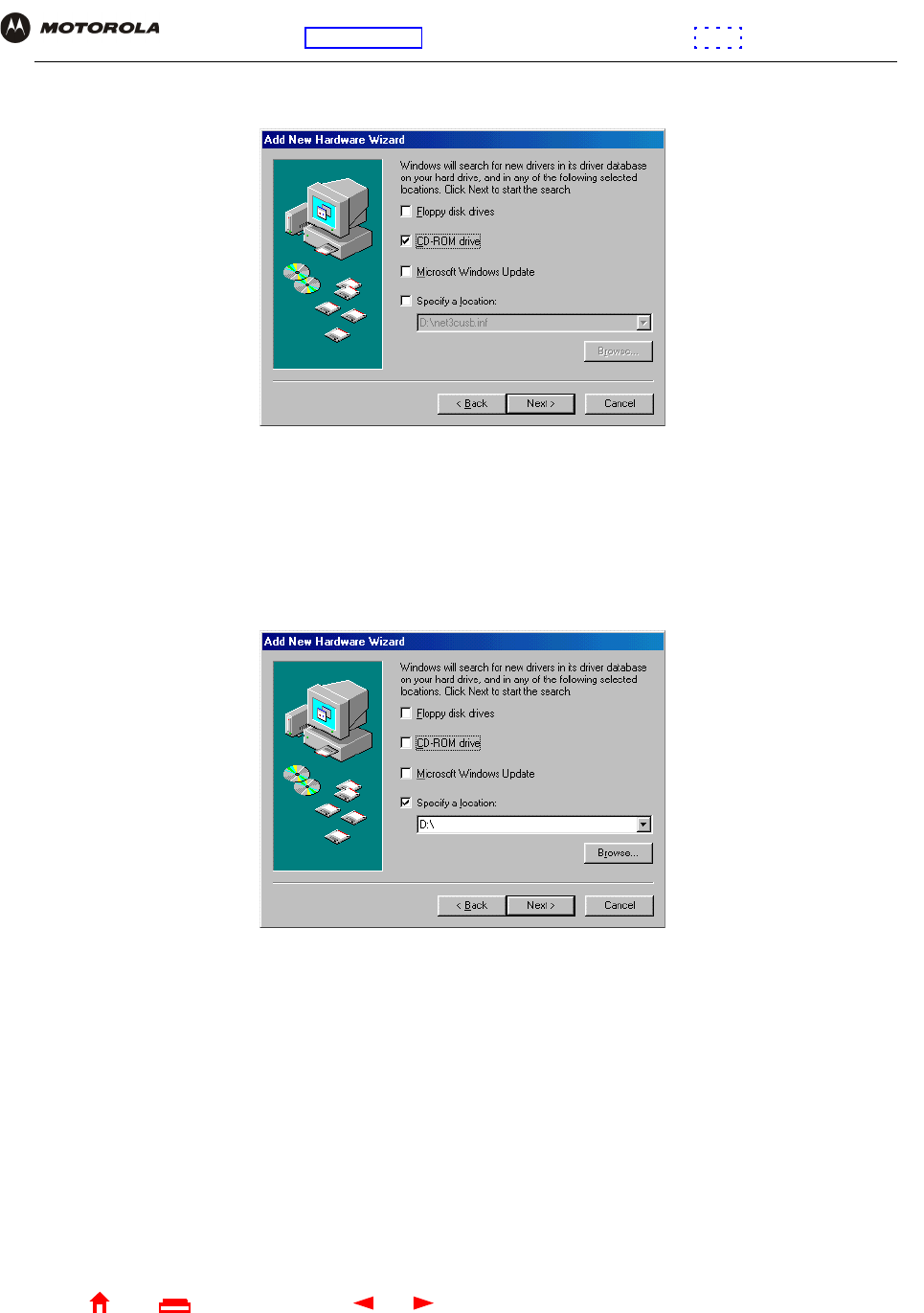
88 SBG940 User Guide
Home
X
ExitPrint
Overview Installation Troubleshooting Contact FAQ Specifications Glossary License
Configuration: Basic Gateway TCP/IP Wireless USB
5Click Next. The following window is displayed:
Be sure “CD-ROM drive” is the only box selected.
6Click Next. The message “Please wait while Windows searches for a new driver for this device” is displayed.
If the computer successfully locates the driver, you can skip to step 9.
If the computer does not locate the driver, the previous window is displayed again.
7Select Specify a location and type the location of the CD-ROM drive:
To load the driver successfully, you may need to click Browse to manually select the NetMotCM.sys file on
the CD-ROM.
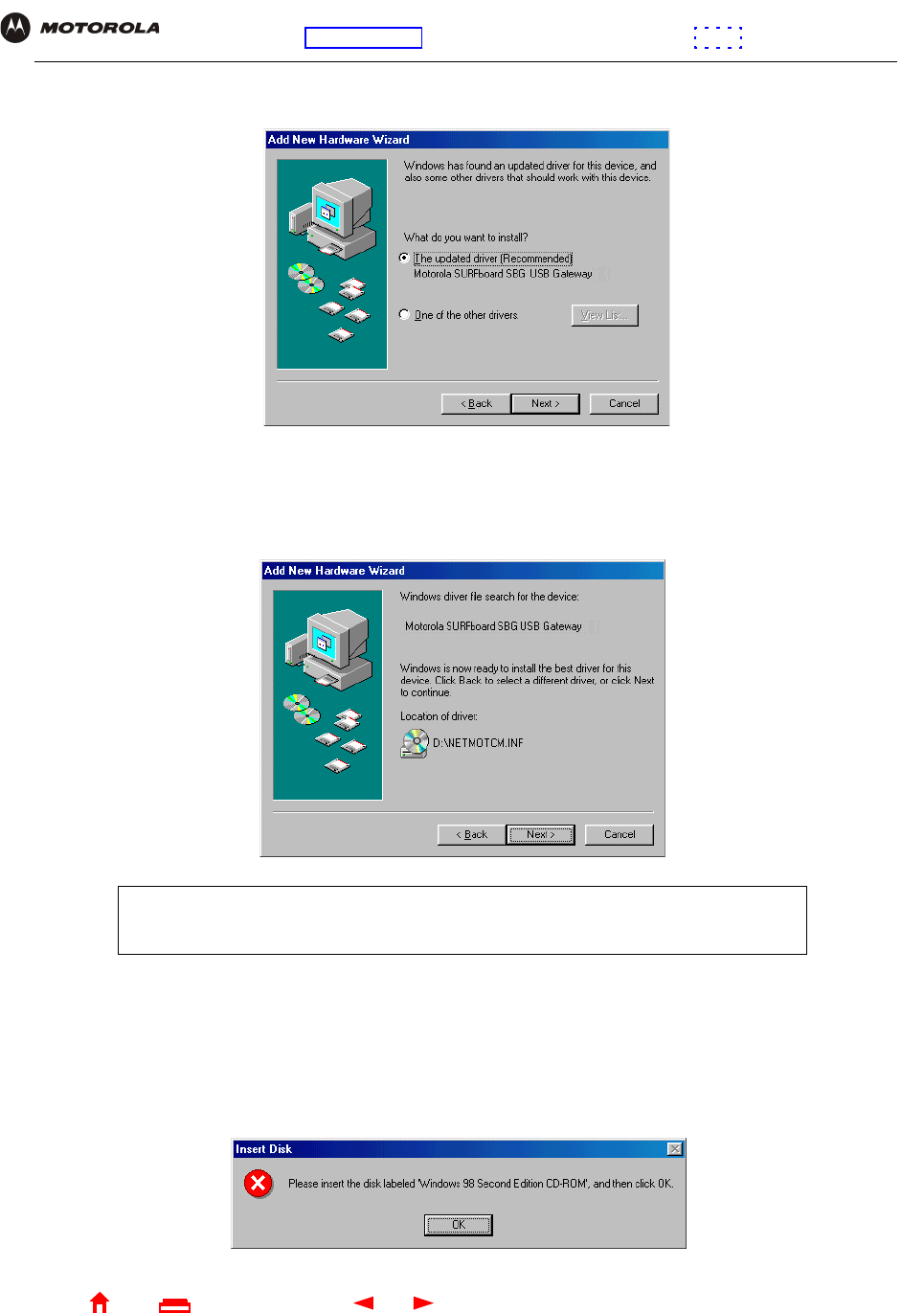
89 SBG940 User Guide
Home
X
ExitPrint
Overview Installation Troubleshooting Contact FAQ Specifications Glossary License
Configuration: Basic Gateway TCP/IP Wireless USB
8Click Next. The following window is displayed:
9Select The updated driver... and click Next. If the following window is not displayed, verify that the SBG940
Installation CD-ROM is properly inserted in the CD-ROM drive. If you still cannot find the correct driver file,
click Cancel to cancel the installation and perform the procedure for “Removing the USB Driver from
Windows 98 or Windows Me”. Then repeat this procedure.
10 After the window shown under step 9 is displayed, click Next.
If a window with the message Copying Files... displays and asks for the CD-ROM drive, type the CD-ROM
drive letter (for example, “D:”) and click OK.
If an Insert Disk window similar to the one below is displayed, Windows 98 system files are needed to
complete the installation. To install the files, insert your Windows 98 CD-ROM in the CD-ROM drive and
click OK.
Although your SBG model number may be different than in the images in this guide,
the procedure is the same.
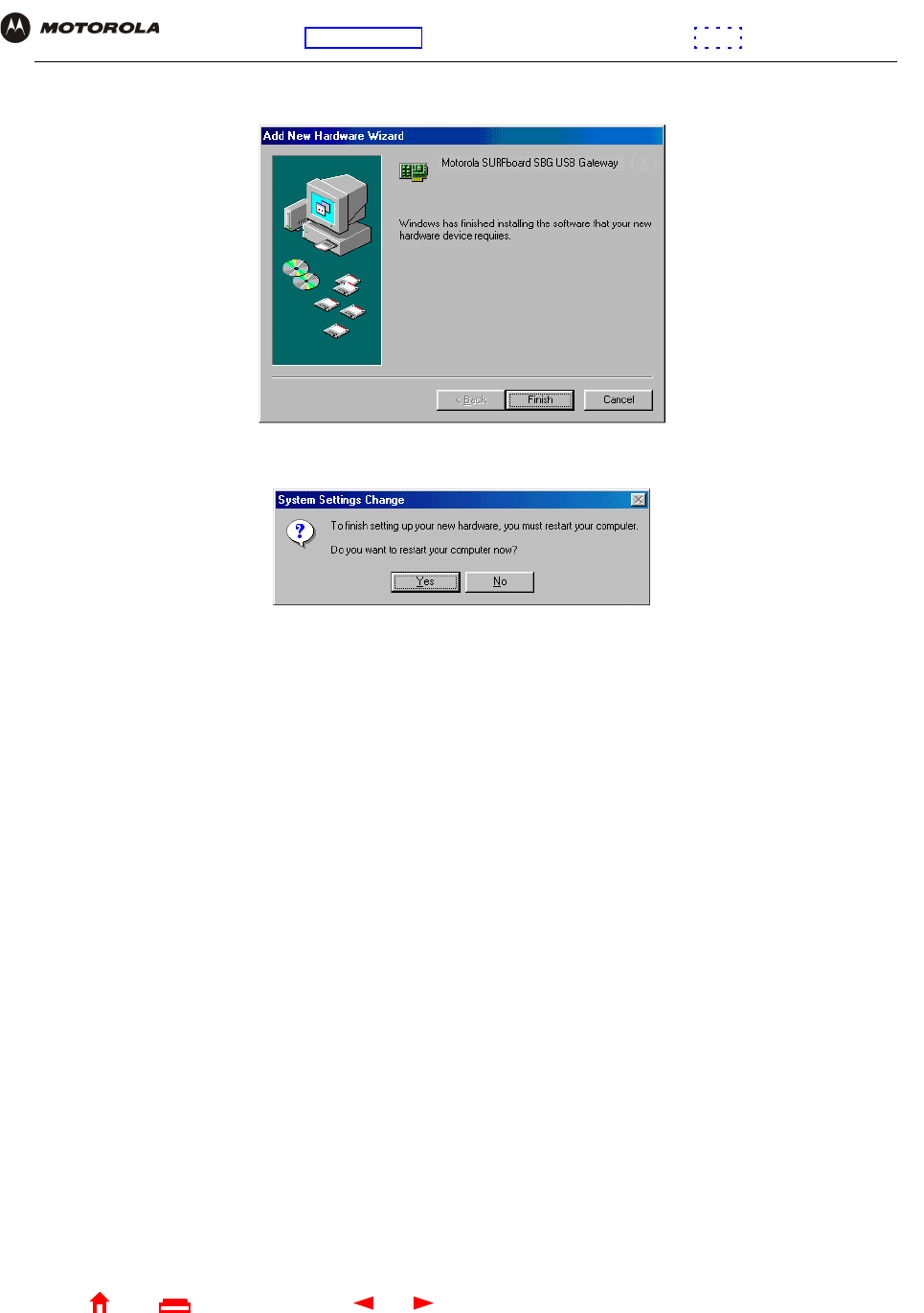
90 SBG940 User Guide
Home
X
ExitPrint
Overview Installation Troubleshooting Contact FAQ Specifications Glossary License
Configuration: Basic Gateway TCP/IP Wireless USB
After all the necessary files are loaded, the following window is displayed to confirm a successful installation:
11 Click Finish. The Systems Settings Change window is displayed:
12 Click Yes to restart the computer.
When you finish setting up the USB driver, you can continue with “Configuring TCP/IP”.
If you have difficulties setting up the USB driver, perform “Removing the USB Driver from Windows 98 or
Windows Me” and repeat this procedure. If that does not correct the problem, see the Regulatory, Safety, Software
License, and Warranty Information card provided with the SBG940 for information about obtaining warranty
service.
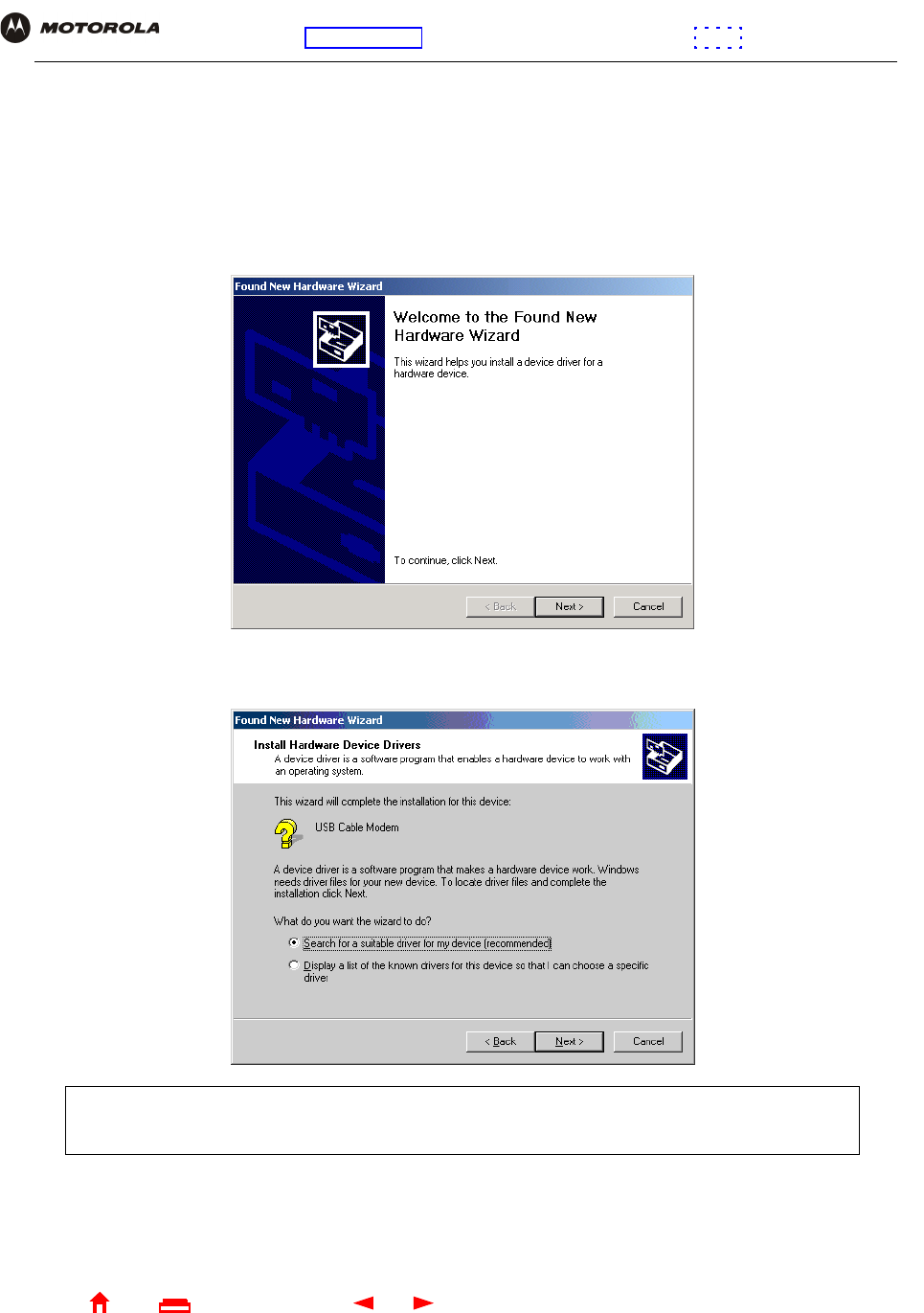
91 SBG940 User Guide
Home
X
ExitPrint
Overview Installation Troubleshooting Contact FAQ Specifications Glossary License
Configuration: Basic Gateway TCP/IP Wireless USB
Setting Up a USB Driver in Windows 2000
1Insert the SBG940 Installation CD-ROM in the CD-ROM drive. This CD contains the USB drivers and must be
inserted and read by the PC before you connect the SBG940 to the PC.
2Connect the USB cable as shown in USB Connection.
A few seconds after you complete the USB connection, the Found New Hardware window is displayed:
3Click Next. The following window is displayed:
Be sure “Search for a suitable driver for my device” is selected.
Although your SBG model number may be different than in the images in this guide, the procedure is
the same.
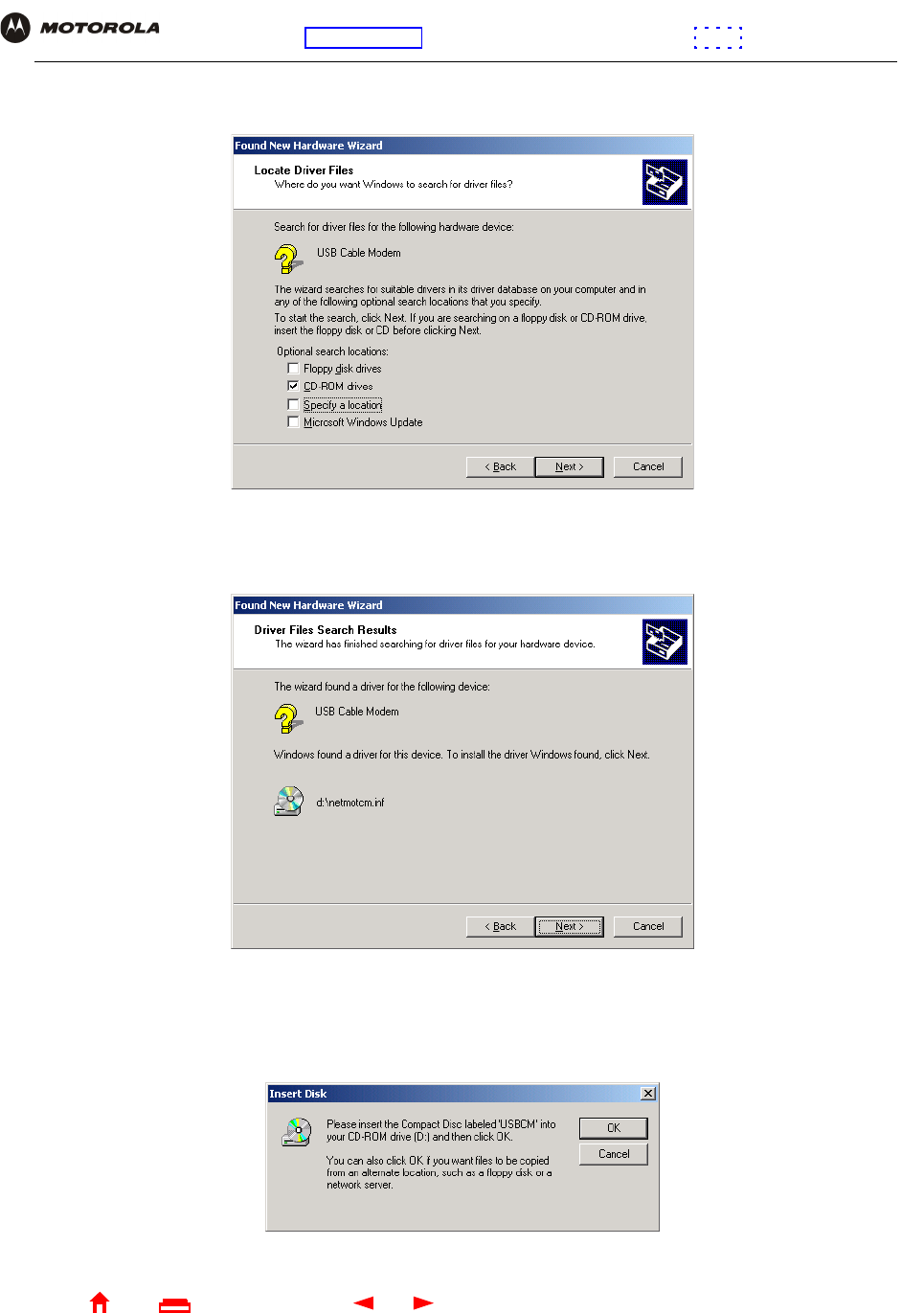
92 SBG940 User Guide
Home
X
ExitPrint
Overview Installation Troubleshooting Contact FAQ Specifications Glossary License
Configuration: Basic Gateway TCP/IP Wireless USB
4Click Next. The following window is displayed:
Be sure “CD-ROM drives” is the only box selected.
5Click Next. The following window is displayed:
6Click Next.
If the Insert Disk window is displayed, be sure the SBG940 Installation CD-ROM is in the CD-ROM drive and
follow steps 7 to 12. Otherwise, you can skip to step 13.
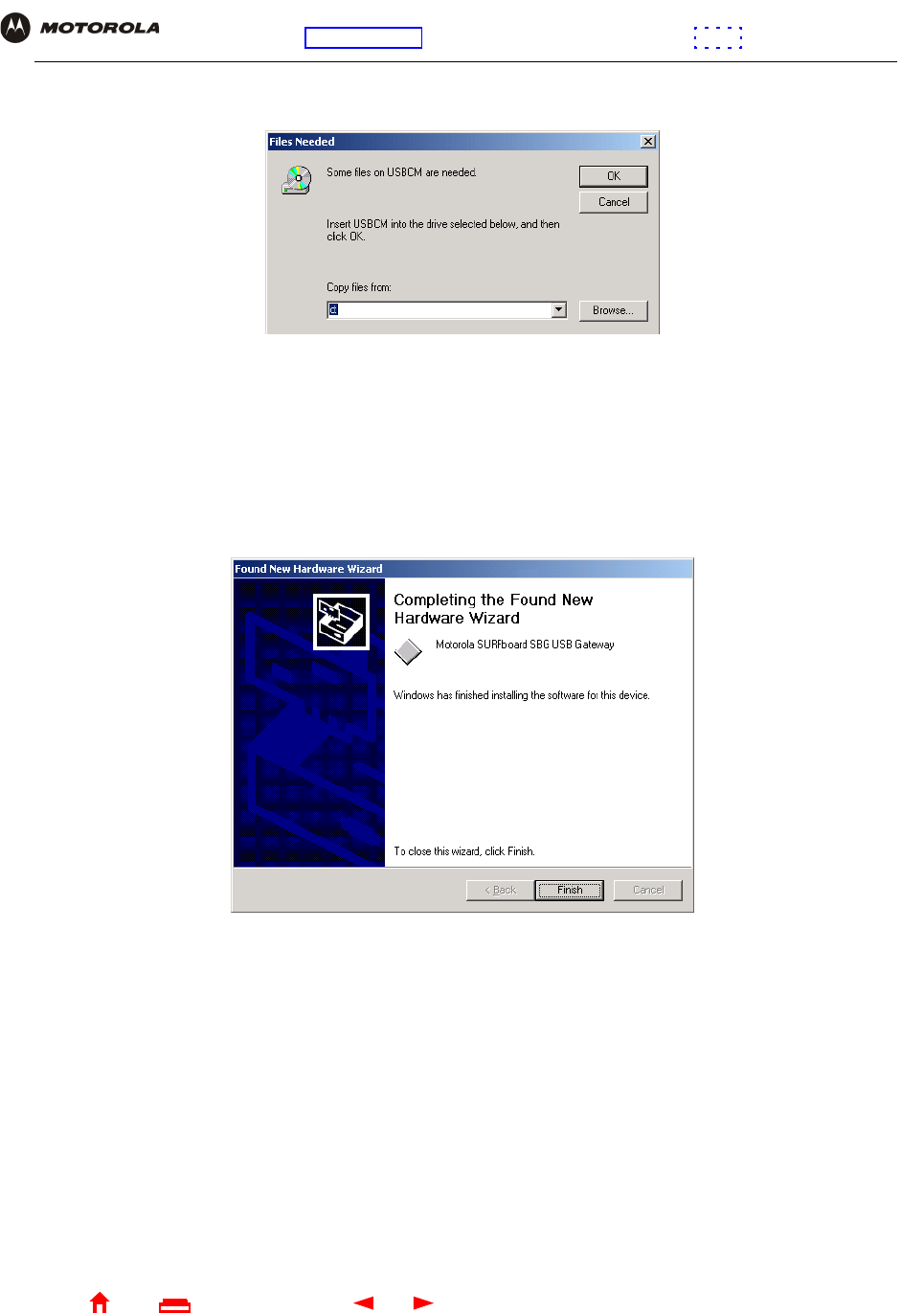
93 SBG940 User Guide
Home
X
ExitPrint
Overview Installation Troubleshooting Contact FAQ Specifications Glossary License
Configuration: Basic Gateway TCP/IP Wireless USB
7On the Insert Disk window, click OK. The Files Needed window is displayed:
8If necessary, select the CD-ROM drive in the Copy files from list.
9Click Browse.
10 Locate the NetMotCM.sys file in the CD-ROM root directory.
11 Double-click the NetMotCM.sys file. The Files Needed window is displayed.
12 Click OK. The Found New Hardware Wizard window is displayed:
13 Click Finish to complete the installation.
When you finish setting up the USB driver, you can continue with “Configuring TCP/IP”.
If you have any difficulties setting up the USB driver, perform “Removing the USB Driver from Windows 2000” and
repeat this procedure.
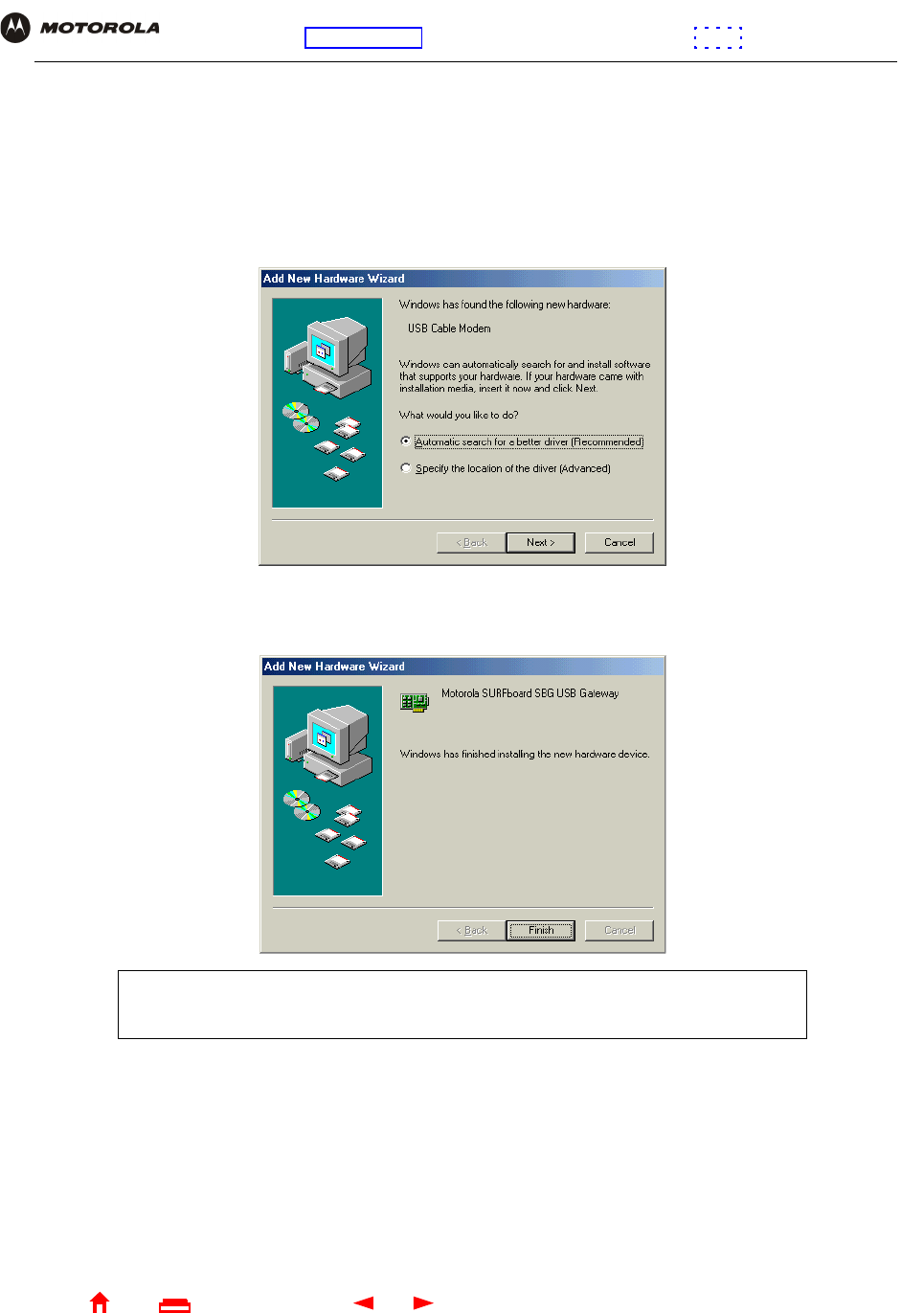
94 SBG940 User Guide
Home
X
ExitPrint
Overview Installation Troubleshooting Contact FAQ Specifications Glossary License
Configuration: Basic Gateway TCP/IP Wireless USB
Setting Up a USB Driver in Windows Me
1Insert the SBG940 Installation CD-ROM in the CD-ROM drive. This CD contains the USB drivers and must be
inserted and read by the PC before you connect the SBG940 to the PC.
2Connect the USB cable as shown in USB Connection.
A few seconds after you complete the USB connection, the Add New Hardware Wizard window is displayed:
3Click Next. Windows automatically searches for the correct USB drivers and installs them. If the installation is
successful, the following window is displayed:
4If the window above is displayed, click Finish. Otherwise, be sure the SBG940 Installation CD-ROM is
correctly inserted in the CD-ROM drive.
When you finish setting up the USB driver, you can continue with “Configuring TCP/IP”.
Although your SBG model number may be different than in the images in this guide,
the procedure is the same.
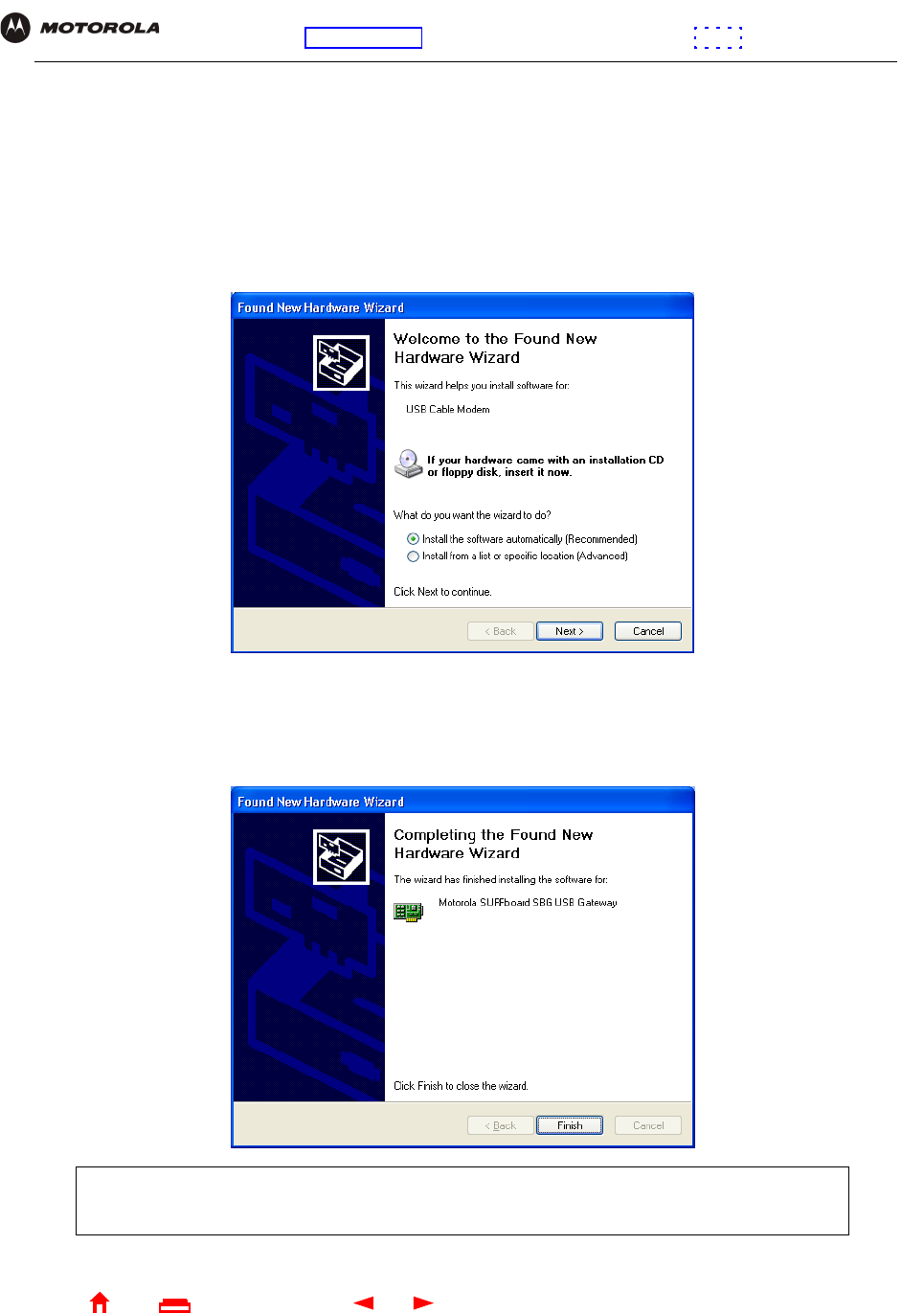
95 SBG940 User Guide
Home
X
ExitPrint
Overview Installation Troubleshooting Contact FAQ Specifications Glossary License
Configuration: Basic Gateway TCP/IP Wireless USB
Setting Up a USB Driver in Windows XP
1Insert the SBG940 Installation CD-ROM in the CD-ROM drive. This CD contains the USB drivers and must be
inserted and read by the PC before you connect the SBG940 to the PC.
2Connect the USB cable as shown in USB Connection.
A few seconds after you complete the USB connection, the Found New Hardware Wizard window is
displayed:
3Be sure “Install the software automatically” is selected.
4Click Next. Windows automatically searches for the correct USB drivers and installs them. If the installation is
successful, the following window is displayed:
Although your SBG model number may be different than in the images in this guide, the procedure
is the same.
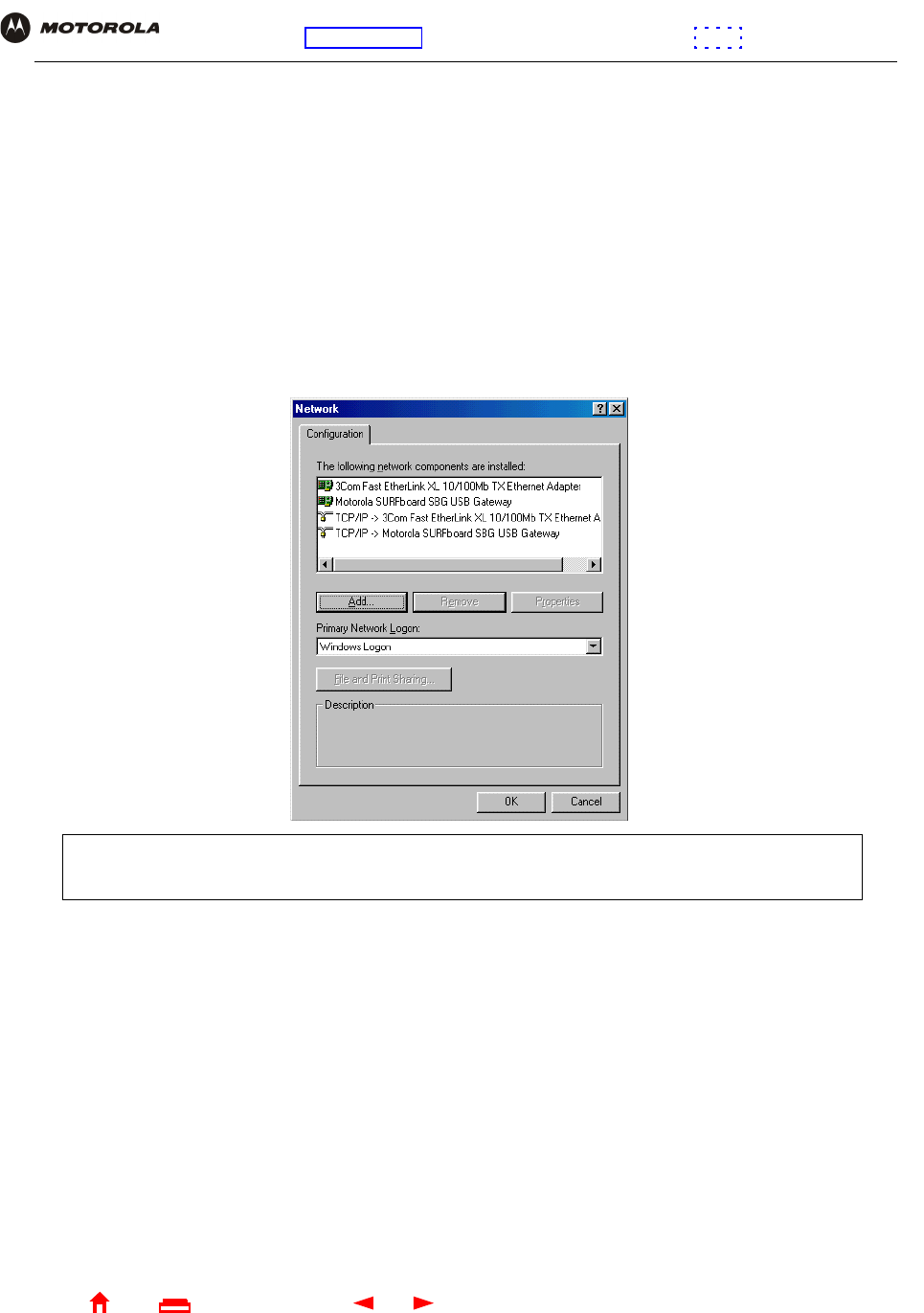
96 SBG940 User Guide
Home
X
ExitPrint
Overview Installation Troubleshooting Contact FAQ Specifications Glossary License
Configuration: Basic Gateway TCP/IP Wireless USB
5Click Finish to complete the installation. Otherwise, be sure the SBG940 Installation CD-ROM is correctly
inserted in the CD-ROM drive.
When you finish setting up the USB driver, you can continue with “Configuring TCP/IP”.
Removing the USB Driver from Windows 98 or Windows Me
1On the Windows Desktop, right-click one of:
•In Windows 98, the Network Neighborhood icon
•In Windows ME, the My Network Places icon
The Network window is displayed:
2Click the Motorola SURFboard SBG940 USB Gateway.
Although your SBG model number may be different than in the images in this guide, the procedure is
the same.
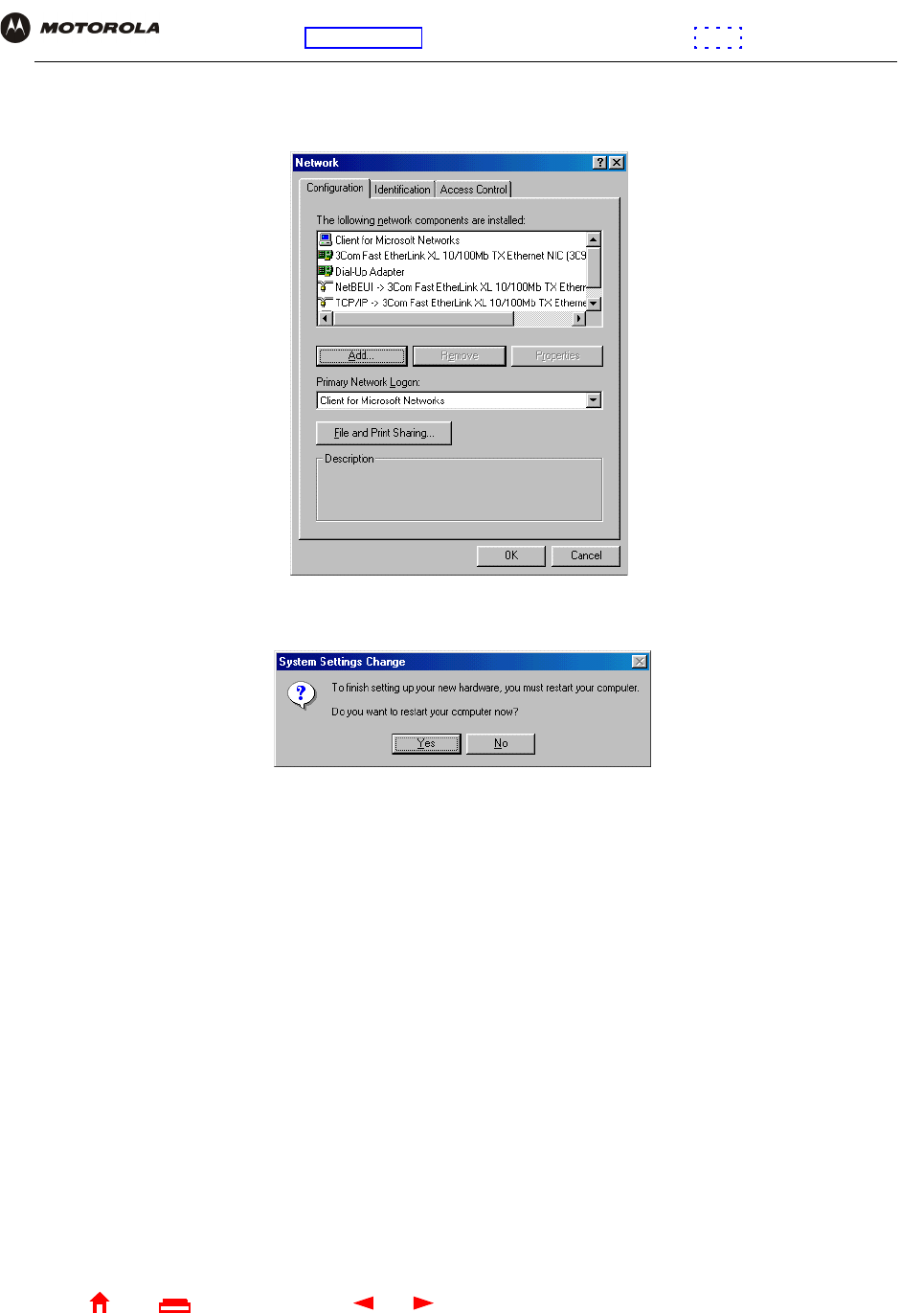
97 SBG940 User Guide
Home
X
ExitPrint
Overview Installation Troubleshooting Contact FAQ Specifications Glossary License
Configuration: Basic Gateway TCP/IP Wireless USB
3Click Remove. The Network window no longer displays Motorola SURFboard SBG940 USB Gateway in the
list:
4Click OK. The System Settings Change window is displayed:
5Disconnect the USB cable from the PC or SBG940.
6Click Yes to restart the computer.
7Insert the SBG940 Installation CD-ROM in the CD-ROM drive. After a short time, a window with language
choices is displayed.
8Press the Esc key on the keyboard to exit the start-up screens.
9To start Windows Explorer, click Start and select Run to display the Run window.
10 Type explorer and click OK.
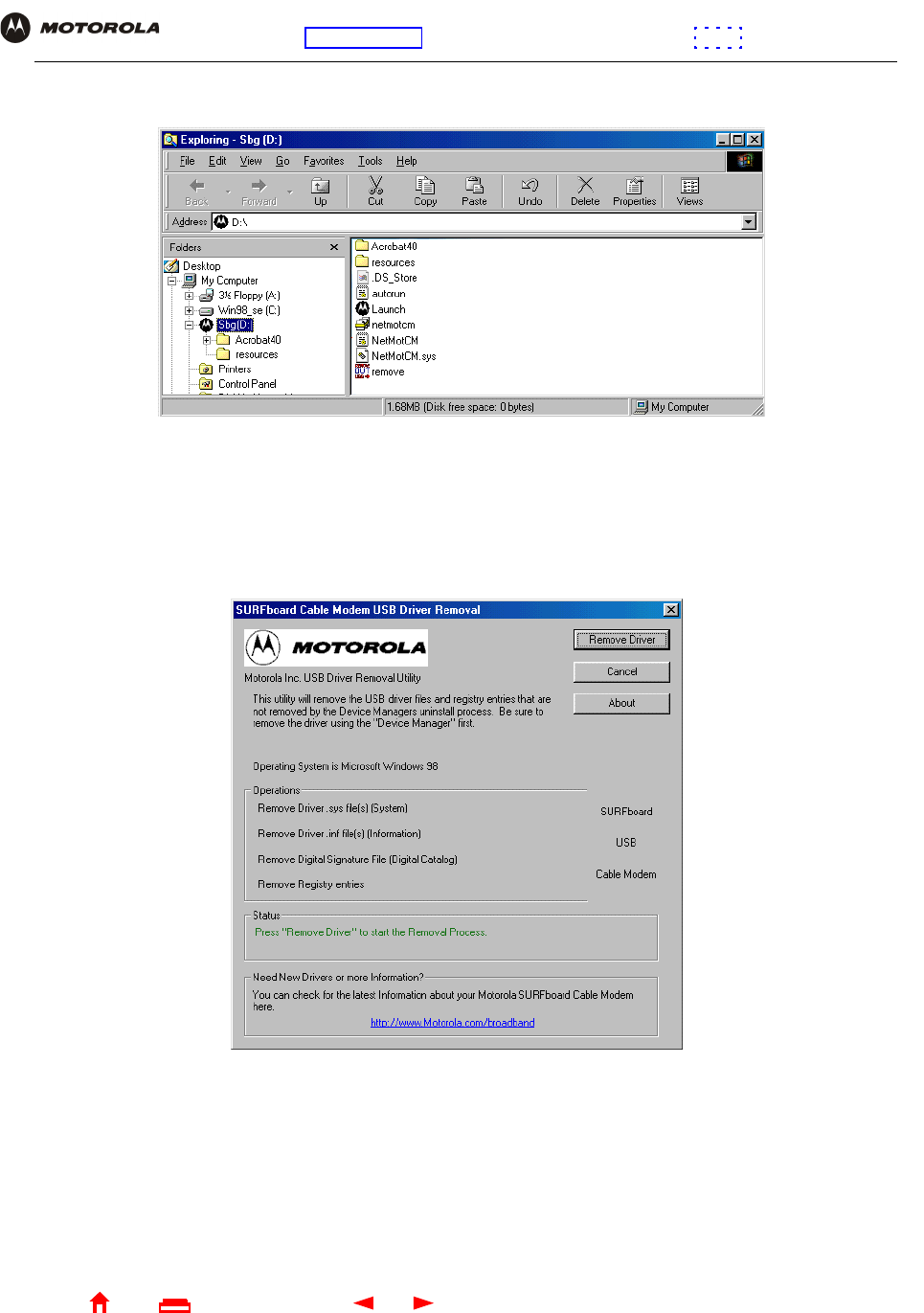
98 SBG940 User Guide
Home
X
ExitPrint
Overview Installation Troubleshooting Contact FAQ Specifications Glossary License
Configuration: Basic Gateway TCP/IP Wireless USB
The Exploring window is displayed.
Windows Explorer may appear different than in the image. There are variations between Windows versions
and you can configure Windows Explorer as you like.
11 Double-click the Motorola SBG940 CD-ROM drive (D: in the image above).
12 Double-click remove or remove.exe to run the Remove utility from the SBG940 Installation CD-ROM. The
SURFboard Cable Modem USB Driver Removal window is displayed:
13 Click Remove Driver.
After you remove the USB driver, re-install it on the computer. Perform one of:
•Setting Up a USB Driver in Windows 98
•Setting Up a USB Driver in Windows Me
If you continue to have problems, contact your cable provider.
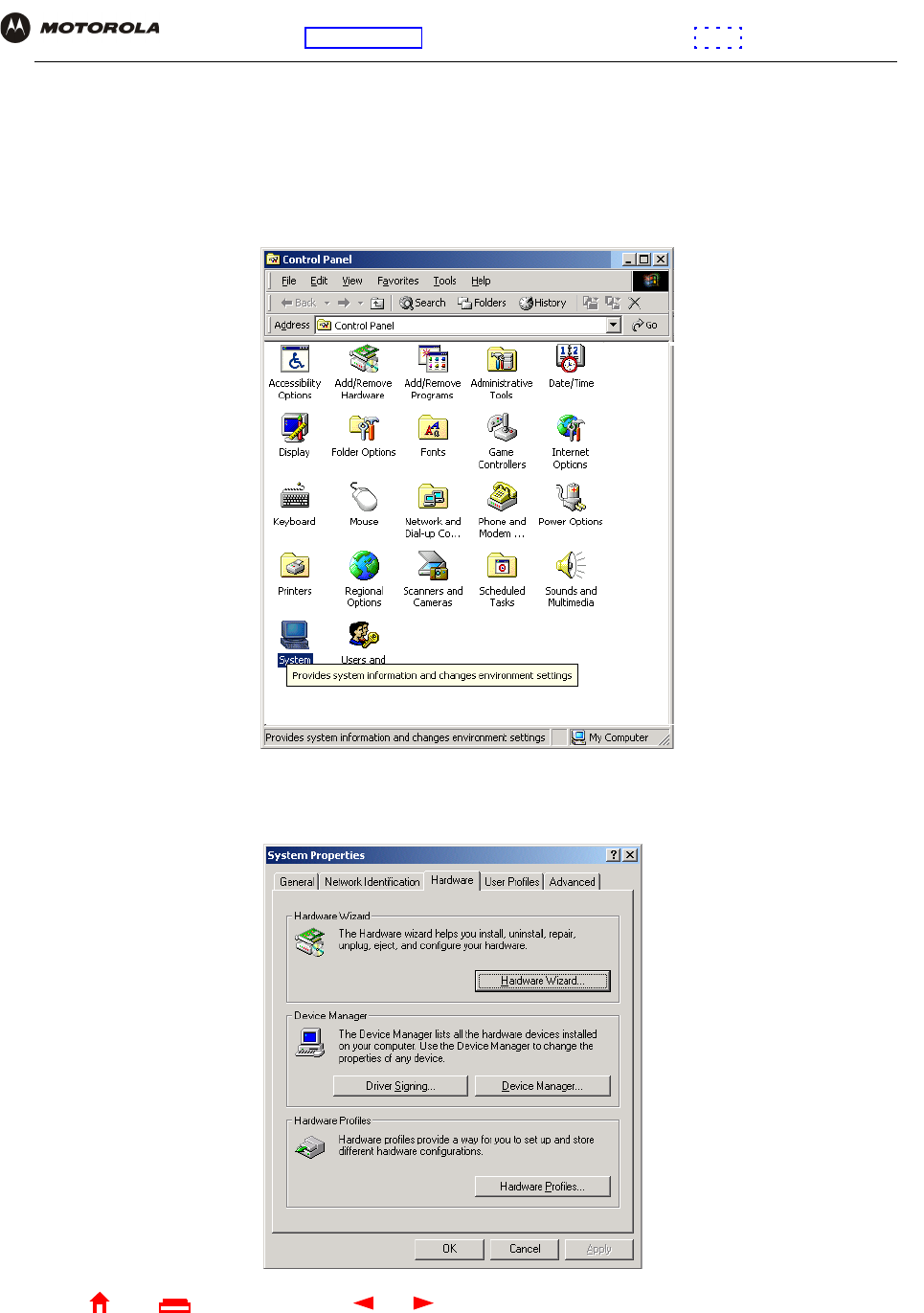
99 SBG940 User Guide
Home
X
ExitPrint
Overview Installation Troubleshooting Contact FAQ Specifications Glossary License
Configuration: Basic Gateway TCP/IP Wireless USB
Removing the USB Driver from Windows 2000
1On the Windows desktop, click Start.
2Click Settings.
3Click Control Panel to display the Control Panel window:
4Double-click System to display the System Properties window.
5Click the Hardware tab:
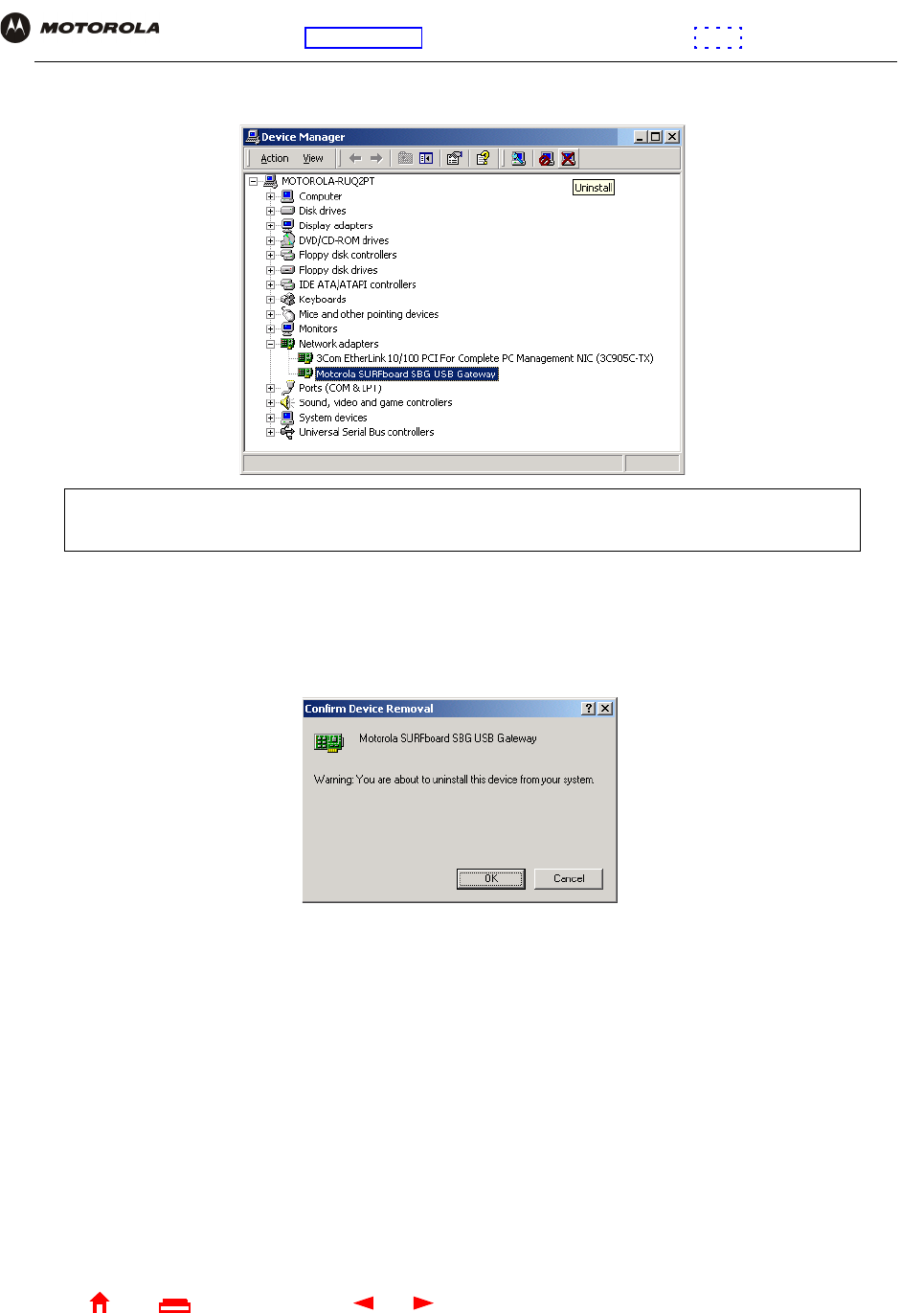
100 SBG940 User Guide
Home
X
ExitPrint
Overview Installation Troubleshooting Contact FAQ Specifications Glossary License
Configuration: Basic Gateway TCP/IP Wireless USB
6Click Device Manager to display the Device Manager window:
7Double-click Network Adapters.
8Click the Motorola SURFboard SBG940 USB Gateway. The Uninstall icon displays on the window near the
top.
9Click the Uninstall icon. The following window is displayed:
10 Click OK.
11 Close the Device Manager window.
12 Close the Control Panel window.
13 Insert the SBG940 Installation CD-ROM in the CD-ROM drive.
14 Press the Esc key on the keyboard to exit the start-up screens.
15 To start Windows Explorer, click Start and select Run to display the Run window.
Although your SBG model number may be different than in the images in this guide, the procedure is
the same.
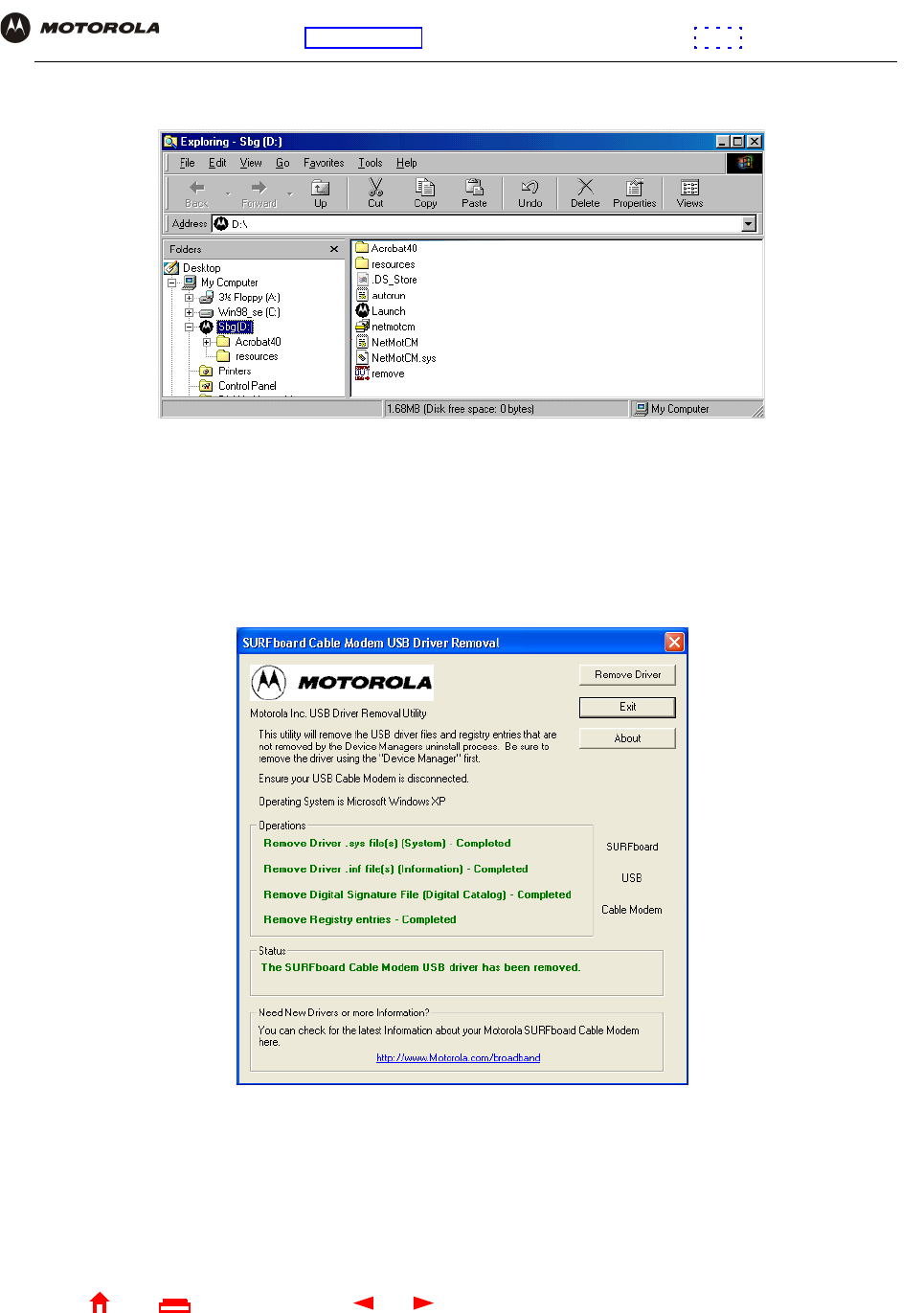
101 SBG940 User Guide
Home
X
ExitPrint
Overview Installation Troubleshooting Contact FAQ Specifications Glossary License
Configuration: Basic Gateway TCP/IP Wireless USB
16 On the Run window, type explorer and click OK to display Windows Explorer:
Windows Explorer may appear different than in the image. There are variations between Windows versions
and you can configure Windows Explorer as you like.
17 Double-click My Computer.
18 Double-click the Motorola SBG940 CD icon (D: in the image).
19 Double-click remove or remove.exe to run the Remove utility from the SBG940 Installation CD-ROM. The
SURFboard Cable Modem USB Driver Removal window is displayed:
20 Be sure the USB cable is disconnected.
21 Click Remove Driver.
Informational messages similar to the ones shown are displayed on the SURFboard Cable Modem USB
Driver Removal window.
After you remove the USB driver, re-install it following “Setting Up a USB Driver in Windows 2000”. If you continue
to have problems, contact your cable provider.
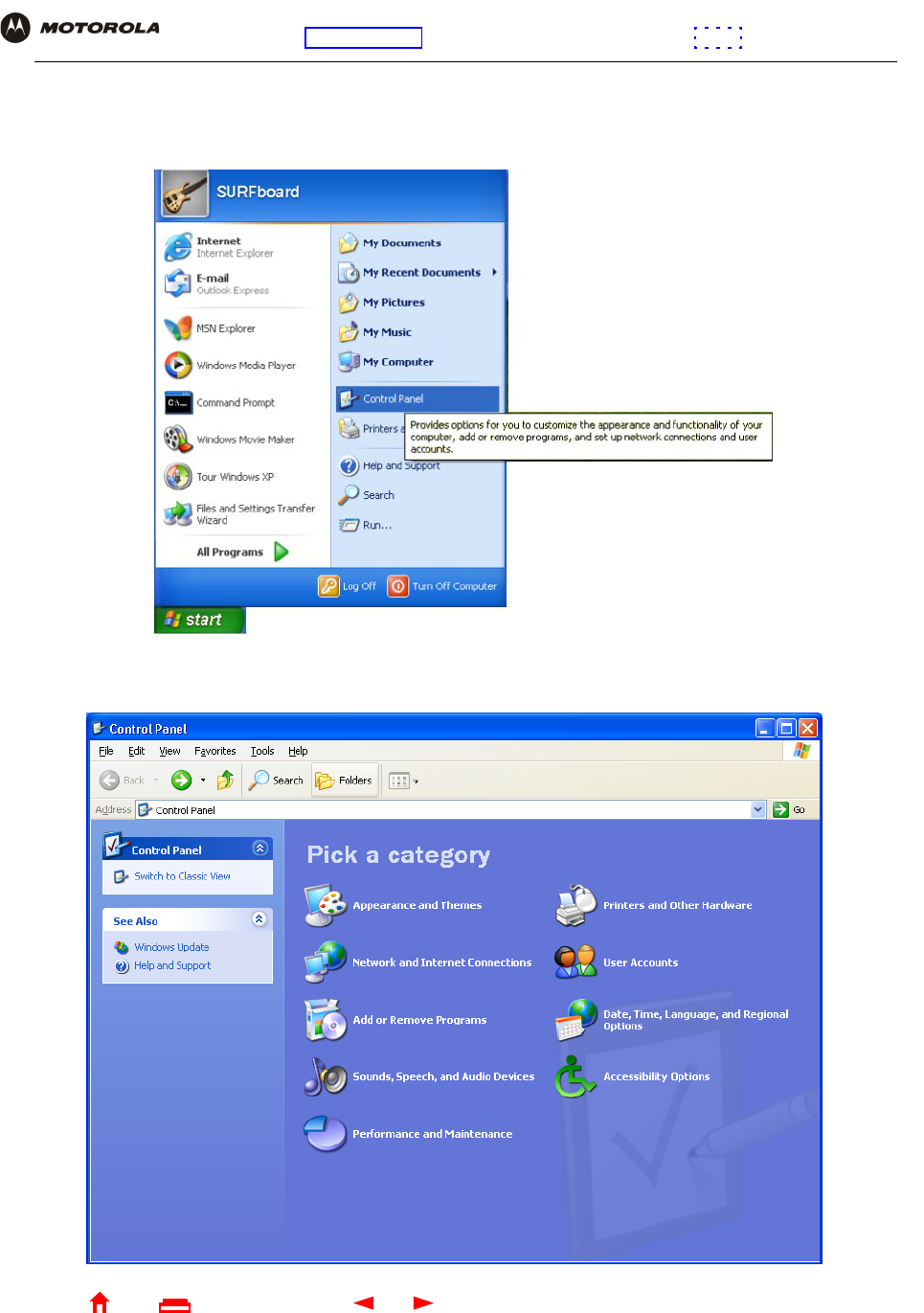
102 SBG940 User Guide
Home
X
ExitPrint
Overview Installation Troubleshooting Contact FAQ Specifications Glossary License
Configuration: Basic Gateway TCP/IP Wireless USB
Removing the USB Driver from Windows XP
1On the Windows desktop, click Start to display the Start window:
2Click Control Panel to display the Control Panel window. The display varies, depending on the Windows XP
view options:
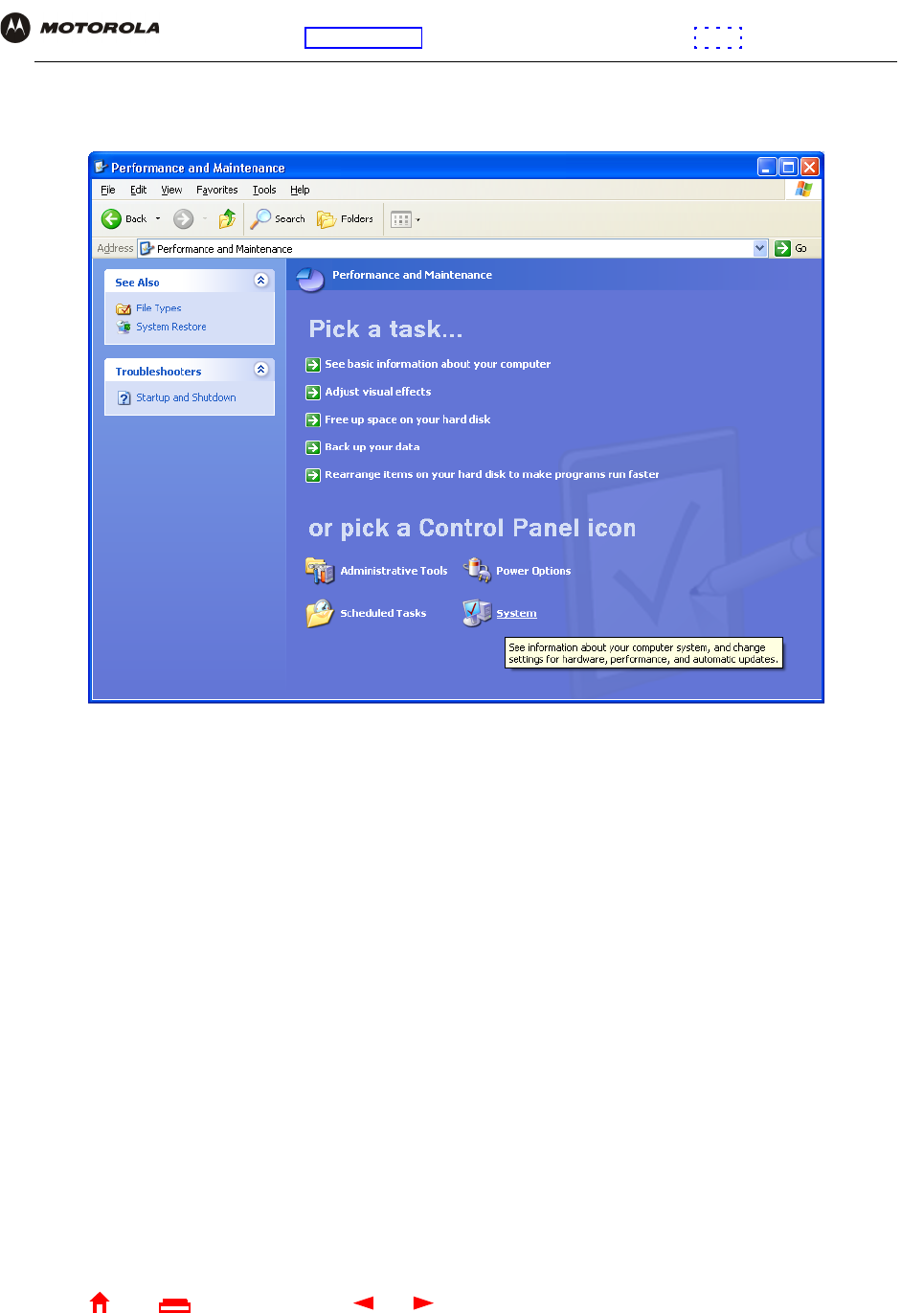
103 SBG940 User Guide
Home
X
ExitPrint
Overview Installation Troubleshooting Contact FAQ Specifications Glossary License
Configuration: Basic Gateway TCP/IP Wireless USB
3If a Category view similar to the image under step 2 is displayed, click Performance and Maintenance to
display the Performance and Maintenance window. Otherwise, skip to step 5.
4Click System to display the System Properties window. Skip to step 6.
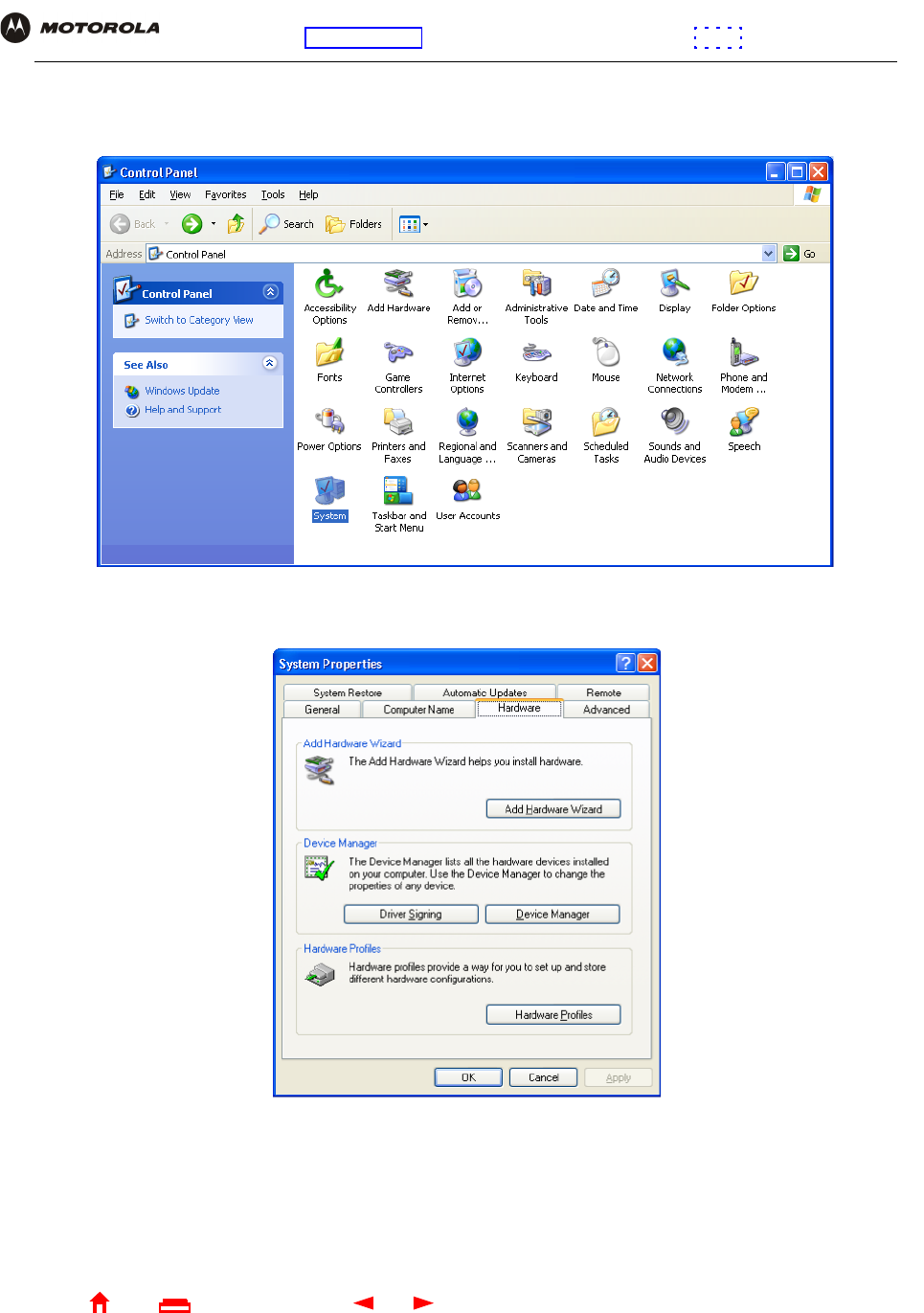
104 SBG940 User Guide
Home
X
ExitPrint
Overview Installation Troubleshooting Contact FAQ Specifications Glossary License
Configuration: Basic Gateway TCP/IP Wireless USB
5If a classic view similar to the following is displayed, double-click System to display the System Properties
window:
6Click the Hardware tab to display the Hardware page:
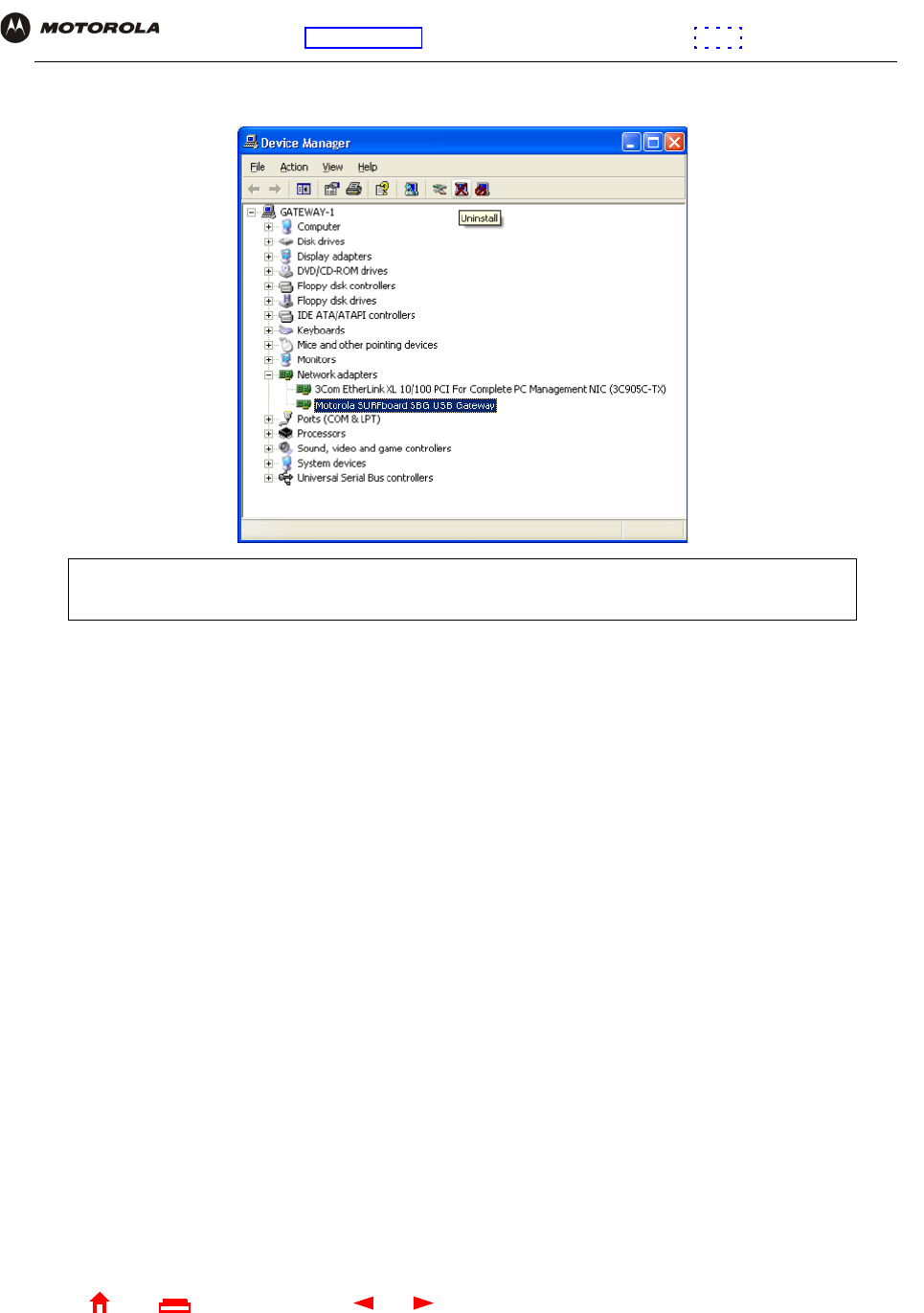
105 SBG940 User Guide
Home
X
ExitPrint
Overview Installation Troubleshooting Contact FAQ Specifications Glossary License
Configuration: Basic Gateway TCP/IP Wireless USB
7Click the Device Manager button to display the Device Manager window:
8Double-click Network adapters.
9Click the Motorola SURFboard SBG940 USB Gateway. The Uninstall icon displays on the window near the
top.
10 Click the Uninstall icon.
11 Close the Device Manager and Control Panel windows.
12 Insert the SBG940 Installation CD-ROM in the CD-ROM drive. After a short time, a window with language
choices is displayed.
13 Press the Esc key on the keyboard to exit the start-up screens.
14 To start Windows Explorer, click Start and select Run to display the Run window.
Although your SBG model number may be different than in the images in this guide, the procedure
is the same.
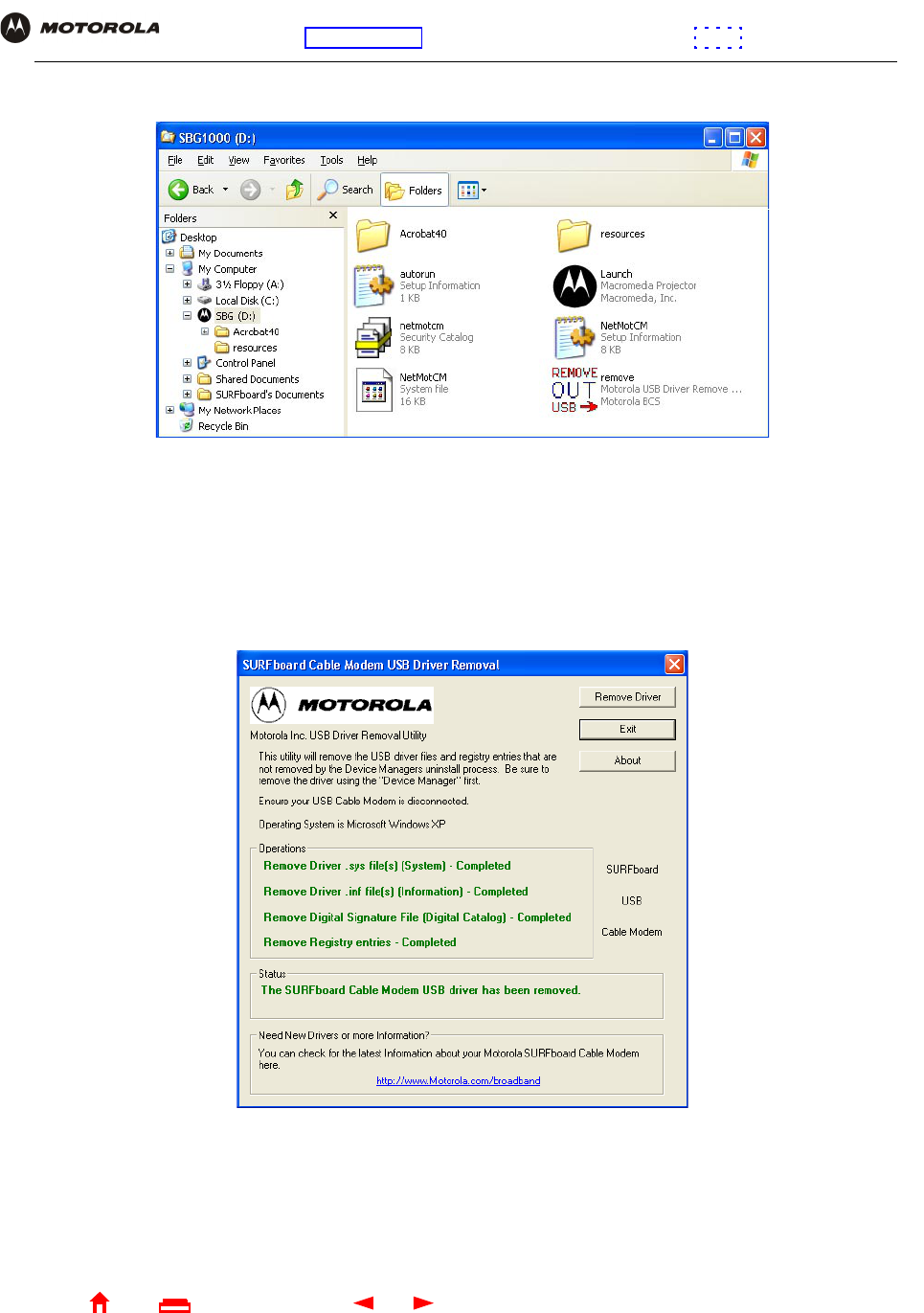
106 SBG940 User Guide
Home
X
ExitPrint
Overview Installation Troubleshooting Contact FAQ Specifications Glossary License
Configuration: Basic Gateway TCP/IP Wireless USB
15 Type explorer and click OK to display Windows Explorer.
Windows Explorer may appear slightly different than in the image. There are variations between Windows
versions and you can configure Windows Explorer as you like.
16 Double-click My Computer.
17 Double-click the Motorola CD icon (D: in the image).
18 Double-click remove or remove.exe to run the Remove utility from the SBG940 Installation CD-ROM. The
SURFboard Cable Modem USB Driver Removal window is displayed:
19 Be sure the USB cable is disconnected.
20 Click Remove Driver. Informational messages are displayed on the SURFboard Cable Modem USB Driver
Removal window.
After you remove the USB driver, re-install it following “Setting Up a USB Driver in Windows XP”. If you continue to
have problems, contact your cable provider.

107 SBG940 User Guide
Home
X
ExitPrint
Overview Installation Troubleshooting Contact FAQ Specifications Glossary License
Configuration: Basic Gateway TCP/IP Wireless USB
Troubleshooting
If the solutions listed here do not solve your problem, contact your cable provider. Before calling your cable
provider, try pressing the reset button on the rear panel. Resetting the SBG940 may take 5 to 30 minutes. Your
service provider may ask for the status of the lights as described in “Front-Panel Lights and Error Conditions”.
Problem Possible Solutions
Power light
is off
Check that the SBG940 is properly plugged into the electrical outlet.
Check that the electrical outlet is working.
Press the Reset button.
Cannot send or
receive data
On the top front panel, note which is the first light (starting from the left) that is off. This light
indicates where the error occurred as described in “Front-Panel Lights and Error Conditions.”
If you have cable TV, check that the TV is working and the picture is clear. If you cannot receive
regular TV channels, the data service will not function.
Check the coaxial cable at the SBG940 and wall outlet. Hand-tighten if necessary.
Check the IP address. Follow the steps for verifying the IP address for your system. See
Configuring TCP/IP. Call your cable provider if you need an IP address.
Check that the Ethernet cable is properly connected to the SBG940 and the computer.
Problems related to
unsuccessful USB
driver installation
Remove the USB driver. Follow the appropriate procedure for your system in “Setting Up a
USB Driver”.
The SBG940 Setup
Program will not
start
The web cache is full or close to full. In Internet Explorer, choose Internet Options from the
Tools menu, and click the General tab. Click Delete Files and Clear History. Then try Starting
the SBG940 Setup Program again.
A wireless client(s)
cannot send or
receive data
Perform the first four checks in “Cannot send or receive data.”
Check the Security Mode setting on the Wireless > SECURITY — basic Page:
•If you enabled WPA and configured a passphrase on the SBG940, be sure each affected
wireless client has the identical passphrase. If this does not solve the problem, check
whether the wireless client supports WPA.
•If you enabled WEP and configured a key on the SBG940, be sure each affected wireless
client has the identical WEP key. If this does not solve the problem, check whether the client
wireless adapter supports the type of WEP key configured on the SBG940.
•To temporarily eliminate the Security Mode as a potential issue, select None and click Apply.
After resolving your problem, be sure to re-enable wireless security.
On the Wireless > SECURITY — advanced Page:
•Check whether you turned on Disable ESSID Broadcast. If it is on, be sure the network
name (ESSID) on each affected wireless client is identical to the ESSID on the SBG940.
•Check whether you enabled Allow Only Listed Stations Access. If you did, be sure the
MAC address for each affected wireless client is correctly listed.
For detailed information, see “Setting Up Your Wireless LAN”.
Slow wireless
transmission speed
with WPA enabled
On the Wireless > SECURITY — basic Page, check whether the WPA Encryption type is
TKIP. If all of your wireless clients support AES, change the WPA Encryption to AES as
described in step 4 in “Configuring WPA on the SBG940”.

108 SBG940 User Guide
Home
X
ExitPrint
Overview Installation Troubleshooting Contact FAQ Specifications Glossary License
Configuration: Basic Gateway TCP/IP Wireless USB
Front-Panel Lights and Error Conditions
Light Turns Off During Startup If Turns Off During Normal Operation If
DS The downstream receive channel cannot be acquired The downstream channel is lost
US The upstream send channel cannot be acquired The upstream channel is lost
IP registration is unsuccessful The IP registration is lost
The SBG940 is not properly plugged into the power outlet The SBG940 is unplugged

109 SBG940 User Guide
Home
X
ExitPrint
Overview Installation Troubleshooting Contact FAQ Specifications Glossary License
Configuration: Basic Gateway TCP/IP Wireless USB
Contact Us
In the United States and Canada, if you need assistance while working with the SBG940 and related equipment
supplied by Motorola:
For information about customer service, technical support, or warranty claims, see the Regulatory, Safety,
Software License, and Warranty Information card provided with the SURFboard SBG940.
For answers to typical questions, see “Frequently-Asked Questions”.
For more information about Motorola consumer cable products, education, and support, visit
http://broadband.motorola.com/consumers.
If you rent or lease your SBG940 Contact your cable provider.
If you own your SBG940 Call 1-877-466-8646 for technical and warranty support. Support is available
24 hours a day, seven days a week.

110 SBG940 User Guide
Home
X
ExitPrint
Overview Installation Troubleshooting Contact FAQ Specifications Glossary License
Configuration: Basic Gateway TCP/IP Wireless USB
Frequently-Asked Questions
Here are answers to questions our customers frequently ask:
Q What is high-speed cable Internet access?
A Cable Internet access uses cable television wires instead of telephone lines to connect to the Internet. It is
extremely fast and does not tie up telephone lines for incoming or outgoing calls and faxes.
Q How fast is the Motorola SURFboard Cable Modem Gateway SBG940?
A Cable modems offer Internet access at speeds up to 100 times faster than a traditional phone modem. You
can experience speeds of over 1,000 Kbps. Due to network condition such as traffic volume and the speed of
the sites you visit, actual speed may vary. Many network and other factors can affect download speeds.
Q How many users can one SBG940 support?
A A single SBG940 can support up to 253 users, each assigned a unique IP address, on a Class C network.
Q What is Network Address Translation?
A NAT is a technique to translate private IP addresses on your LAN to a single IP address assigned by your
cable provider that is that is visible to outside users on the Internet.
Q What are IEEE 802.11g and IEEE 802.11b?
A They are IEEE wireless network standards.
Q What type of firewall is provided on the SBG940?
A The SBG940 provides a stateful-inspection firewall. For more information, see “Firewall” and “Setting the
Firewall Policy”.
Q What wireless security measures are provided on the SBG940?
A To protect data transmitted over wireless connections, the SBG940 supports WPA or WEP encryption and
MAC access control lists. For information, see “Wireless Security” and “Setting Up Your Wireless LAN”.
Q Why is there no Standby button?
A As a security measure, current Motorola SURFboard cable modems provide a Standby button to temporarily
suspend the Internet connection. Because enabling the SBG940 firewall provides high security levels while
connected, the Standby button is not required.
Q Can I still watch cable TV while using my SBG940?
A Yes, your cable TV line can carry the TV signal while you send and receive information on the Internet.
Q What are CableLabs Certified, DOCSIS, and Euro-DOCSIS?
A CableLabs Certified, DOCSIS, and Euro-DOCSIS are the industry standards for high-speed data distribution
over cable television system networks. They are intended to ensure that all compliant cable modems
interface with all compliant cable systems. Your SBG940 is DOCSIS or Euro-DOCSIS certified.
Q If I have an SBG940, can I still use my old 28.8 Kbps or 56 Kbps modem?
A Yes you can. However, once you’ve experienced the speed of cable Internet access, you’ll never again want
to wait for traditional dial-up services.

111 SBG940 User Guide
Home
X
ExitPrint
Overview Installation Troubleshooting Contact FAQ Specifications Glossary License
Configuration: Basic Gateway TCP/IP Wireless USB
Q Do I need to change my Internet service provider (ISP)?
A Currently, most Internet service providers do not provide cable Internet access. Contact your cable company
for your specific information.
Q Do I need to subscribe to cable TV to get cable Internet access?
A No, but you will need to subscribe to cable Internet service. Some systems require that you subscribe to basic
service before you can get Internet access and/or offer a discount when you use your own SBG940. Check
with your local cable company for specific information.
Q What type of technical support is available?
A For questions about your Internet service, connection, or SBG940, call your cable provider.
Q What do I do if my SBG940 stops working?
A “Troubleshooting” provides tips to diagnose problems and simple solutions. If you continue to have problems,
call your cable provider.
Q Can multiple game players on the SBG940 LAN log onto the same game server and play
simultaneously with just one public IP address?
A It depends on the game server. For more information about gaming, see “Gaming Configuration Guidelines”.

112 SBG940 User Guide
Home
X
ExitPrint
Overview Installation Troubleshooting Contact FAQ Specifications Glossary License
Configuration: Basic Gateway TCP/IP Wireless USB
Specifications
Wireless
Standards compliance IEEE 802.11g, IEEE 802.11b DSSS, IEEE 802.11g OFDM
RF frequency range 2.412 to 2.462 GHz for North America
2.412 to 2.835 GHz for Japan
Data rate 1 Mbps DBPSK
2 Mbps DQPSK
5.5 or 11 Mbps CCK
6, 9, 12, 18, 24, 36, 48, or 54 Mbps OFDM
Modulation 1 Mbps DBPSK
2 Mbps DQPSK
5.5, 11 Mbps CCK
6, 9, 12, 18, 24, 36, 48, 54 Mbps OFDM
Number of channels Europe = 13, Spain = 2, France = 4, US = 11, Japan = 14
Transmit power +17 dBm (EIRP)
Receive sensitivity -65 dBm at 54 Mbps
Router
Ethernet standards
compliance
IEEE 802.3, IEEE 802.3u
Routing protocol RIP V2
Number of uplink ports 4
Electrical
Input voltage range 100 – 240 VAC, 50 – 60 Hz
Power consumption 9 watts (nominal)
Environmental
Operating temperature 0° to 40° C, -150 to 10000 ft.
Storage temperature -30° to 80° C
Humidity 5 to 95% RH, non-condensing
Antennas One external removable antenna, with a unique connector per FCC requirements
One external adjustable non-removable antenna
LED Indicators One Power, one Receive (DS), one Send (US), one Online, one Internet, one USB, one
Wireless, and four Ethernet
Interfaces One AC power, one F-type, one USB Series B, and four RJ-45
Dimensions 290 mm (11.5 in.) wide x 160 mm (5.5 in.) deep x 70 mm (2.5 in) tall
Weight 1.8 lbs (unit only)

113 SBG940 User Guide
Home
X
ExitPrint
Overview Installation Troubleshooting Contact FAQ Specifications Glossary License
Configuration: Basic Gateway TCP/IP Wireless USB
Downstream
Modulation 64 or 256 QAM
Maximum data ratea38 Mbps
Frequency range 88 to 860 MHz (30 kHz minimum step size)
Bandwidth 6 MHz
Maximum symbol rate 5.069 Msym/s (64 QAM)
5.361 Msym/s (256 QAM)
Operating level range -15 to +15 dBmV
Input impedance 75 ohms (nominal)
Frequency range 88 to 860 MHz
Upstream
Modulation QPSK or 8b, 16, 32b, 64b, or 128b QAM
Modulation rate
(nominal)
TDMA: 160, 320, 640, 1280, 2560, and 5120 KHz
S-CDMA: 1280, 2560, and 5120 KHz
Maximum data ratec30 Mbps
Bandwidth TDMA: 200, 400, 800, 1600, 3200, and 6400b kHz
S-CDMA: 1600, 3200, and 6400 kHz
Symbol rates 160, 320, 640, 1280, and 2560 ksym/s
Operating level range
(one channel)
TDMA:
•+8 to +54 dBmV (32 QAM, 64 QAM)
•+8 to +55 dBmV (8 QAM, 16 QAM)
•+8 to +58 dBmV (QPSK)
S-CDMA:
•+8 to +53 dBmV (all modulations)
Output impedance 75 ohms nominal
Frequency range 5 to 42 MHz (edge to edge)
Output return loss > 6 dB (5 to 42 MHz)
General
Cable interface F-Connector, female, 75 ohm
CPE network interface USB, Ethernet 10/100Base-T (auto sensing)
CPE wireless interface IEEE 802.11g
Data protocol TCP/IP
a. Actual speed will vary. Upload and download speeds are affected by several factors including, but not limited to
network traffic and services provided by your cable provider, computer equipment, server type, number of
connections to the server, and the availability of Internet routers.
b. With a CMTS supporting A-TDMA or S-CDMA only.
c. Actual speed will vary. Maximum speed of 30 Mbps is only attainable with A-TDMA or S-CDMA technology.

114 SBG940 User Guide
Home
X
ExitPrint
Overview Installation Troubleshooting Contact FAQ Specifications Glossary License
Configuration: Basic Gateway TCP/IP Wireless USB
Glossary
This glossary defines terms and lists acronyms used with the SBG940.
To return to your previous page, click the Acrobat Go to Previous View button.
A
To return to your previous page, click the Acrobat Go to Previous View button.
access point A device that provides WLAN connectivity to wireless clients (stations). The SBG940 acts as a
wireless access point.
adapter A device or card that connects a computer, printer, or other peripheral device to the network or to
some other device. A wireless adapter connects a computer to the WLAN.
address
translation
See NAT.
ALG Application level gateway triggers are required by some file transfer (for example, FTP), game, and
video conferencing applications to open one or more ports to enable the application to operate
properly.
American Wire
Gauge (AWG)
A standard system used to designate the size of electrical conductors; gauge numbers are inverse to
size.
ANSI The American National Standards Institute is a non-profit, independent organization supported by
trade organizations, industry, and professional societies for standards development in the United
States. This organization defined ASCII and represents the United States to the International
Organization for Standardization.
ANX Automotive Network Exchange
ARP Address Resolution Protocol broadcasts a datagram to obtain a response containing a MAC address
corresponding to the host IP address. When it is first connected to the network, a client sends an ARP
message. The SBG940 responds with a message containing its MAC address. Subsequently, data
sent by the computer uses the SBG940 MAC address as its destination.
ASCII The American Standard Code for Information Interchange refers to alphanumeric data for processing
and communication compatibility among various devices; normally used for asynchronous
transmission.
asynchronous
timing
The SBG940 uses synchronous timing for upstream data transmissions. The CMTS broadcasts
messages that bandwidth is available. The SBG940 reserves data bytes requiring x-number of
mini-slots. The CMTS replies that it can receive data at a specified time (synchronized). At the
specified time, the SBG940 transmits the x-number of data bytes.
attenuation The difference between transmitted and received power resulting from loss through equipment,
transmission lines, or other devices; usually expressed in decibels.
authentication A process where the CMTS verifies that access is authorized, using a password, trusted IP address,
or serial number.
authorization Part of the process between a CMTS and the cable modem or gateway to enable Baseline Privacy.
auto-MDIX Automatic medium-dependent interface crossover detects and corrects cabling errors by automatically
reversing the send and receive pins on any port. It enables the use of straight-through wiring between
the SBG940 Ethernet port and any computer, printer, or hub.

115 SBG940 User Guide
Home
X
ExitPrint
Overview Installation Troubleshooting Contact FAQ Specifications Glossary License
Configuration: Basic Gateway TCP/IP Wireless USB
B
To return to your previous page, click the Acrobat Go to Previous View button.
bandwidth The transmission capacity of a medium in terms of a range of frequencies. Greater bandwidth
indicates the ability to transmit more data over a given period of time.
Baseline
Privacy
An optional feature that encrypts data between the CMTS and the cable modem or gateway.
Protection of service is provided by ensuring that a cable modem or gateway, uniquely identified by its
MAC address, can only obtain keys for services it is authorized to access.
baud The analog signaling rate. For complex modulation modes, the digital bit rate is encoded in multiple
bits per baud, for example, 64 QAM encodes 6 bits per baud and 16 QAM encodes 4 bits per baud.
BCP Binary Communication Protocol
BER The bit error rate is the ratio of the number of erroneous bits or characters received from some fixed
number of bits transmitted.
binary A numbering system that uses two digits, 0 and 1.
bit rate The number of bits (digital 0s and 1s) transmitted per second in a communications channel. It is
usually measured in bits per second bps.
BPKM Baseline Protocol Key Management encrypts data flows between a cable modem or gateway and the
CMTS. The encryption occurs after the cable modem or gateway registers to ensure data privacy
across the RF network.
bps bits per second
bridge An OSI layer 2 networking device that connects two LANs using similar protocols. It filters frames
based on the MAC address to reduce the amount of traffic. A bridge can be placed between two
groups of hosts that communicate a lot together, but not so much with the hosts in the other group.
The bridge examines the destination of each packet to determine whether to transmit it to the other
side. See also switch.
broadband High bandwidth network technology that multiplexes multiple, independent carriers to carry voice,
video, data, and other interactive services over a single cable. A communications medium that can
transmit a relatively large amount of data in a given time period. A frequently used synonym for cable
TV that can describe any technology capable of delivering multiple channels and services.
broadcast Simultaneous transmission to multiple network devices; a protocol mechanism supporting group and
universal addressing. See also multicast and unicast.

116 SBG940 User Guide
Home
X
ExitPrint
Overview Installation Troubleshooting Contact FAQ Specifications Glossary License
Configuration: Basic Gateway TCP/IP Wireless USB
C
To return to your previous page, click the Acrobat Go to Previous View button.
CableHome A project of CableLabs and technology suppliers to develop interface specifications for extending
high-quality cable-based services to home network devices. It addresses issues such as device
interoperability, QoS, and network management. CableHome will enable cable service providers to
offer more services over HFC. It will improve consumer convenience by providing cable-delivered
services throughout the home.
CableLabs A research consortium that defines the interface requirements for cable modems and acknowledges
that tested equipment complies with DOCSIS.
cable modem A device installed at a subscriber location to provide data communications over an HFC network.
Unless otherwise specified, all references to “cable modem” in this documentation refers to DOCSIS
or Euro-DOCSIS cable modems only.
cable modem
configuration
file
File containing operational parameters that a cable modem or gateway downloads from the cable
provider TFTP server during registration.
circuit-switched Network-connection scheme used in the traditional PSTN telephone network where each connection
requires a dedicated path for its duration. An alternative is packet-switched.
Class C network An IP network containing up to 253 hosts. Class C IP addresses are in the form
“network.network.network.host.”
client In a client/server architecture, a client is a computer that requests files or services such as file transfer,
remote login, or printing from the server. Also called a CPE.
On a WLAN, a client is any host that can communicate with the access point. A wireless client is also
called a “station.”
CMTS A cable modem termination system is a device in the cable system headend that interfaces the HFC
network to local or remote IP networks to connecting IP hosts, cable modems or gateways, and
subscribers. It manages all cable modem bandwidth. It is sometimes called an edge router.
CNR carrier to noise ratio
coaxial cable
(coax)
A type of cable consisting of a center wire surrounded by insulation and a grounded shield of braided
wire. The shield minimizes electrical and radio frequency interference. Coaxial cable has high
bandwidth and can support transmission over long distances.
CoS Class of service traffic management or scheduling functions are performed when transferring data
upstream or downstream on HFC.
CPE Customer premise equipment, typically computers, printers, etc., are connected to the cable modem
or gateway at the subscriber location. CPE can be provided by the subscriber or the cable provider.
Also called a client.
crosstalk Undesired signal interfering with the desired signal.
CSMA/CD carrier sense multiple access with collision detection

117 SBG940 User Guide
Home
X
ExitPrint
Overview Installation Troubleshooting Contact FAQ Specifications Glossary License
Configuration: Basic Gateway TCP/IP Wireless USB
D
datagram In RFC 1594, a datagram is defined as “a self-contained, independent entity of data carrying sufficient
information to be routed from the source to the destination computer without reliance on earlier
exchanges between this source and destination computer and the transporting network.” For the most
part, it has been replaced by the term packet.
default route The route by which packets are forwarded when other routes in the routing table do not apply.
dB decibel
dBc Signal level expressed in dB relative to the unmodulated carrier level desired.
DBm A unit of measurement referenced to one milliwatt across specified impedance. 0dBm = 1 milliwatt
across 75 ohms.
dBmV Signal level expressed in dB as the ratio of the signal power in a 75-ohm system to a reference power
when 1 mV is across 75 ohms.
demodulation An operation to restore a previously modulated wave and separate the multiple signals that were
combined and modulated on a subcarrier.
DHCP A Dynamic Host Configuration Protocol server dynamically assigns IP addresses to client hosts on an
IP network. DHCP eliminates the need to manually assign static IP addresses by “leasing” an
IP address and subnet mask to each client. It enables the automatic reuse of unused IP addresses:
The SBG940 is simultaneously a DHCP client and a DHCP server.
•A DHCP server at the cable system headend assigns a public IP address to the SBG940 and
optionally to clients on the SBG940 LAN.
•The SBG940 contains a built-in DHCP server that assigns private IP addresses to clients.
distortion An undesired change in signal waveform within a transmission medium. A nonlinear reproduction of
the input waveform.
DMZ A “de-militarized zone” is one or more hosts logically located between a private LAN and the Internet.
A DMZ prevents direct access by outside users to private data. (The term comes from the geographic
buffers located between some conflicting countries such as North and South Korea.) In a typical small
DMZ configuration, the DMZ host receives requests from private LAN users to access external web
sites and initiates sessions for these requests. The DMZ host cannot initiate a session back to the
private LAN. Internet users outside the private LAN can access only the DMZ host. You can use a
DMZ to set up a web server or for gaming without exposing confidential data.
DNS The Domain Name System is the Internet system for converting domain names to IP addresses. A
DNS server contains a table matching domain names such as Internetname.com to IP addresses
such as 192.169.9.1. When you access the world-wide web, a DNS server translates the URL
displayed on the browser to the destination website IP address. The DNS lookup table is a distributed
Internet database; no one DNS server lists all domain name to IP address matches.
DOCSIS The CableLabs Data-Over-Cable Service Interface Specification defines interface standards for cable
modems, gateways, and supporting equipment to deliver data between an HFC network and a
computer systems or television sets. To emphasize its use as a cable modem standard, DOCSIS is
now called CableLabs Certified Cable Modems. Euro-DOCSIS is DOCSIS adapted for use in Europe.
domain name A unique name, such as motorola.com, that maps to an IP address. Domain names are typically much
easier to remember than are IP addresses.
DSSS Direct Sequence Spread Spectrum
To return to your previous page, click the Acrobat Go to Previous View button.

118 SBG940 User Guide
Home
X
ExitPrint
Overview Installation Troubleshooting Contact FAQ Specifications Glossary License
Configuration: Basic Gateway TCP/IP Wireless USB
E
To return to your previous page, click the Acrobat Go to Previous View button.
dotted-decimal
format
Method of representing an IP address or subnet mask using four decimal numbers called octets. Each
octet represents eight bits.
In a class C IP address, the octets are “network.network.network.host.” The first three octets together
represent the network address and the final octet is the host address. In the SBG940 LAN default
configuration, 192.168.100 represents the network address. In the final octet, the host address can be
from 2 to 254.
download To copy a file from one computer to another. You can use the Internet to download files from a server
to a computer. A DOCSIS or Euro-DOCSIS cable modem or gateway downloads its configuration file
from a TFTP server during start-up.
downstream In a cable data network, the direction of data received by the computer from the Internet.
driver Software that enables a computer to interact with a network or other device. For example, there are
drivers for printers, monitors, graphics adapters, modems, Ethernet, USB, HPNA, and many others.
DSL Digital Subscriber Line
DSSS Direct Sequence Spread Spectrum is an IEEE 802.11b RF modulation protocol.
dynamic IP
address
An IP address that is temporarily leased to a host by a DHCP server. The opposite of static IP
address.
encapsulate To include data into some other data unit to hide the format of the included data.
encode To alter an electronic signal so that only an authorized user can unscramble it to view the information.
encrypt To encode data.
endpoint A VPN endpoint terminates the VPN at the router so that computers on the SBG940 LAN do not need
VPN client software to tunnel through the Internet to the VPN server.
ESSID The Extended Service Set Identifier or network name is a unique identifier that wireless clients use to
associate with an access point to distinguish between multiple WLANs in the same area. All clients on
a WLAN must have the same ESSID as the access point. On the SBG940, you can set the ESSID on
the Wireless > NETWORK page.
Ethernet The most widely used LAN type, also known as IEEE 802.3. The most common Ethernet networks are
10Base-T, which provide transmission speeds up to 10 Mbps, usually over unshielded, twisted-pair
wire terminated with RJ-45 connectors. Fast Ethernet (100Base-T) provides speeds up to 100 Mbps.
“Base” means “baseband technology” and “T” means “twisted pair cable.”’
Each Ethernet port has a physical address called the MAC address.
Euro-DOCSIS A tComLabs standard that is DOCSIS adapted for use in Europe
event A message generated by a device to inform an operator or the network management system that
something has occurred.
expansion slot A connection point in a computer where a circuit board can be inserted to add new capabilities.
EAP Extensible Authentication Protocol

119 SBG940 User Guide
Home
X
ExitPrint
Overview Installation Troubleshooting Contact FAQ Specifications Glossary License
Configuration: Basic Gateway TCP/IP Wireless USB
F
G
To return to your previous page, click the Acrobat Go to Previous View button.
FCS frame check sequence
F-type
connector
A type of connector used to connect coaxial cable to equipment such as the SBG940.
firewall A security software system on the SBG940 that enforces an access control policy between the
Internet and the SBG940 LAN.
flow A data path moving in one direction.
FEC Forward error correction is a technique to correct transmission errors without requiring the transmitter
to resend any data.
FDMA Frequency Division Multiple Access is a method to allow multiple users to share a specific radio
spectrum. Each active user is assigned an individual RF channel (or carrier) with the carrier frequency
of each channel offset from its adjacent channels by an amount equal to the channel spacing, which
allows the required bandwidth per channel.
frame A unit of data transmitted between network nodes that contains addressing and protocol control data.
Some control frames contain no data.
frequency Number of times an electromagnetic signal repeats an identical cycle in a unit of time, usually one
second, measured in Hz, kHz, MHz, or GHz.
FTP File Transfer Protocol is a standard Internet protocol for exchanging files between computers. FTP is
commonly used to download programs and other files to a computer from web pages on Internet
servers.
full-duplex The ability to simultaneously transmit and receive data. See also half-duplex.
gain The extent to which a signal is boosted. A high gain antenna increases the wireless signal level to
increase the distance the signal can travel and remain usable.
gateway A device that enables communication between networks using different protocols. See also router.
The SBG940 enables up to 253 computers supporting IEEE 802.11b, Ethernet, or USB to share a
single broadband Internet connection.
gateway IP
address
The address of the default gateway router on the Internet. Also known as the “giaddr.”
GHz Gigahertz — one billion cycles per second.
GUI graphical user interface

120 SBG940 User Guide
Home
X
ExitPrint
Overview Installation Troubleshooting Contact FAQ Specifications Glossary License
Configuration: Basic Gateway TCP/IP Wireless USB
H
To return to your previous page, click the Acrobat Go to Previous View button.
H.323 A suite of protocols created by the ITU for interactive video-conferencing, data sharing, and audio
applications such as VoIP.
half-duplex Network where only one device at a time can transmit data. See also full-duplex.
headend A location that receives TV programming, radio programming, data, and telephone calls that it
modulates onto the HFC network. It also sends return data and telephone transmissions. Headend
equipment includes transmitters, preamplifiers, frequency terminals, demodulators, modulators, and
other devices that amplify, filter, and convert incoming broadcast TV signals to wireless and cable
channels.
header The data at the beginning of a packet that identifies what is in the packet.
hexadecimal A base-sixteen numbering system that uses sixteen sequential numbers (0 to 9 and the letters A to F)
as base units before adding a new position. On computers, hexadecimal is a convenient way to
express binary numbers.
HFC A hybrid fiber/coaxial cable network uses fiber-optic cable as the trunk and coaxial cable to the
subscriber premises.
hop The interval between two routers on an IP network. The number of hops a packet traverses toward its
destination (called the hop count) is saved in the packet header. For example, a hop count of six
means the packet has traversed six routers. The packet hop count increases as the time-to-live (TTL)
value decreases.
host In IP, a host is any computer supporting end-user applications or services with full two-way network
access. Each host has a unique host number that combined with the network number forms its IP
address.
Host also can mean:
•A computer running a web server that serves pages for one or more web sites belonging to
organization(s) or individuals
•A company that provides this service
•In IBM environments, a mainframe computer
HTML Hyper Text Markup Language
hub On a LAN, a hub is a device that connects multiple hosts to the LAN. A hub performs no data filtering.
See also bridge and router. An IP hub is typically a unit on a rack or desktop.
On an HFC network, a hub is a scaled-down headend that performs some or all headend functions for
part of the system.
Hz Hertz — one cycle per second. The unit to measure the frequency that an alternating electromagnetic
signal cycles through its highest and lowest states. Used to define the bands of the electromagnetic
spectrum used in voice and data communications, or to define the bandwidth of a transmission
medium.

121 SBG940 User Guide
Home
X
ExitPrint
Overview Installation Troubleshooting Contact FAQ Specifications Glossary License
Configuration: Basic Gateway TCP/IP Wireless USB
I
IANA The Internet Numbering Address Authority (IANA) is an organization under the Internet Architecture
Board (IAB) of the Internet Society that oversees IP address allocation. It is under a contract from the
U.S. government.
ICMP Internet Control Message Protocol is a protocol used for error, problem, and informational messages
sent between IP hosts and gateways. ICMP messages are processed by the IP software and are not
usually apparent to the end-user.
ICSA The International Computer Security Association is the security industry’s main source of research,
intelligence, and product certification.
IEEE The Institute of Electrical and Electronics Engineers, Inc. (http://www.ieee.org) is an organization that
produces standards, technical papers, and symposiums for the electrical and electronic industries and
is accredited by ANSI.
IEEE 802.11b
IEEE 802.11g
IEEE wireless network standards.
IEEE 802.3 See Ethernet.
IETF The Internet Engineering Task Force (http://www.ietf.org) is an open international community of
network designers, operators, vendors, and researchers to develop and maintain Internet architecture.
Technical working groups issue working documents called Internet-Drafts. The IETF publishes review
versions of the drafts called requests for comments (RFCs).
IGMP Internet Group Membership Protocol the Internet multicasting standard. IGMP establishes and
maintains a database of group multicast addresses and interfaces to which a multicast router forwards
multicast packets. IGMP runs between multicast hosts and their immediately-neighboring multicast
routers.
IGMP spoofing A process where a router acts as an IGMP querier for multicast hosts and an IGMP host to a multicast
router.
impedance The total opposition to AC electron current flow within a device. Impedance is typically 75 ohms for
coax cable and other CATV components.
impulse noise Noise of very short in duration, typically of the order of 10 microseconds. It is caused by electrical
transients such as voltage spikes, electric motors turning on, and lightning or switching equipment that
bleed over to the cable.
ingress noise Noise typically caused by discrete frequencies picked up by the cable plant from radio broadcasts or
an improperly grounded or shielded home appliance such as a hair dryer. Ingress is the major source
of cable system noise.
Internet A worldwide collection of interconnected networks using TCP/IP.
Internetwork A collection of interconnected networks allowing communication between all devices connected to any
network in the collection.
IP Internet Protocol is a set of standards that enable different types of computers to communicate with
one another and exchange data through the Internet. IP provides the appearance of a single,
seamless communication system and makes the Internet a virtual network.
To return to your previous page, click the Acrobat Go to Previous View button.

122 SBG940 User Guide
Home
X
ExitPrint
Overview Installation Troubleshooting Contact FAQ Specifications Glossary License
Configuration: Basic Gateway TCP/IP Wireless USB
K
To return to your previous page, click the Acrobat Go to Previous View button.
IP address A unique 32-bit value that identifies each host on a TCP/IP network. TCP/IP networks route messages
based on the destination IP address. An IP address has two parts:
•The network address is assigned by IANA.
•The SBG940 network administrator assigns a host address to each host connected to the SBG940,
automatically using its DHCP server or as a static IP address.
For a Class C network, the first 24 bits are the network address and the final 8 bits are the host
address; in dotted-decimal format it appears “network.network.network.host.”
If you enable the SBG940 DHCP client on the WAN page, the cable provider automatically assigns the
network address, subnet mask, domain name, and DNS server to provide a continuous Internet
connection.
IPSec The Internet Protocol Security protocols are IETF authentication and encryption standards for secure
packet exchange over the Internet. IPSec works at OSI layer 3 and secures everything on the
network.
IKE Internet Key Exchange
ISAKMP Internet Security Association and Key Management Protocol
ISDN Integrated Services Digital Network
ISO The International Organization for Standardization (http://www.iso.ch) is a worldwide federation of
national standards bodies from approximately 140 countries. ISO is a non-governmental organization
established in 1947 to promote the development of standardization and related activities in the world
with a view to facilitating the international exchange of goods and services, and to developing
cooperation in the spheres of intellectual, scientific, technological, and economic activity.
ISP Internet Service Provider
ITU International Telecommunications Union
kHz kilohertz — one thousand cycles per second

123 SBG940 User Guide
Home
X
ExitPrint
Overview Installation Troubleshooting Contact FAQ Specifications Glossary License
Configuration: Basic Gateway TCP/IP Wireless USB
L
To return to your previous page, click the Acrobat Go to Previous View button.
L2F Layer 2 Forwarding is an OSI layer 2 protocol that establishes a secure tunnel across the Internet to
create a virtual PPP connection between the user and the enterprise network. L2F is the most
established and stable layer 2 tunneling protocol.
L2TP Layer 2 Tunnel Protocol is a PPP extension that enables ISPs to operate VPNs. L2TP merges the
best features of the PPTP and L2F. L2TP is the emerging IETF standard.
LAC An L2TP access concentrator is a device to which the client directly connects through which PPP
frames are tunneled to the LNS. The LAC need only implement the media over which L2TP operates
to transmit traffic to one or more LNSs. The LAC may tunnel any protocol carried within PPP. The LAC
initiates incoming calls and receives outgoing calls. A LAC is analogous to an L2F NAS.
LAN A local area network provides a full-time, high-bandwidth connection over a limited area, such as a
building or campus. Ethernet is the most widely used LAN standard.
layer In networks, layers are software protocol levels. Each layer performs functions for the layers above it.
OSI is a reference model having seven functional layers.
LCP Link Control Protocol establishes, configures, and tests data link connections used by PPP.
latency The time required for a signal to pass through a device. It is often expressed in a quantity of symbols.
LED light-emitting diode
LNS An L2TP network server is a termination point for L2TP tunnels where PPP frames are processed and
passed to higher layer protocols. An LNS can operate on any platform that terminates PPP. The LNS
handles the server side of the L2TP protocol. L2TP relies only on the single media over which L2TP
tunnels arrive. The LNS can have a single LAN or WAN interface but can terminate calls arriving at
any of the LACs full range of PPP interfaces (asynchronous, synchronous, ISDN, V.120, etc.). The
LNS initiates outgoing calls and receives incoming calls. An LNS is analogous to a home gateway in
L2F technology.
loopback A test that loops the transmit signal to the receive signal. Usually the loopback test is initiated on a
network device. The test is used to verify a path or to measure the quality of a signal on that path.

124 SBG940 User Guide
Home
X
ExitPrint
Overview Installation Troubleshooting Contact FAQ Specifications Glossary License
Configuration: Basic Gateway TCP/IP Wireless USB
M
To return to your previous page, click the Acrobat Go to Previous View button.
MAC address The Media Access Control address is a unique, 48-bit value permanently saved in ROM at the factory to
identify each Ethernet network device. It is expressed as a sequence of 12 hexadecimal digits printed
on a Label on the Bottom of the SBG940. You need to provide the HFC MAC address to the cable
provider. Also called an Ethernet address, physical address, hardware address, or NIC address.
MB One megabyte; equals 1,024 x 1,024 bytes, 1,024 kilobytes, or about 8 million bits.
Mbps Million bits per second (megabits per second). A rate of data transfer.
media The various physical environments through which signals pass; for example, coaxial, unshielded
twisted-pair (UTP), or fiber-optic cable.
MIB A management information base is a unique hierarchical structure of software objects used by the
SNMP manager and agent to configure, monitor, or test a device.
MHz Megahertz — one million cycles per second. A measure of radio frequency.
MPDU MAC protocol data unit (PDU)
MSDU MAC service data unit
MSO Multiple Systems Operator. A company that owns and operates more than one cable system. Also
called a group operator.
MTU The Maximum Transmission Unit is the largest amount of data that can be transmitted in one discrete
message on a given physical network. The MTU places an upper bound on the size of a message that
can be transferred by the network in a single frame. Messages exceeding the MTU must be fragmented
before transmission, and reassembled at the destination.
multicast A data transmission sent from one sender to multiple receivers. See also broadcast and unicast.
mW milliwatts

125 SBG940 User Guide
Home
X
ExitPrint
Overview Installation Troubleshooting Contact FAQ Specifications Glossary License
Configuration: Basic Gateway TCP/IP Wireless USB
N
O
To return to your previous page, click the Acrobat Go to Previous View button.
NAS network access server
NAT Network Address Translation is an Internet standard for a LAN to use one set of IP addresses for
internal traffic and a second set of IP addresses for external traffic. NAT provides some security
because the IP addresses of SBG940 LAN computers are invisible on the Internet.
If NAT is enabled on the Gateway page, there is a one-to-one mapping between each public IP
address and client IP address.
NAPT Network Address Port Translation is the most common form of address translation between public and
private IP addresses. NAPT is a mapping of one public IP address to many private IP addresses. If
NAPT is enabled on the Gateway page, one public IP address is mapped to an individual private
IP address for up to 245 LAN clients.
NEC National Electrical Code (United States) — The regulations for construction and installation of
electrical wiring and apparatus, suitable for mandatory application by a wide range of state and local
authorities.
network Two or more computers connected to communicate with each other. Networks have traditionally been
connected using some kind of wiring.
network driver Software packaged with a NIC that enables the computer to communicate with the NIC.
network layer Layer 3 in the OSI architecture that provides services to establish a path between open systems. The
network layer knows the address of the neighboring nodes, packages output with the correct network
address data, selects routes, and recognizes and forwards to the transport layer incoming messages
for local host domains.
NIC A network interface card converts computer data to serial data in a packet format that it sends over the
LAN. A NIC is installed in an expansion slot or can be built-in. Every Ethernet NIC has a MAC address
permanently saved in its ROM.
node On a LAN, a generic term for any network device.
On an HFC network, the interface between the fiber-optic trunk and coaxial cable feeders to
subscriber locations. A node is typically located in the subscriber neighborhood.
noise Random spurts of electrical energy or interface. May produce a salt-and-pepper pattern on a television
picture.
ohm A unit of electrical resistance.
OSI The Open Systems Interconnection reference model is an illustrative model describing how data
moves from an application on the source host through a network to an application on the destination
host. It is a conceptual framework developed by ISO that is now the primary model for intercomputer
communications. OSI is a model only; it does not define a specific networking interface.

126 SBG940 User Guide
Home
X
ExitPrint
Overview Installation Troubleshooting Contact FAQ Specifications Glossary License
Configuration: Basic Gateway TCP/IP Wireless USB
P
packet The unit of data that is routed between the sender and destination on the Internet or other
packet-switched network. When data such as an e-mail message or other file is sent over the Internet,
IP on the sender divides the data into uniquely-numbered packets. The packet header contains the
source and destination IP addresses. The individual packets may travel different routes. When all
packets arrive at the destination, IP at that end reassembles the packets. The header and the data can
vary in length. Packet and datagram are similar in meaning.
packet-
switched
A scheme to handle transmissions on a connectionless network such as the Internet. An alternative is
circuit-switched.
PacketCable A CableLabs-led project to define a common platform to deliver advanced real-time multimedia
services over two-way HFC cable plant. Built on DOCSIS 1.1, PacketCable networks use IP
technology as the basis for a highly-capable multimedia architecture.
pass-through A pass-through client on the SBG940 LAN obtains its public IP address from the cable provider DHCP
server.
PAT Port Address Translation
PCI
PCMCIA The Personal Computer Memory Card International Association sets international standards for
connecting peripherals to portable computers. Laptop computers typically have a PCMCIA slot that
can hold one or two PC Cards to provide features such as Ethernet connectivity.
PDA personal desktop assistant
PDU A protocol data unit is a message containing operational instructions used for SNMP. The basic
SNMP V2 PDU types are get-request, get-next-request, get-bulk-request, response, set-request,
inform-request, and trap.
periodic
ranging
Ranging that is performed on an on-going basis after initial ranging has taken place.
physical layer Layer 1 in the OSI architecture. It provides services to transmit bits or groups of bits over a
transmission link between open systems. It entails the electrical, mechanical, and handshaking
procedures.
piggybacking A process that occurs when a cable modem simultaneously transmits data and requests additional
bandwidth.
PING A network utility that tests host reachability by sending a small packet to the host and waiting for a
reply. If you PING a computer IP address and receive a reply, you know the computer is reachable
over the network. It also stands for “Packet InterNet Groper.”
PMD The physical media-dependent sublayer of the physical layer which transmits bits or groups of bits
over particular types of transmission links between open systems. It entails the electrical, mechanical,
and handshaking procedures.
point-to-point Physical connection made from one point to another.
POTS The “plain old telephone service” offered through the PSTN; basic analog telephone service. POTS
uses the lowest 4 kHz of bandwidth on twisted pair wiring.
port On a computer or other electronic device, a port is a socket or plug used to physically connect it to the
network or to other devices.
in TCP/IP, a port is a number from 0 to 65536 used logically by a client program to specify a server
program. Ports 0 to 1024 are reserved
To return to your previous page, click the Acrobat Go to Previous View button.

127 SBG940 User Guide
Home
X
ExitPrint
Overview Installation Troubleshooting Contact FAQ Specifications Glossary License
Configuration: Basic Gateway TCP/IP Wireless USB
Q
To return to your previous page, click the Acrobat Go to Previous View button.
port mirroring A feature that enables one port (source) on the SBG940 to be copied to another port (destination) to
be studied. The destination mirrors the transmitted (from) or received (to) data on the source port to
enable the person managing the network to monitor activity.
port triggering A mechanism that allows incoming communication with specified applications. Primarily used for
gaming applications.
PPP Point-to-Point Protocol is used to transport other protocols, typically for simple links over serial lines. It
is most commonly used to access the Internet with a dial-up modem.
PPTP Point-to-Point Tunneling Protocol encapsulates other protocols. It is a new technology to create VPNs
developed jointly by several vendors.
private IP
address
An IP address assigned to a computer on the SBG940 LAN by the DHCP server on the SBG940 for a
specified lease time. Private IP addresses are used by the SBG940 LAN only; they are invisible to
devices on the Internet. See also public IP address.
protocol A formal set of rules and conventions for exchanging data. Different computer types (for example PC,
UNIX, or mainframe) can communicate if they support common protocols.
provisioning The process of autodiscovery or manually configuring a cable modem on the CMTS.
PSTN The public switched telephone network is the traditional circuit-switched, voice-oriented telephone
network. See also POTS.
public IP
address
The IP address assigned to the SBG940 by the cable provider. A public IP address is visible to
devices on the Internet. See also private IP address.
QAM Quadrature Amplitude Modulation uses amplitude and phase modulation to encode multiple bits of
data in one signaling element. QAM achieves faster data transfer than amplitude or phase modulation
alone, but the signal is more prone to errors caused by noise. QAM requires a transmission circuit with
a higher CNR than alternate modulation formats such as QPSK. Two types of QAM are:
•16 QAM encodes four bits per symbol as one of 16 possible amplitude and phase combinations.
•64 QAM encodes six bits per symbol as one of 64 possible amplitude and phase combinations.
QPSK Quadrature Phase Shift Key (QPSK) modulation sends two bits of information per symbol period with
one symbol 90 degrees out of phase with other symbols. The four constellation points represented by
the coordinates (0,0 - 0,1 - 1,0 - 1,1) represent the four possible combinations.
QoS Quality of service describes the priority, delay, throughput, and bandwidth of a connection.

128 SBG940 User Guide
Home
X
ExitPrint
Overview Installation Troubleshooting Contact FAQ Specifications Glossary License
Configuration: Basic Gateway TCP/IP Wireless USB
R
To return to your previous page, click the Acrobat Go to Previous View button.
RADIUS Remote Authentication Dial-In User Service server typically used in large corporate settings.
RAS Remote Access Server
registration How a cable modem makes itself known to the CMTS. The cable modem configuration file and
authorization are verified and the CoS is negotiated.
return loss A measurement of the quality of the match of the device to the cable system. Return loss is the ratio of
the amount of power reflected by the device. A return loss of 20 dB or greater is preferred.
RF Radio Frequency — signals used by the CMTS transmitter and receiver to send data over HFC. The
carrier is modulated to encode the digital data stream for transmission across the cable network.
RFC Request for Comments published on the IETF or other websites. Many RFCs become international
standards.
RJ-11 The most common type of connector for household or office phones.
RJ-45 An 8-pin modular connector; the most common connector type for 10Base-T or 100Base-T Ethernet
networks.
ROM read-only memory
router On IP networks, a device connecting at least two networks, which may or may not be similar. A router
is typically located at a gateway between networks. A router operates on OSI network layer 3. It filters
packets based on the IP address, examining the source and destination IP addresses to determine the
best route on which to forward them.
A router is often included as part of a network switch. A router can also be implemented as software
on a computer.
routing table A table listing available routes that is used by a router to determine the best route for a packet.
RTS request to send

129 SBG940 User Guide
Home
X
ExitPrint
Overview Installation Troubleshooting Contact FAQ Specifications Glossary License
Configuration: Basic Gateway TCP/IP Wireless USB
S
server In a client/server architecture, a dedicated computer that supplies files or services such as file transfer,
remote login, or printing to clients.
scope The set of IP addresses that a DHCP server can lease to clients.
service provider A company providing cable data services to subscribers.
SID A service ID is a unique 14-bit identifier the CMTS assigns to a cable modem or gateway that
identifies the traffic type it carries (for example, data or voice). The SID provides the basis for the
CMTS to allocate bandwidth to the cable modem and implement CoS.
SDU service data unit
SME small and medium enterprise
SMTP Simple Mail Transfer Protocol is a standard Internet protocol for transferring e-mail.
SNMP Simple Network Management Protocol is a standard to monitor and manage networks and network
devices. Data is exchanged using PDU messages.
SOHO small office home office
spectrum A specified range of frequencies used for transmission of electromagnetic signals.
spectrum
allocation
An allocation of portions of the available electromagnetic spectrum for specific services, such as AM,
FM, or personal communications.
splitter A device that divides the signal from an input cable between two or more cables.
stateful
inspection
A type of firewall that tracks each connection traversing all firewall interfaces to ensure validity. In
addition to examining the source and destination in the packet header based on static rules, a stateful
inspection firewall:
•Examines packet headers on context established by previous packets that traversed the firewall
•Monitors the connection state and saves it in a table
•Closes ports until a connection to a specific port is requested
•May examine the packet contents up through the application layer to determine more than just the
source and destination
A stateful-inspection firewall is more advanced than a static filter firewall.
static filter A type of firewall that examines the source and destination in the packet header based on
administrator-defined rules only.
static IP
address
An IP address that is permanently assigned to a host. Normally, a static IP address must be assigned
manually. The opposite of dynamic IP address.
static route A manually-defined route.
station IEEE 802.11b term for wireless client.
subscriber A home or office user who accesses television, data, or other services from a cable provider.
subnet mask A bit mask that is logically ANDed with the destination IP address of a packet to determine the network
address. A router routes packets using the network address.
subnetwork A part of a network; commonly abbreviated “subnet.” When subnetting is used, the host portion of the
IP address is divided into a subnet and host number. Hosts and routers use the subnet mask to
identify the bits used for the network and subnet number.
To return to your previous page, click the Acrobat Go to Previous View button.

130 SBG940 User Guide
Home
X
ExitPrint
Overview Installation Troubleshooting Contact FAQ Specifications Glossary License
Configuration: Basic Gateway TCP/IP Wireless USB
T
To return to your previous page, click the Acrobat Go to Previous View button.
switch On an Ethernet network, a switch filters frames based on the MAC address, in a manner similar to a
bridge. A switch is more advanced because it can connect more than two segments.
symbol rate Also known as baud rate, is a measure of the number of times per second a signal in a
communications channel varies, or makes a transition between states (states being frequencies,
voltage levels or phase angles). Usually measured in symbols per second (sps).
SYSLOG A de-facto UNIX standard for logging system events.
TBCP Tagged Binary Communication Protocol
TCP Transmission Control Protocol on OSI transport layer four, provides reliable transport over the network
for data transmitted using IP (network layer three). It is an end-to-end protocol defining rules and
procedures for data exchange between hosts on top of connectionless IP. TCP uses a timer to track
outstanding packets, checks error in incoming packets, and retransmits packets if requested.
TCP/IP The Transmission Control Protocol/Internet Protocol suite provides standards and rules for data
communication between networks on the Internet. It is the worldwide internetworking standard and the
basic communications protocol of the Internet.
TFTP Trivial File Transfer Protocol is a very simple protocol used to transfer files.
TKIP Temporal Key Integrity Protocol
transparent
bridging
A method to enable all hosts on the wired Ethernet LAN, WLAN, and USB connection to communicate
as if they were all connected to the same physical network.
transport layer Layer of the OSI concerned with protocols for error recognition and recovery. This layer also regulates
information flow.
trunk Electronic path over which date is transmitted.
TTL The time to live is the number of routers (or hops) a packet can traverse before being discarded. When
a router processes a packet, it decreases the TTL by 1. When the TTL reaches zero, the packet is
discarded.
tunnel To place packets inside other packets to send over a network. The protocol of the enclosing packet is
understood by each endpoint, or tunnel interface, where the packet enters and exits the network.
VPNs rely on tunneling to create a secure network.
Tunneling requires the following protocol types:
•A carrier protocol, such as TCP, used by the network that the data travels over
•An encapsulating protocol, such as IPSec, L2F, L2TP, or PPTP, that is wrapped around the original
data
•A passenger protocol, such as IP, for the original data
two-way A cable system that can transmit signals in both directions to and from the headend and the
subscriber.

131 SBG940 User Guide
Home
X
ExitPrint
Overview Installation Troubleshooting Contact FAQ Specifications Glossary License
Configuration: Basic Gateway TCP/IP Wireless USB
U-Z
To return to your previous page, click the Acrobat Go to Previous View button.
UDP User Datagram Protocol
unicast A point-to-point data transmission sent from one sender to one receiver. This the normal way you
access websites. See also broadcast and multicast.
upstream In a cable data network, upstream describes the direction of data sent from the subscriber computer
through the cable modem to the CMTS and the Internet.
USB Universal Serial Bus is a computer interface for add-on devices such as printers, scanners, mice,
modems, or keyboards. USB supports data transfer rates of 12 Mbps and plug-and-play installation.
You can connect up to 127 devices to a single USB port.
UTP unshielded twisted pair (wire)
VLAN A virtual local area network is group of devices on different LAN segments that are logically configured
to communicate as if they are connected to the same wire.
VoIP Voice over Internet Protocol is a method to exchange voice, fax, and other information over the
Internet. Voice and fax have traditionally been carried over traditional telephone lines of the PSTN
using a dedicated circuit for each line. VoIP enables calls to travel as discrete data packets on shared
lines. VoIP is an important part of the convergence of computers, telephones, and television into a
single integrated information network.
VPN A virtual private network is a private network that uses “virtual” connections (tunnels) routed over a
public network (usually the Internet) to provide a secure and fast connection; usually to users working
remotely at home or in small branch offices. A VPN connection provides security and performance
similar to a dedicated link (for example, a leased line), but at much lower cost.
WAN A wide-area network provides a connection over a large geographic area, such as a country or the
whole world. The bandwidth depends on need and cost, but is usually much lower than for a LAN.
WAP Wireless access point or Wireless Access Protocol. See also access point.
WECA The Wireless Ethernet Compatibility Alliance is a trade organization that works to ensure that all
wireless devices — computer cards, laptops, air routers, PDAs, etc — can communicate with each
other.
WEP Wired Equivalent Privacy encryption protects the privacy of data transmitted over a WLAN. WEP uses
keys to encrypt and decrypt transmitted data. The access point must authenticate a client before it can
transfer data to another client. WEP is part of IEEE 802.11b. Because WEP can be difficult to use and
does not provide very strong encryption, we recommend using WPA if possible.
WiFi Wireless fidelity (pronounced y-phi) brand name applied to products supporting IEEE 802.11b.
Wireless Cable
Modem
Gateway
The Motorola SURFboard Wireless Cable Modem Gateway is a single device that combines a cable
modem, router, Ethernet switch, wireless access point, and DHCP server for SOHO or SME use.
WLAN wireless LAN
world wide web An interface to the Internet that you use to navigate and hyperlink to information.
WPA Wi-Fi Protected Access (WPA) encryption, as described on the Wi-Fi Alliance Wi-Fi Protected Access
web page http://www.wifialliance.org/OpenSection/protected_access.asp). It is a far more robust form
of encryption than WEP. We recommend using WPA if all of your client hardware supports WPA.

132 SBG940 User Guide
Home
X
ExitPrint
Overview Installation Troubleshooting Contact FAQ Specifications Glossary License
Configuration: Basic Gateway TCP/IP Wireless USB
Software License
Motorola, Inc., Broadband Communications Sector (“Motorola”), 101 Tournament Drive, Horsham, PA 19044
IMPORTANT:
PLEASE READ THIS SOFTWARE LICENSE
(“LICENSE”) CAREFULLY BEFORE YOU INSTALL,
DOWNLOAD
OR USE ANY APPLICATION SOFTWARE, USB DRIVER SOFTWARE, FIRMWARE AND RELATED
DOCUMENTATION (“SOFTWARE”) PROVIDED WITH MOTOROLA’S CABLE DATA PRODUCT (THE “CABLE DATA
PRODUCT”). BY USING THE
CABLE DATA PRODUCT AND/OR INSTALLING, DOWNLOADING
OR USING ANY OF
THE SOFTWARE, YOU INDICATE YOUR ACCEPTANCE OF EACH OF THE TERMS OF THIS LICENSE. UPON
ACCEPTANCE, THIS LICENSE WILL BE A LEGALLY BINDING AGREEMENT BETWEEN YOU AND MOTOROLA.
THE TERMS OF THIS LICENSE APPLY TO YOU AND TO ANY SUBSEQUENT USER OF THIS SOFTWARE.
IF YOU DO NOT AGREE TO ALL OF THE TERMS OF THIS LICENSE (I) DO NOT INSTALL OR USE THE SOFTWARE
AND
(II) RETURN THE CABLE DATA PRODUCT AND THE SOFTWARE
(COLLECTIVELY, “PRODUCT”), INCLUDING ALL
COMPONENTS,
DOCUMENTATION AND ANY OTHER MATERIALS PROVIDED
WITH THE PRODUCT, TO YOUR POINT
OF PURCHASE OR SERVICE
PROVIDER, AS THE CASE MAY BE, FOR A FULL REFUND
.
The Software includes associated media, any printed materials, and any “on-line” or electronic documentation, as well as
any updates, revisions, bug fixes, or drives obtained by you from Motorola or your service provider. Software provided by
third parties may be subject to separate end-user license agreements from the manufacturers of such Software.
The Software is never sold. Motorola licenses the Software to the original customer and to any subsequent licensee for
personal use only on the terms of this License. Motorola and its 3rd party licensors retain the ownership of the Software.
You may:
USE the Software only in connection with the operation of the Product.
TRANSFER the Software (including all component parts and printed
materials) permanently to another person, but only if
the person agrees to
accept all of the terms of this License. If you transfer the Software, you
must at the same time transfer
the Product and all copies of the Software
(if applicable) to the same person or destroy any copies not transferred.
TERMINATE this License by destroying the original and all copies of the Software (if applicable) in whatever form.
You may not:
(1) Loan, distribute, rent, lease, give, sublicense or otherwise transfer
the Software, in whole or in part, to any other person,
except as permitted
under the TRANSFER paragraph above. (2) Copy or translate the User
Guide included with the
Software, other than for personal use. (3) Copy,
alter, translate, decompile, disassemble or reverse engineer the Software,
including but not limited to, modifying the Software to make it operate on non-compatible hardware. (4) Remove, alter or
cause not to be displayed, any copyright notices or
startup message contained in the Software programs or
documentation
. (5) Export the Software or the Product components in violation of any United States export laws.
The Product is not designed or intended for use in on-line control of aircraft, air traffic, aircraft navigation or aircraft
communications; or in design, construction, operation or maintenance of any nuclear
facility. MOTOROLA AND ITS 3
RD
PARTY LICENSORS DISCLAIM
ANY EXPRESS OR IMPLIED WARRANTY OF FITNESS FOR SUCH USES. YOU
REPRESENT AND WARRANT THAT YOU SHALL NOT USE THE PRODUCT FOR SUCH PURPOSES.
Title to this Software, including the ownership of all copyrights, mask
work rights, patents, trademarks and all other
intellectual property rights
subsisting in the foregoing, and all adaptations to and modifications of the foregoing shall at all
times remain with Motorola and its 3rd party licensors. Motorola retains all rights not expressly licensed under this
License. The Software, including any images, graphics, photographs, animation, video, audio, music and text
incorporated therein is owned by Motorola or its 3rd party licensors and is protected by United States
copyright laws and
international treaty provisions. Except as otherwise
expressly provided in this License, the copying, reproduction, distribution
or preparation of derivative works of the Software, any portion of the Product or the documentation is strictly prohibited
by such laws and treaty provisions. Nothing in this License constitutes a waiver of Motorola’s rights under United States
copyright law.
This License and your rights regarding any matter it addresses are governed by the laws of the Commonwealth of
Pennsylvania, without reference to conflict of laws principles. THIS LICENSE SHALL TERMINATE AUTOMATICALLY if
you fail to comply with the terms of this License.
Motorola is not responsible for any third party software provided as a bundled application, or otherwise, with the
Software.
U.S. GOVERNMENT RESTRICTED RIGHTS
The Product and documentation is provided with RESTRICTED RIGHTS.
The use, duplication or disclosure by the
Government is subject to
restrictions as set forth in subdivision (c)(1)(ii) of The Rights in Technical
Data and Computer
Software clause at 52.227-7013. The contractor/manufacturer is Motorola, Inc., Broadband Communications Sector, 101
Tournament Drive, Horsham, PA 19044.
